ANGUS BULLETIN
In this issue...
The World Angus Forum is coming in 2025!
The World Angus Forum is coming to Brisbane, Australia on the 7th – 8th May 2025!
Breed Versatility
Positioning: Why do Angus work for you?
A panel of breeders sharing their insights regarding the use of Angus
New Fertility Focus for Angus HeiferSELECT

Angus Australia is pleased to announce the next enhancement of the Angus HeiferSELECT
Update on the Trends of Angus Genetic Conditions
It is timely to review the current landscape of genetic conditions in the Angus Australia recorded population
| Spring
Distributed by the Angus Society of Australia
2023


ICEMAN FERTILITY CALVING EASE CONSISTENCY TEXAS R725 TEX TEXAS ANGUS TEX Ashlea Cross E: across@genaust.com.au P: 0412 759 002 John Gommers E: jgommers@genaust.com.au P: 0417 575 932 September 2023 TransTasman Angus Cattle Evaluation Calving Ease Growth Fertility Temp. Calving Ease Dir Calving Ease Dtrs Gestation Length Birth Weight 200 Day Growth 400 Day Weight 600 Day Weight Mat Cow Weight Milk Days to Calving Scrotal Size Docility EBV 1.9 2.3 -4.7 3.5 56 103 132 104 14 -3.9 2.5 35 Acc 73% 52% 98% 97% 93% 89% 85% 80% 70% 42% 81% 79% Perc 58 57 50 37 22 17 20 42 77 72 33 6 Prog 37 0 286 343 129 26 0 0 0 0 5 41 Carcase Feed Efficiency Structural Selection Index Carcase Weight Eye Muscle Area Rib Fat Rump Fat Retail Beef Yield IMF NFI-F Foot Angle Claw Set Angus Breeding Index Angus Breeding Low Feed Cost Index EBV 78 15 1.8 1.7 0.9 1.8 0.34 1.02 1.18 $243 $396 Acc 76% 70% 72% 72% 66% 72% 55% 78% 78% -Perc 18 1 14 17 23 58 70 62 96 9 13 Prog 0 10/0 10/0 10/0 0 10/0 0 0 0 -Heavy Carcase Weights = More $$$$ Outstanding Muscle Easy Fleshing = Progeny that finish to market quicker, and maintain in tough seasons better Elite Index Values High Yielding Carcases = More $$ when selling over Hooks Short Gestation Length = More time for cows to breed back Breed Leading Growth = More $$$ Large Scrotal Size = High fertility sons and daughters Great temperament

31 Angus provides opportunities in more ways than one
33 NH Foods Australia to ‘deliver the joy of eating’ at Roundup
34 Emerging Leaders at the Zoetis Angus National Conference
37 Smartening up about Australian feedlotting at SmartBeef
38 Observing paddock to plate production in Southeast Queensland
41 Sean and Chloe taking steps in their leadership journey
42 Knowla Raises $40,000 for the Angus Foundation
43 Funding the future of the beef industry



2 Contents 4 Angus Snapshots 5 Presidents Report 7 CEO Report September 2023
The World Angus Forum is coming in 2025! 10 ‘Thunderstruck’ with Bull Sales
Beef up your knowledge of R&D at the Efficient Beef Open Day
Meat & Livestock Australia’s BredWell FedWell Workshops
How a modern farming enterprise operates
Breed Versatility Positioning: Why do Angus work for you? 26 Angus cornerstone in multigenerational mixed enterprise farming 30 Living her dream at K State
8
13
15
16
20
the
Out and About 16 26 33 CONTENTS
2023 | VOLUME 53
44 Insight into agricultural insurance 46 Josies’ behind
scenes look into AuctionsPlus 47
SPRING
Publisher: Angus Australia Locked Bag 11 Armidale NSW 2350

P: 02 6773 4600 | F: 02 6772 3095

E: office@angusaustralia.com.au
W: www.angusaustralia.com.au
Editor: Diana Wood
Layout: Ebonie Jones
Printer: Impulse Print
Angus.Tech ASBP Breed
Angus CONNECT
Northern Development Member Services
Youth
Angus Education
Marketing
Angus Foundation

Advertisers Indexes
Disclaimer: Opinions expressed in this publication are not necessarily those of the Editor or of the Board of Angus Australia. Neither the Editor nor Angus Australia takes any responsibility for the accuracy of the information contained within this publication, nor for the outcome (including consequential loss) of any action taken by readers or others based on information contained therein. The publishers reserve the right to refuse or cancel without notice any advertisement in a publication issued by them.
49 Member Service Matters 50 Understanding Angus Australia’s DNA Services 53 New Fertility Focus for Angus HeiferSELECT 55 Collecting Pinkeye Scores for Angus Research 56 Angus Research at 25th AAABG 60 Update on the Trends of Angus Genetic Conditions 62 Feedlot and carcase competition success in Queensland and New South Wales 64 Adelaide carcase success 65 Around the Shows 66 Angus Verified NVDS & Guidelines 67 Staff Directory
ABS 52 Achmea 9 Carabar Angus 13 Eastern Spreaders Pty Ltd 11 Farmers Breeding Supplies BC Gandy Angus 24 Genetic Choice IFC Genetics Australia 64 Hoshiya Na Stud 3 K.O. Angus 19 Neogen 40 Neogen 18 NH Foods 29 Noonee Angus 10 Outcross Systems 41 Queensland Machinery Agency 25 RuralAid 45 Semex Beef 14 Vetoquinol
Vytelle 6 Zoetis
12
54
TACE
Development Commerical Supply Chain
General
42
'ANGUS FOR EVERY SYSTEM'
With a mission ‘To maximise the profitability and sustainability of members through innovation and service’ Angus Australia is focused on supporting the genetic improvement and marketability of Angus and Angus-influenced cattle and beef.





Angus Australia is built on the core values of integrity, engagement, excellence, respect, resilience and simplicity, to allow for versatility within the breed and ensure there are ‘Angus for every system’

2023 ‘BEYOND THE BEEF’ ZOETIS ANGUS NATIONAL CONFERENCE
Cattle producers got ‘Beyond the Beef’ at the Zoetis Angus National Conference, with a myriad of industry relevant topics covered across the program.
If you couldn’t make it to the conference or wish to rewatch the presentations, here they are.





DID YOU MISS THE SPRING BULL NIGHT?
The 2024 Spring Bull Night was a resounding success with six semen companies launching their offerings for the Spring breeding season. If you missed the action, you can watch the Spring Bull Night here.

ANGUS.TECH ANDROID FUNCTIONALITY







Angus Australia members utilising the Android Angus Australia App will be aware of technical difficulties that have caused the App to be unusable for some time.
In order to provide a solution to this issue for both Android and Apple iPhone users, Angus Australia developers are pleased to provide a webpage which can be installed as a Shortcut on both types of devices. This Shortcut should provide members and users the same functionality as the previous Angus Australia App.

Paddock Talk is a quarterly update on topical points of interest happening in the Angus cattle industry. The quarterly update is a short form update on cattle and beef markets, the most up to date weather and climate forecast and a summary of topics discussed with Angus members at various industry events with a particular focus on breeding and genetics.
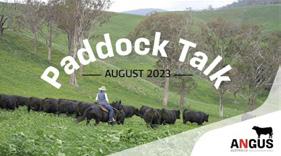
THE STOCK AGENT’S TOOLKIT
The Stock Agent’s Toolkit is the one stop shop for stock agents to find all the right information to help find the right Angus sires for their clients this breeding season. The Stock Agents toolkit provides written and video educational content for stock agents to give you the most up to date information available when having conversations about genetic and breeding decisions with your clients.
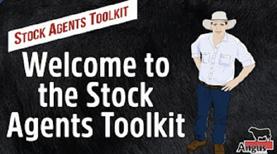
4
PADDOCK TALK –AUGUST 2023
Presidents Report

Erica Halliday, Angus Australia
I write this as Scott Wright and I fly across the rugged red country of inland Australia on our way to the World Angus Secretariate in Prague, Czech Republic, where we are set to meet with other Angus organisations across the world to discuss “Angus” and global beef issues.

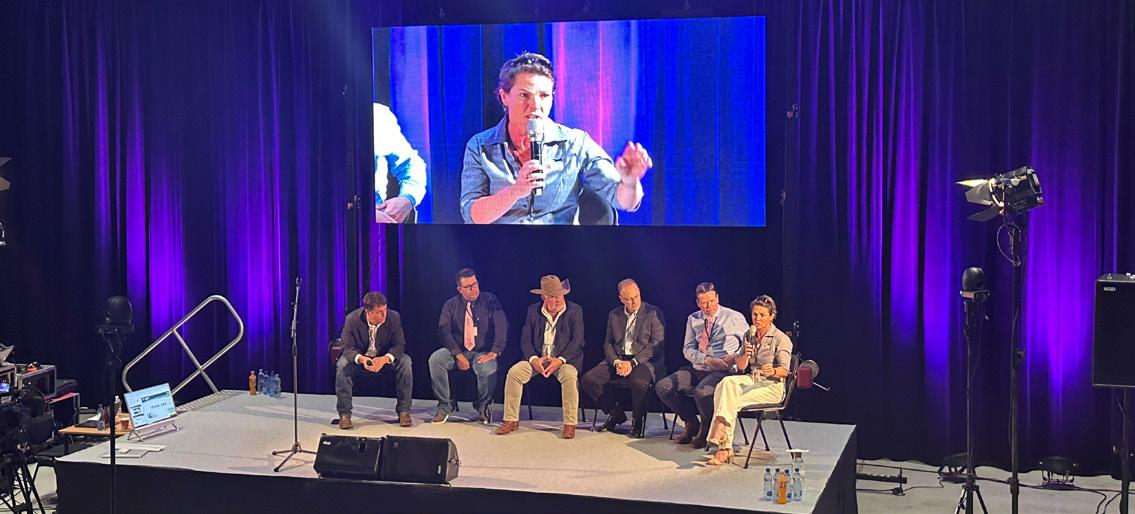
As we fly over the dry vastness it never ceases to amaze me how unique, exceptional, and maybe just a little bit crazy we are to try and collar this country and tame it to produce some of the best beef in the world.
And this is exactly the message that we will send to the world during our time in Prague as we invite them down under for the World Angus Forum in May 2025How we grow some of the best beef in the world under some of the harshest conditions, and how we are striving to do that by 2030 and be carbon neutral is inspirational. This goal helped the World Angus Forum Committee create the tag line of “Beef for a Better planet” and outlines how we think beef can actually be part of the solution. There is a genetic component to beef being part of the solution and the role that Angus Australia has to play in funding and motivating research to uncover and identify the genetic differences in the population for carbon emissions is an example of its role in educating and providing tools for producers to ultimately increase profitability. This is just a small piece in the puzzle of how beef can be part of the solution, but it’s one that we have control of and is symbiotic with work of other stakeholders in the beef industry working to the same goal.

Decreasing emissions genetically is important but the world also needs a way of reversing the effect of climate change. Cattle and other ruminants already play an important role in both eating, crushing and

then fertilising grass so that it can up its rate of photosynthesis, to act like a huge natural pump to get the motherload of carbon dioxide out of the atmosphere and back in the soil where it belongs.
As if the humble cow isn’t hero enough for that contribution, she also takes that grass (which is earths most abundant plant form inedible by humans) and she upgrades it into the most nutrient dense form of protein available to humans on the planet. Someone give that girl a medal!
Now that’s the average cow. If you swapped her for, say an Angus cow genetically engineered for lower emission to start with and packed with superior performance and carcase, then she not only needs a medal but a Nobel Prize. How is this not a great story?? And how come most of the world don’t know about it??... Yet…
If you put all of this in context with the current state of play in regard to the EYCI, El Nino, Dipole, disease and politics then you realise how important and urgent it is that the real story about our humble cow is both celebrated and communicated. On behalf of the Board, I would like to thank the staff of Angus Australia for the incredible service and support that they have shown members during the very busy Spring sales period. This is a special group of people who have worked long hours to tackle a huge increase in workload in DNA and catalogue services and I know how they have given their all. We are very appreciative.
We, as a Board, are always working with the CEO Scott Wright and management to make sure that we have a proper resource of staff to service you, our members, but please understand it is difficult to predict the workload, particularly as some sectors of the business are rapidly growing. The staff have really risen to this task lately and I would like to take this opportunity to thank them and also thank the members who have gone out of their way to show their appreciation.
Wishing everyone a flush Spring, Erica
| 5 The Angus Bulletin - Spring 2023
Erica joined an open panel discussion at the World Angus Secretariat
IT’S A SIGN OF BETTER PRODUCTIVITY AND ANIMAL HEALTH
‘Immune Ready’ is a guideline for the care of sale cattle. It helps protect cattle in the preparation, transport and arrival post sale.
FOR BUYERS
It reduces the risk of disease in purchased cattle
It improves farm biosecurity

It improves animal health and welfare
FOR SELLERS
It prepares your cattle for potential disease challenges
It allows you to promote and sell premium cattle

It helps safeguard against disease and improve productivity
Learn more about Immune Ready Guidelines
ENDORSED BY
CEO Report September 2023
Scott Wright, Chief Executive Officer
As we draw into spring, we are very aware of the increasing anxiety that members feel regarding the seasonal outlook. Market forces have paired with dry conditions to create an extremely challenging spring ahead.
Please be assured that if any member has difficult situations, our staff are here to help. Despite many pressures, I have been pleased to watch records fall again and generally see members experience high clearances. Congratulations to Texas Angus for their new Australian record!
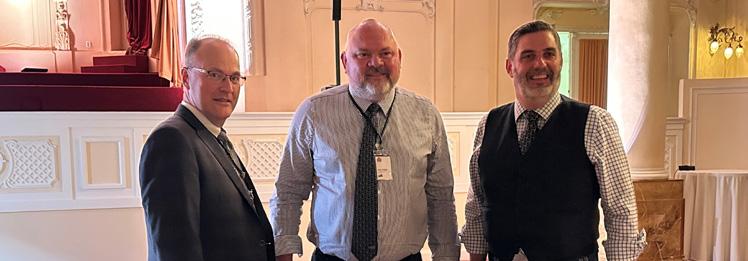
I’m pleased to report that our society continues to be in excellent shape. Financially we are ahead of our budgeted position largely through the growth in volume of our core services - inventory climbed again by 5% this year to approximately 145,000 females. Registrations in the first two quarters rose by 6.3% and DNA testing continues to increase with genomic profiles increasing by 39%. We are also experiencing strong growth in export certification of Angus heifers in the south on the back of lower cattle prices. Our breed continues to excel with a new record level of genetic gain$7.69 per cow mated per year. We look forward to new angus.techplatforms to be rolled out later this year.
Members will have noticed the announcement of the World Angus Forum (WAF) in May 2025. Planning is well underway with our very capable committee, under the leadership of our Chair Erica Halliday and the WAF Coordinator Nicky Wallace. The World Angus Forum to be hosted by Australia will be a huge opportunity for our Australian members to market genetics to a worldwide audience. This is almost a once in a generation opportunity. I encourage all members to plan towards the various activities and to sign up for important updates.
As I write this report, I am heading to the World Angus Secretariat meeting in the Czech Republic with our President Erica Halliday. This is an important opportunity to collaborate with the 26 various Angus member societies around the world.
By the time this report goes to print you will see some publicity regarding the World Angus Evaluation. This is an important collaboration between Angus Australia, the American Angus Association and Canadian Angus. For the first time members in the three countries will be able to benchmark sire genetics across a common periodic analysis. We see this as an important first step in not only allowing our members to purchase genetics from north America with higher confidence, but also a vehicle to allow our Australian genetics to be exported with greater confidence.
As a side note, one of our New Zealand members is the World Angus Secretary General, Tim Britain. Tim is a highly experienced breeder and is an excellent resource in assisting in planning our 2025 World Angus Forum. Some members will have seen commentary in the media regarding a proposal from the Australian Meat Industry Council (AMIC) to request the Angus breed content for the breed content of Angus meat to be changed from 75% to 50% by the Australia Meat Industry Language and Standards Committee (AMILSC). AMILSC comprises of industry representatives and controls trade descriptions and the AusMeat National Accreditation Standards in Australia. Angus Australia has submitted a position that we would be in favour of the breed content remaining at 75%. Our members, board and staff are awaiting the outcome of this decision and to our knowledge at the time of writing no change has yet been made.
You will notice some recent staff changes, to which there there have been two key appointments. Firstly Elliott Connors has been appointed Angus Australia Accountant and secondly Liam Mowbray has been appointed Research & Development Specialist. Both appointments have been a delight to me, and both candidates are exceptional. Elliott is a Red Angus breeder with a wealth of experience in practice accounting. I am sure the membership will really value his communication style, diligence, and knowledge of seedstock businesses.
Liam is a qualified Vet and has come up through our Angus Youth program. He also has a wealth of experience and great passion for the Angus breed. It is important to note that both appointments are replacements of personnel who have left Angus Australia.

In August our Board of Directors met again to discuss a range of important issues. Particularly this meeting we discussed the upcoming proposed World Angus Evaluation, the Angus breed content issue, implementation of the Strategic Plan, changes to financial reporting which are coupled with the appointment of a new Accountant and a range of governance issues. The Board welcomed Elliott Connors to his first Board meeting.
I would like to take this opportunity to thank all our very diligent staff who have largely handled all of the increased workload without extra resources being employed. Also, I would like to thank the Board of Directors for their continued and heartfelt support in my role as CEO.
As we look forward and start to introduce our 5-year Strategic Plan, I am overwhelmed by the confidence in the breed for future growth. Thank you for all the messages, phone calls and conversations and for widespread support from the general membership. As always, please contact me at any time.
Yours sincerely,
Scott Wright
| 7 The Angus Bulletin - Spring 2023
Top: American Angus CEO Mark McCulley, Angus Australia CEO Scott Wright and UK Angus CEO Robert McGilchrist, Bottom: Scott speaking at World Angus Secretariat
The World Angus Forum is coming in 2025!
Cheyne Twist, Senior Marketing & Communications Officer
The World Angus Forum is coming to Brisbane, Australia on the 7th – 8th May 2025! Cattle breeders, Angus enthusiasts, and beef industry professionals from every corner of the globe are invited to converge in Australia for this extraordinary event.
Following the cancellation of the World Angus Forum in 2021, we have bounced back, and are more excited than ever to be bringing the World Angus Forum 2025 to the world.
With a theme of ‘Beef for a Better Planet’, join Angus Australia for a global celebration of Angus and an insight into the latest technology, genetics and innovation.
The event will showcase the highest quality beef run sustainably in some of the harshest environments and explore the concepts and challenges of the Australian Beef Industry’s quest for Carbon Neutral 2030.
“As CEO, and on behalf of the Organising Committee of the World Angus Forum 2025, it is our great pleasure to invite you to attend World Angus Forum 2025,” said Angus Australia Chief Executive Officer Scott Wright.
“The World Angus Forum provides a unique opportunity for Angus breeders and industry professionals to come together to learn from one another and to share their passion for this iconic breed. It also plays an important role in promoting the Angus breed globally and in advancing the knowledge and understanding of cattle breeding and management.”
“Preparations are well under way to deliver an educational and informative event that brings together leading experts and advocates in a broad range of fields, as well as the opportunity to experience Australia with its unique wildlife and environment.”
“After the huge success of the World Angus Forum in Australia in 1997, Angus Australia is honoured to again be hosting the event in 2025.”

An exciting program is being developed, including an initial reception on the Harbour in Sydney, followed by a preforum tour with farm visits and tourist destinations on the itinerary.
The tour will see delegates land in Tamworth for what is anticipated to be the largest gathering of Angus cattle in Australia, as we host a two-day Angus Expo at the Australian Equine and Livestock Events Centre (AELEC). Returning for 2025 will also be the highly anticipated World Angus Forum Youth Competition.
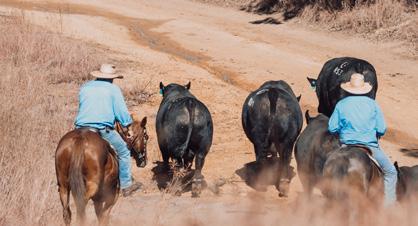

“Come and see the finest genetics grown in the harshest environments and how we do it. Come and see the harbour, the reef, the rock,” said Angus Australia President and Board Chairperson Erica Halliday.
“But more importantly, our stud and commercial industry, the Australian beef industry, which aims to be carbon neutral by 2030. Come and see how we think we can do it and why we think that beef can be part of the solution.”
From Tamworth the tour will continue north and finish up in Brisbane for the official World Angus Forum event, where speakers who are experts in their field will be invited to present at the Brisbane Entertainment and Convention Centre.

For more information, please contact Angus Australia CEO Scott Wright at scott. wright@angusaustralia.com.au or on (02)
67734600 or Angus Australia World Angus Forum Coordinator Nicky Wallace at nicky.wallace@angusaustralia.com.au or on (02) 6773 4616.

For more information visit the World Angus Forum 2025 Website and make sure you are following World Angus Forum 2025 on Facebook, Instagram and Twitter.

8
to stay up to
View
Subscribe
date
website
Top left to bottom right:
Erica Halliday (Chair)

Ben Hill
Julian Maul
Rob Onley
Warren Salter
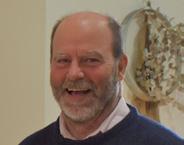
Wendy Mayne
Marg Will
Scott Wright CEO Angus Australia


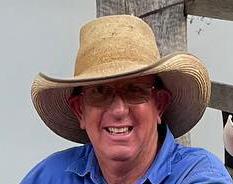

Diana Wood Marketing & Communications Manager
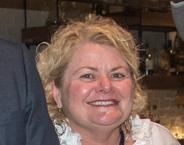


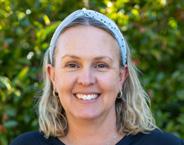
Angus Australia




Nicky Wallace World Angus Forum Coordinator
The 2025 World Angus Forum Organising Committee
The role of the World Angus Forum Organising Committee is to provide guidance and assistance to Angus Australia in planning, promoting and conducting the 2025 World Angus Forum in Australia.
| 9 The Angus Bulletin - Spring 2023
LOT 7 MEANDARRA SALE Carabar Beast Mode S283 CARABAR BULL SALES Contact: Darren Hegarty 0428 748 542 carabarangus1@bigpond.com CARABAR MEANDARRA 22 September 2023, 1pm BLACKALL SALEYARDS 24 October 2023, 10am · 50 Bulls ·
9 BLACKALL SALE Carabar Gunsmoke T133
LOT
‘Thunderstruck’ with Bull Sales
Diana Wood Marketing & Communications Manager
While bull sales across the board generally have come back on clearances and averages due to the current market and weather outlook, there have still been some phenomenal results achieved across the country so far in 2023.
Leading the charge was Texas Angus, where a new national all breeds record for a bull sold at auction was broken when Texas Thunderstruck T383 was knocked down for $360,000 at the Texas Angus Bull Sale.
The twelve-month-old son of Poss Rawhide was purchased by Robert Mackenzie, from Macka’s Angus, Salt Ash NSW.
The vendors, Ben and Wendy Mayne described Thunderstruck in their catalogue as ‘something very special’.
‘The style and stature of this young sire is something you have to see for yourself. Presence, power, performance and profitability is the perfect way to describe this up-and-coming young Angus sire with a wonderful balance of all traits.’
The all breeds record was previously set in 2017 for Brahman bull NCC Justified, who sold for $325,000.
The record for an Angus bull sold at auction was last broken in 2021 when Millah Murrah Rocket Man R38 was sold for $280,000 to Brooklana Angus at the Millah Murrah Angus Bull Sale.
This result also surpasses the record for a yearling Angus bull sold at auction, which had also been set at the 2021 Millah Murrah Angus Bull Sale, with Millah Murrah Rolls Royce R275 selling for $110,000 to Heart Angus & Hallmark Angus (NZ).
The overall result for Texas saw them sell 252 bulls for a complete clearance, with an average of $16,764 and a gross of $4,224,500.
As well as the Texas sale, another eight bulls Angus bull have reached six figures in 2023.


During the Autumn selling season, bulls from Victoria, Tasmania and Western Australia all achieved this feat.

At the Te Mania Angus Bull Sale Autumn, $110,000 was paid for Te Mania Saville S258 by a four-member syndicate made up of Clunie Range Angus, Coolatai, NSW; Mandayen Angus, Keith, SA; Bongongo Angus, Coolac, NSW; and Buringal Grazing Company, Nundle, NSW. Overall, Te Mania cleared 160 bulls for a $15,075 average.
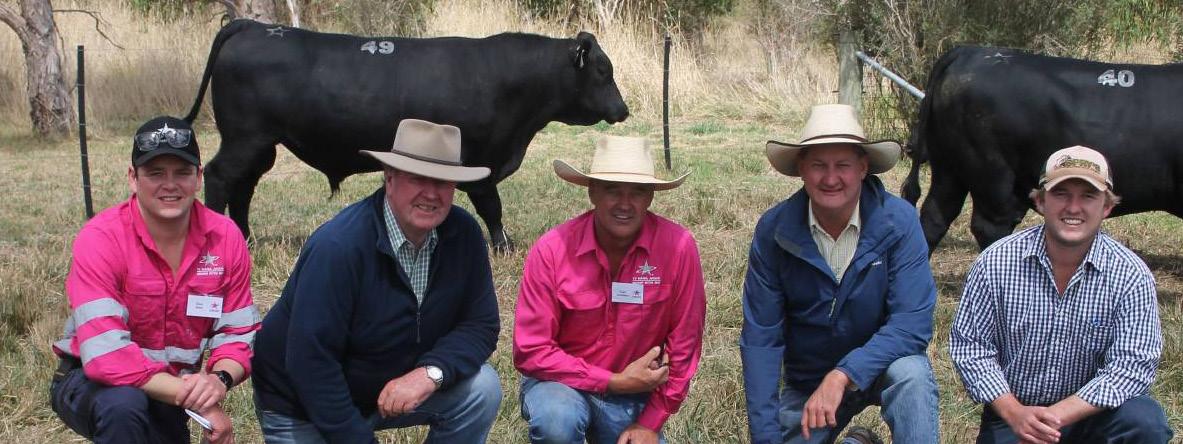
A top of $240,000 was achieved at the Landfall Angus Bull Sale with Dunoon Angus stud, Holbrook, NSW, making
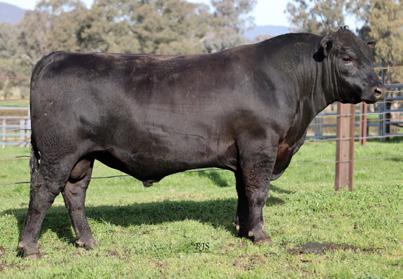
10
G B C A
Texas Thunderstruck T383
the outlay for Landfall Signature S1755. Landfall sold a total of 230 bulls for a $14,648 average.
Coonamble Angus Bull Sale sold Coonamble Show Time S42 for $106,000, to a syndicate made up of the Della Gola family, Tonebridge Grazing, Tonebridge WA, the Torrisi family, Black Market stud, Donnybrook WA and Julian Walter, Cherylton Angus stud, Brookhampton WA, who have equal walking rights to the bull, while the Kupsch family, Black Tara stud, Allanooka WA, have a semen share.

Coonamble sold a total of 126 bulls for an average of $18,262.

After purchasing the high price bull at Landfall, Dunoon Angus saw success at their Spring Bull Sale with Dunoon Data Plus S603 hitting $125,000 when purchased by Spry’s Angus, Holbrook NSW and Cottage Creek Angus, Tarcutta NSW. Dunoon sold 128 bulls for an average of $14,527.
Millah Murrah Angus hit six figures twice, with $200,000 paid for Millah Murrah Santiago S304, when purchased by


Couch Pastoral, Nulawarree, VIC, and ABS Australia, Burdoora, VIC and $180,000 was paid for Millah Murrah Trigger T308 when he was purchased for by ABS Australia as part of a syndicate, including Rosemount Pastoral, Newbridge NSW, and Peter Mowbray, Wollongong, NSW. Overall, 121 bulls sold to an average of $24,645.

The following day Milwillah Angus had a bull, Milwillah Pheasantry T352 make $200,000 when purchased by Glendan Park, Redesdale, VIC, while Milwillah Sergeant S791, sold for $190,000 Bannaby Angus, Taralga NSW. All up Milwillah sold 98 bulls for an average of $23,566.
In terms of averages, Knowla Livestock currently has the highest average for the year with 80 bulls clearing for an average of $25,613 at their sale.
And just as the Spring Bulletin went to print, Pathfinder Proceed T756 was sold for $136,000 by Pathfinder Angus at their Queensland sale at Roma, when he was purchased by Burnett Angus, Westbury Tasmania. Overall 92 bulls were sold for an average of $9,532.

| 11 The Angus Bulletin - Spring 2023
Phone: 07 4630 2722 Email: info@farmersbreedingsupplies.com.au Shaun Fogg: 0408 884 092 Address: PO Box 7633, Toowoomba South, Qld, 4350 Tomorrow’s Bovine Genetics Delivered Today FBS2855 ©trishbiggsgraphicdesign.com.au • Liquid Nitrogen • On Farm Delivery Service • Beef & Dairy Semen Sales • Semen & Embryo Transport • Semen & Embryo Storage • Artificial Breeding Supplies • Liquid Nitrogen Containers (New & Second Hand)
D H E F
A: Texas Thunderstruck T383, B: Coonamble Showtime S42, C: Dunoon Data Plus S603 Image: BJS Livestock Photography, D: Murrah Santiago S304, E: Millah Murrah Trigger T308, F: Pathfinder Proceed T756, G: Te Mania farm manager Sam Reid, Independent Breeding & Marketing Service director Dick Whale, Te Mania co-director Tom Gubbins, Geoff Hayes, Ray White Rural Glen Innes and Ryan Schmitt, Buringal Grazing, Nundle, NSW with top priced bull Lot 49, Saville S258. Image: Stock and Land, H: Landfall Signature S1755 with Chris Saunders, auctioneer Warren Johnston, and Landfall Angus stud principals Frank and Ed Archer. Picture by Nutrien Ag Solutions Tasmania
Owned by Brooklana Angus Fletch Kelly - 0419 383 341 Annie Pumpa - 0458 227 277 Kim Hodder - 0438 418 113 Beef Sales & Ser vices


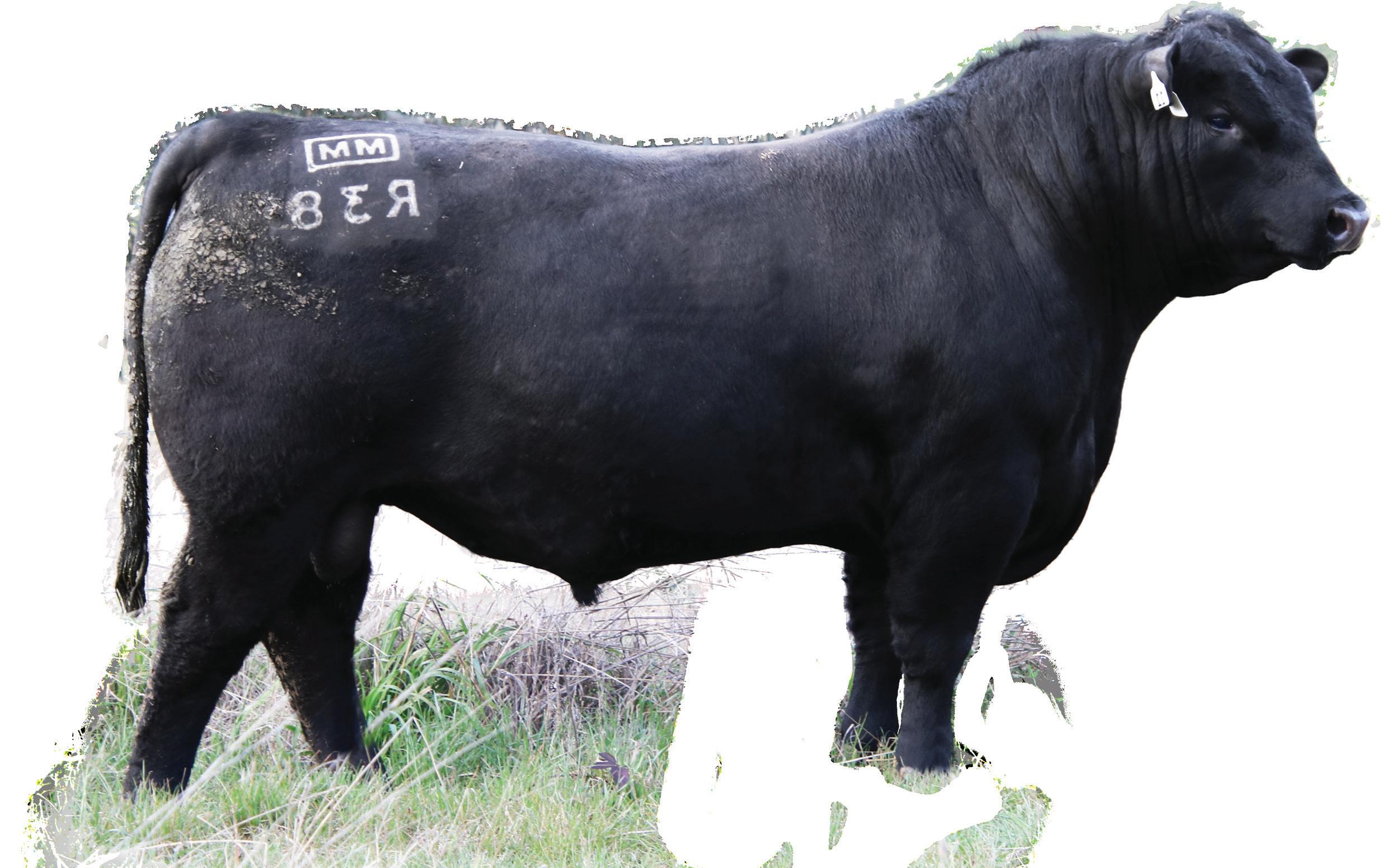
ROCKET MAN

Millah Murrah Rocket Man R38 29AN2241
A structurally outstanding bull so wide and correct from his muzzle, over the chine and all the way through to his hips & pins
Possesses so much sheer volume, capacity and sire appeal
+ + + CE-DT GL BW 200D 400D 600D MCW Milk DTC SS Carcase Structural Selection Index Feed E iciency CWT EMA RIB Rump IMF% RBY% NFI-F DOC Angle Claw $A $A-L EBV Perc +95 2 +5.2 62 +0.2 43 +0.7 31 +0.0 77 +1.6 64 +0.29 64 +0.84 5 +0.74 7 +0.80 40 $250 6 $450 1
Son: Millah Murrah Thunderman T24
Top 12% calving ease, powerful top 10% growth and big carcass weight Mid July 2023 TransTasman Angus Ca le Evaluation Calving Ease Growth Fertility CE-DIR EBV +7.6 12 +7.5 9 -6.1 28 +5.2 74 +65 4 +119 2 +146 6 +133 9 +16 59 -5.7 23 +2.6 29 Perc
Son: Millah Murrah Thunderman T10
Beef up your knowledge of R&D at the Efficient Beef Open Day
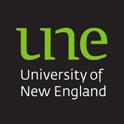
 Cheyne Twist, Senior Marketing & Communications Officer
Cheyne Twist, Senior Marketing & Communications Officer
It’s time to save the date for the Efficient Beef Open Day! Highlighting the latest in research and development coming out a number of ongoing research projects, the Efficient Beef Open Day will be hosted Wednesday November 22nd at the UNE Smart Farms Tullimba Feedlot.
Angus Australia members are invited to attend the event, which will be hosted in conjunction with University of New England (UNE) and the Department of Primary Industries (DPI) and will feature updates and developments from the Angus Sire Benchmarking Program, the Low Methane Beef Program, the Southern Multibreed Project and will include an opportunity to view the ASBP Cohort 12 steers.
Angus Australia R&D Specialist Dr Liam Mowbray encourages anyone with an interest in getting an up-to-date overview of the various research projects currently being conducted by Angus Australia and its partners to attend the Open Day.
“With various presentations throughout the day from R&D specialists, the field day will provide an opportunity for attendees to learn about the latest research developments from this industry collaboration,” said Dr Mowbray.
“The Efficient Beef Open Day showcases how Angus Australia members, through Angus Australia, actively contribute to industry relevant and world leading research and development into genetic improvements, methods and tools aimed at boosting herd productivity and efficiency.”


For further information regarding the Efficient Beef Open Day please contact

0436 406 140 or at liam.mowbray@angusaustralia.com.au.




NDEco VERTICAL FEEDMIXERS
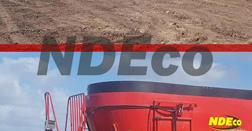
The NDE will cut hay bales of any shape and size right in the mixer. Then blend in your grains and concentrates quickly and thoroughly for a totally mixed ration. 10 to 32 cubic metre models.



| 13 The Angus Bulletin - Spring 2023
MUCK SPREADERS 12”, 24”, 36” & 48” Models ROLLER MILLS - 12”, 24”, 36” & 48” models* Dynamically Balanced 16” Rollers * Up to 54 tonne per hour Capacity * Dry and High Moisture Rolling Chill Cast Rolls - PTO Drive Folding Discharge Auger
the Angus Australia R&D Specialist Dr Liam Mowbray on
Australian Distributor: EASTERN SPREADERS PTY LTD Ph: 03 5450 3077 Mob: 0409 691 226 9508 Murray Valley Highway, KERANG, Vic. 3579 easternspreaders.com.au Eastern States Distributor for MARSHALL MULTISPREAD 2.5 to 16 tonne Australia’s most popular and versatile fertilizer spreader
Are
Questions to consider:
Are all devices created equal?
Is there a 'right dose' of progesterone?

When do you use a low dose device?
How do retention rates differ?
Can you re-use a device?
Which device is the most environmentally friendly?

14 Repro360 Help Line: 1800 032 355 | Repro360.com.au Cue-Mate® is a registered trademarks of Vetoquinol.
you using the right progesterone device?
Cue-Mate® RTU (cows) 1.56g progesterone Reload pods (heifers) 0.78g progesterone
Meat & Livestock Australia’s BredWell FedWell Workshops
Diana Wood Marketing & Communications Manager
Want to find out about breeding and feeding to maximise profit?
Meat & Livestock Australia’s BredWell FedWell workshops are full day interactive workshops to explore breeding and feeding strategies designed to maximise profitability.


Join us on for a BredWell FedWell workshops to:
Develop a customised breeding plan for your livestock enterprise aligned to your profit drivers


Identify sires and select animals using breeding values that help you meet your objectives
Learn about feeding animals well to achieve your objective and maximise your genetic investment Register for one of the following workshops:
Workshop Date: 17 October 2023
When: 8:30am for 9am–4:30pm
Where: “Diamond Tree Farm”, 489 Eastbourne Road, Diamond Tree WA 6258
Hosted by:
Lex & Kim Gandy, Gandy Angus
Registration fee inc GST –Introductory price: $200 per person Register online by: 3 October 2023
Workshop Date: 8 November 2023
When: 8:30am for 9am–4:30pm
Where: “South Killanoola”, 113 South Killanoola Road, Bool Lagoon SA 5721
Hosted by: Dean and Jenny Eastwood, CC Seymour & Co
Registration fee inc GST –Introductory price: $200 per person Register online by: 25 October 2023
Workshop Date: 17 November 2023
When: 8:30am for 9am–4:30pm
Where: “Bottlesford”, 95 Hobbs Road Tungkillo SA 5236
Hosted by: Darren Koopman, Bottlesford Angus
Registration fee inc GST –Introductory price: $200 per person Register online by: 3 November 2023


www.mla.com.au/bredwellfedwell

| 15 The Angus Bulletin - Spring 2023
The workshops will be delivered by Angus Australia’s Extension Manager, Jake Phillips. For more information on MLA’s BredWell FedWell Workshops
How a modern farming enterprise operates
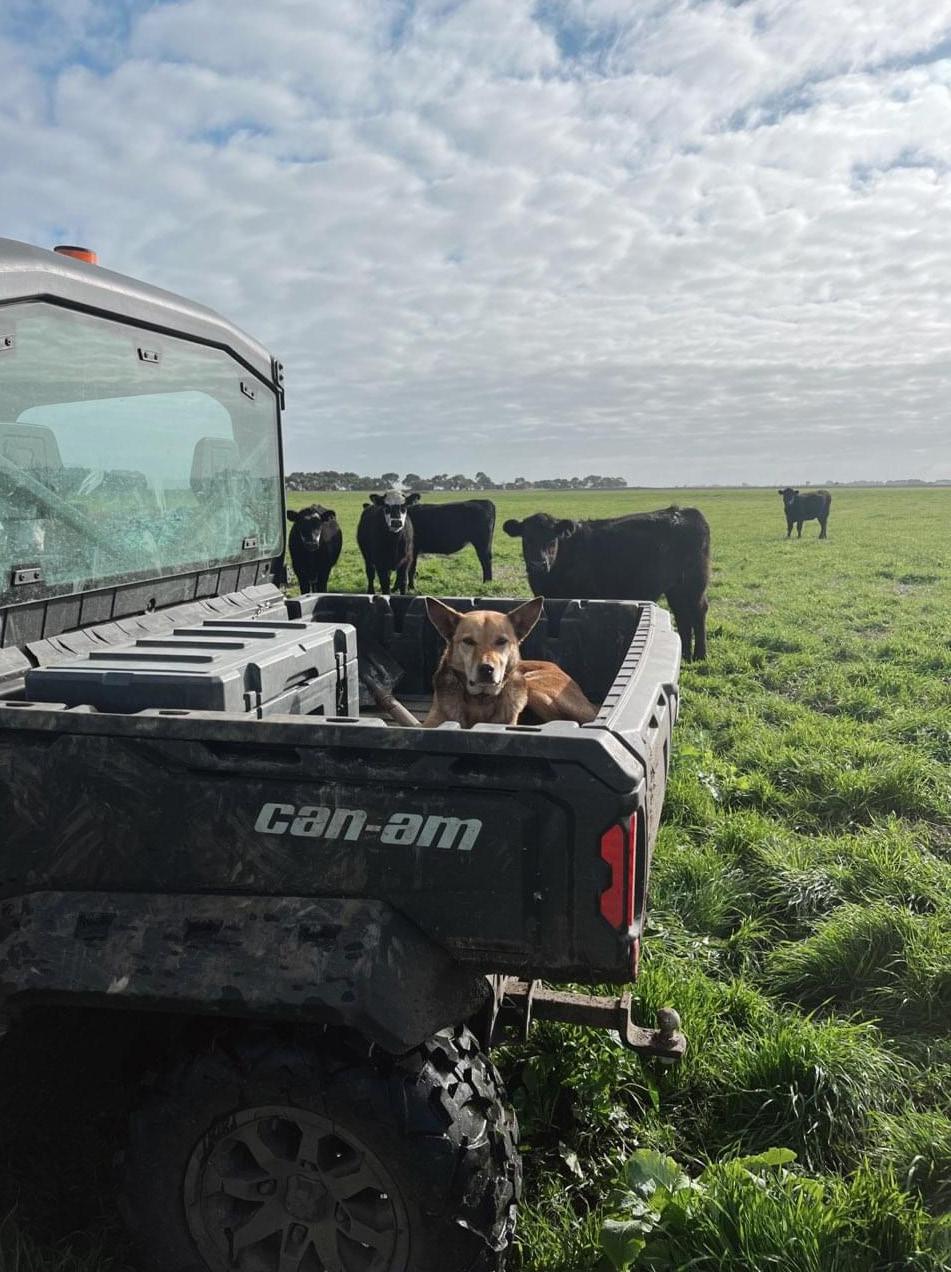 Cheyne Twist, Senior Marketing and Communications Manager
Cheyne Twist, Senior Marketing and Communications Manager
Three enterprises make up the modern and diverse operation of South Killanoola, located south of Naracoorte, SA. From the people they involve in the operation, to the breeding objectives they set, land management practices and family succession, South Killanoola provides a practical example of a large-scale operation putting management practices in to place to ensure they have a viable future.
Owned and operated by CC Seymour & Co, the Seymour family have had the holding of the land that South Killanoola resides on since 1847.
16
Current principles Robert and Digby Seymour continue the generational progression of the operation and run the business alongside Manager Dean Eastwood, and his wife Jenny, who heads the business administration and compliance for the operation.
With their team, South Killanoola runs three enterprises interchangeably across approximately 3,000 hectares. The three enterprises are made up of a cropping business of wheat, beans, canola, and small seeds production run over 800 hectares, a beef business of over 900 cows and a sheep operation of approximately 7,600 composite ewes. South Killanoola is also home to Australia’s oldest registered Hampshire Downs sheep stud.
“We are unashamedly a protein-based business and that's where we see our future,” said Manager Dean Eastwood. “We're not wool producers, as it's just a byproduct that we deal with but we're about producing meat.”
On the diversity of their business model however, having the benefit of the three operations means that risk can be reduced when there are areas of unproductiveness in one of enterprises.
“In 2017 we had a very wet winter and we lost 250 hectares of effective grazing area and 200 hectares of crop,” said Mr Eastwood. “By being in three different operations we're reducing our risk and that's a really good example of when we lost a lot of crops, it was okay because we also had other operations that could support that cropping operation.”
To achieve the best from their operations, CC Seymour & Co places an emphasis of employing specialised personnel to enhance their operations.
Highlighting this philosophy is Digby Seymour, who returned to the South Killanoola operation after a career in aviation, which saw him based off the property.
“For me coming in from an outside profession to come back onto the farm I can identify skills. I know that I can't compete with someone who's been working full-time as a manager and it's just good business to have the best person doing the best job,” he said.
An example of this specialised business acumen is the employment of a private agronomist, a sheep advisor, a cattle advisor and vet and an accountant who assists the team in decision making relating to their various areas of enterprise. “Our job is to take on board their advice and use it where we think it can work within our business,” said Mr Eastwood. “At the end of the day they're the advisors and we're the managers of the business.”
“I then ask Jenny every year to give me a report for what every one of those individual advisors has cost for the year and just make some decisions as to whether I think they've given us a fair return on investment.”
South Killanoola is made up of a Phalaris and Sub-Clover based pasture. The pastures are on a rotation that also utilises Brassica crops and annual rye grasses.

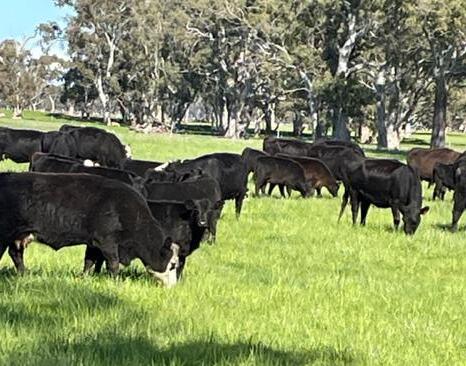
The cattle side of the business is made up of a combination of Angus and Hereford genetics. Historically a Hereford herd, the cattle enterprise is now predominately Angus and is made up of purebred Angus cows, black baldy cows and Hereford cows.


“We have over 600 black cows and why we have chosen Angus is a combination of market access, which is probably the biggest one at the moment, and better returns,” said Mr Eastwood.

Using an Artificial Insemination program (AI) the team join in May for a midFebruary six week calving period. The cow herd begins calving in March, again for the six-week period.
With this program, heifers are due each year to calve down a month before their cow counterparts.
“Initially we did it as a labour saving as we thought that by condensing the calving we could save time in checking heifers,” said Dean Eastwood. “It probably hasn't worked out that way as with using shorter gestation length bulls our heifers start calving about ten days ahead of their start date anyway, but we've kept it going because it just gives a heifer more opportunity to get back in calf.”
He continued, “We're putting better genetics into the herd, and we can actually manipulate food a bit better, as we know we've got X number of heifers calving very early and then we'll have a break until the next batch.”
When selecting bulls for use in their AI program, based on Estimated Breeding Values (EBVs) CC Seymour & Co seeks bulls that are in the top 10% for 400-day weight, 600-day weight, are low birth weight, and have negative gestation length figures. Mr Eastwood noted that on occasion, bull progeny produced from the AI program are retained by the team and later utilised as sires in small portions of the herd.
For the bulls utilised in their cow herd joinings, the company looks for bulls that are in the top 20% for 400-day weight, are breed average for 600-day weight, breed average for milk, have positive EBVs for rib and rump fat and are breed average for Intermuscular Fat (IMF), capping their birthweight figures at 5 – 5.5. Additional to their EBVs, the team ensures that the bull is structurally correct before making selection decisions.
| 17 The Angus Bulletin - Spring 2023
“We're looking for bulls that have got good feet, good temperament, they are balanced in shape, they are athletic, and they are soft skinned,” said Mr Eastwood.
“I was once given advice from an Angus breeder that you really should select bulls with maternal traits as a priority over traits that are directly effective to the profitability of your steers, otherwise you could end up with a herd of cows looking like a mob of steers,” said Mr Eastwood, “We hold that pretty true still today in how we look at our traits for our females and how we manage the whole operation.”
“Something that is probably slightly controversial is that we test all our bulls for semen morphology, and we will cull bulls that fail two tests on a vet’s recommendation.”
South Killanoola breeds with the objective of producing a moderate framed cow, that gets back in calf each year, doesn’t require excessive feed and ideally produces a 280kg+ weaner.


The enterprise retains 90 – 95% of the heifers produced, under the philosophy that the tail end of the drafts each year will be determined at joining. Furthermore, Mr Eastwood highlights that through retaining the majority of their heifers each year, they have the privilege of option in numbers,
come stocking new land acquisitions or if there is the desire to build the herd.
At calving, animals that are not rearing a calf or failed to produce a calf are culled from the mob.

Producing weaners for sale, the enterprise typically sells the majority of their weaner calves from November through to January. In the mix of the businesses, parts of the cropping enterprise are utilized as fodder for grazing from January to June, before locking them up and taking them through to harvest as a grain crop.
On top of the existing diversity of the business, CC Seymour & Co also have a Dung Beetle program, with which they have seen benefits of the beetles in the natural soils of the property, and in the effect of worms, assisting them in reduced costs relating to the drenching of their stock.
Environmentally, South Killanoola has been challenged by factors that have led to the continued development of the business. With four different soil types across the property, Mr Eastwood identifies that the threat posed by black cracking clays over limestone has challenged them and has led to cropping being utilized in those areas. Furthermore, as touched on earlier, high rainfall in the area has provided areas of
PASSIONATE ABOUT ANGUS
If
Contact Bronson McLay, livestock manager, on 0408
or (07)
WE’RE
In fact it’s the only cattle we feed! That demonstrates the confidence we have in the breed and those that breed them.
Angus cattle is your passion then we’d love to work with you.
774 165
4650 9177.
“ “
To achieve the best from their operations, CC Seymour & Co places an emphasis of employing specialised personnel to enhance their operations
loss for the business, particularly through their cropping business.
Within their company, Mr Eastwood identifies that staffing the operations has been an ongoing challenge for the business, and the team emphasises the value that they place on finding staff that may not necessarily have a developed preexposure to the industry, however, display a willingness and ready attitude to learn and grow.


Looking to the future, the team at CC Seymour & Co are working consciously to develop their business to be a more efficient and sustainable model through continued expansion.
“Planning towards 2030, we're preparing for a carbon market and where that's going to take us and how that will affect our business,” said Mr Eastwood. “We'll continue to improve our facilities to both retain and attract staff, obviously comply with our OHS requirements and also meet our animal welfare requirements.”
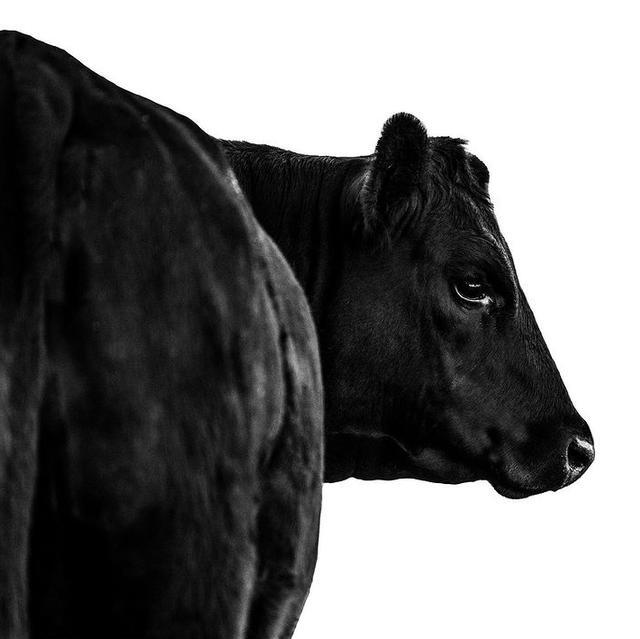
“We will continue our pasture renovation program; this is allowing us to increase our stocking rate and not have such a reliance on supplementary fodder as animals always do best on grass. It also allows to grow the business without having to obtain extra capital to purchase more land.”



He continued, “Over the last six years we've added approximately 570 hectares to South Killanoola, so paying down and reducing debt for the Seymour’s is very important, and this is because if the opportunity of something coming along that we want to buy and grow again we've got the ability to do it.”


“We are also going to look to expand our irrigation and that'll lower risk by either diversifying crops, providing more fodder for stock or right now we are looking at a different one which is hemp for fibre production.”
He concluded, “We by no means are doing everything well and properly but we are continually trying to improve and challenge ourselves. All involved with South Killanoola love agriculture, and this is what has made us successful up till now, and what will take us into the future.”
| 19 The Angus Bulletin - Spring 2023 THE INDUSTRY STANDARD NOW HAS HIGHER STANDARDS. Next Generation Genetic Testing For Best Generation Angus. FOR ANGUS. BY ANGUS. S c a n t h e Q R c o d e t o c o n n e c t a n d d i s c o v e r m o r e T E S T W I T H N E O G E N T O D A Y !
Dean Eastwood
SCAN TO WATCH
Dean’s presentation at the Zoetis Angus National Conference
Breed Versatility Positioning: Why do Angus work for you?
Cheyne Twist, Senior Marketing & Communications Officer
When discussing the versatility of the Angus breed, the people who can attest to it the best are those utilising the breed in varied environments and systems around the country and abroad.
During the Zoetis Angus National Conference, those in attendance got just that, with a panel of breeders sharing their insights regarding the use of Angus genetics in their operations located around Australia and New Zealand.

Chris Metcalfe, Western Australia, Frank Archer, Tasmania, Noeleen Branson, Victoria, Heath Tiller, South Australia, Nick Boshammer, Queensland, James Laurie, New South Wales and Forbes Cameron, New Zealand all joined panel facilitator Scott Wright to discuss their experiences utilising Angus genetics in their various operations.
Representing many different pockets of the Australian and New Zealand landscape, the panel allowed for the different perspectives of breeding cattle within a variation of environments and production goals.
Angus cattle that suit
For Forbes Cameron, the cattle he produces must be able to withstand the conditions in which they are being bred in New Zealand, which can be challenging for the animals.
Firstly, the environment of the country where the Cameron’s farm is located on the North Island of New Zealand is incredibly hilly and steep. When first populating his property with Angus cattle, the landscape proved challenging for the stock, and those that handled the
conditions where the lines that continued to build the herd and have adapted to the conditions they are bred in.
“When we started there was quite a few Angus dispersal sales in New Zealand, and most Angus studs have a lot easier country then we have. If we went to a sale and bought 20 from one and 10 at another, by the end of the first year we had 50% of what we bought still alive, because most of them fell off the hills and just couldn't handle our conditions.”
In more current times Mr Cameron breeds his cattle with tough parameters to ensure they are combating challenges faced in New Zealand due to drench families. When raising his cattle, Mr Cameron ensures his cattle only require two lifetime drenches, and test for resistance to parasites in his cattle, alongside his sheep.
“The cattle that we retain, such as our bulls for sale and heifers that go in calf, they get a third drench in the lifetime. But the cattle that we're finishing at 300 to 320 kilo carcase weight at 20 to 24 months, they only ever get two drenches. Anything on our farm that needs any extra treatment are culled.”
For Noeleen Branson and her family, the choice to produce Angus cattle at Banquet Angus came from the impression the breed made when touring New Zealand. Reflecting on their experience producing cattle at their operation in the Western District of Victoria, Noeleen said,
PANEL MEMBERS
“I've been very fortunate to be involved with this breed all my life and when I was a teenager growing up, Angus cattle were referred to as the poor man's breed, so that's how I started in the industry with all that backlash, but how times have changed now.”
“When my husband Stephen and I started in our own right in 1991 we were fortunate enough to spend seven weeks in New Zealand looking at Herefords and Angus and during that time we realized we wanted to introduce the New Zealand type of Angus to Australia.”
“We noticed our market in our area in Southern Victoria was a very strongly held Hereford area and to tap into that market we needed to produce an Angus animal that consisted of a good head, a lot of bone and a lot of capacity in order for us to try and get our Angus bulls into these Hereford programs.”
20
Angus Australia CEO, Scott Wright, facilitated a breed versatility panel at the Zoetis Angus National Conference. The panel was made up of James Laurie, Nick Boshammer, Heath Tiller, Forbes Cameron, Noeleen Branson, Frank Archer & Chris Metcalfe
Chris Metcalfe Frank Archer Noeleen Branson Heath Tiller
Nick Boshammer James Laurie Forbes Cameron
“That's how we started and to this day we still enjoy what we're doing and we get a lot of pleasure in sourcing cattle all across Australia and New Zealand,” she said.
For Frank Archer, to ensure soundness of his genetics in different production systems, the Landfall operation places pressure on their herds to identify outliers that would not be suitable to their clients’ environments. In doing so, they have been able to supply cattle to most states and territories in Australia.
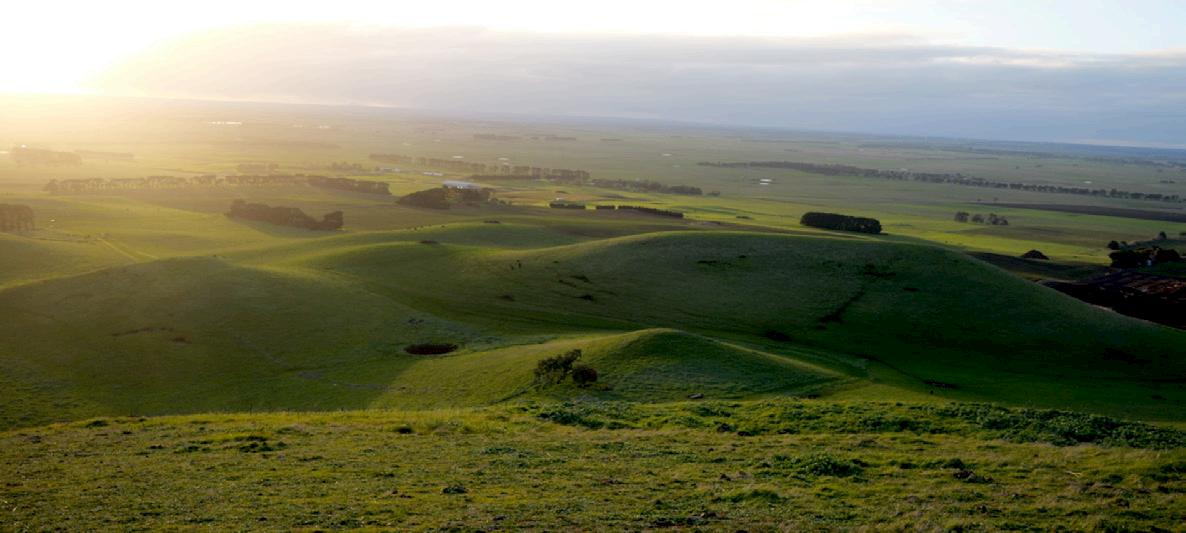
“Tasmania can be perceived to be a soft environment and it is a wonderful environment to grow cattle. We have a mild climate and a relatively high and reliable rainfall so how we manage the development of genetics in our program is through the development of a really sound production system and that production system is based on us understanding what our clients are doing with our cattle, so we create some pressure in our environment.” He continued, “We do this through running a high stocking rate, we have restricted joining periods, and we have large contemporary groups. For example, at the moment we have eight- to ten-month-olds bulls running in mobs of up to 350. The relevance of our genetics is created from the fact that there's some pressure in the system.”
“The things in Tasmania that make it a wonderful cattle environment are also some of the reasons why we can have a tougher environment, particularly in the winter with a higher rainfall and a mild climate. This means that we have a real feed deficit in the winter, so managing the winter and making sure that we can have our cattle producing also puts adequate pressure on them so we can really soundly identify the outliers on either end of the performance spectrum.”
Hailing from Western Australia, Chris Metcalfe was asked about the push of Angus genetics into the southern rangelands of the state, which can be identified as a harsh climate, and the progression of this migration for producers like himself.
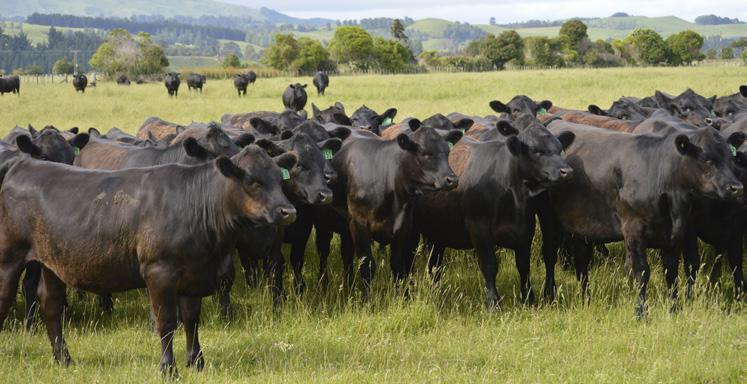
“It’s a pretty new push for both Angus and our business that we were experimenting with seedstock up into that area. The southern rangelands are around the middle of Western Australia and was traditionally heavily run with sheep and they've smashed the perennials, so basically now it's salt bushes and poor-quality grasses with a rain fall of 200mls average.”
“It's a pretty tough environment for cattle and Meat and Livestock Australia have been doing a study on it where they are trying to figure out how Angus steers go there. From our point of view, we have a client in the goldfields region near Leonora who approached us, and we started with one bull a few years ago,” he said.
“He likes a specific type and wants something with a bit more leg, with good feet and can carry itself over the salt bush
country. His target market is selling the calves into South Australia, low weight of around 200 kilos and he gets paid a premium on coat colour, so a slick coat animal is very important to him as he is getting an 80-cent premium on those slick coats.”
He continued, “So this is a new thing for us and after that one bull, we sent half a dozen the next year and then the last load we sent was 15. We're still figuring out how they go and work in his system.”
Heath Tiller, whose South Australian operation Goolagong Angus and Santa Gertrudis sells bulls around Australia, including to Central Australia pastoral zones, was asked what feedback he received regarding Angus bulls and Angus influenced bulls in the warmer, more arid climates.
“We've been selling balls up through the northern pastoral areas of Oodnadatta, William Creek and Birdsville now for a number of years and the main thing they say they've got to be able to do is walk, be able to get across a lot of the ground and have good feet. It's working very well with
| 21 The Angus Bulletin - Spring 2023
the blacks doing a tremendous job with a lot of crossbred cattle that they have up there which are Bos Indicus and are doing a very good job for them and performing.”



For Nick Boshammer, who hails from Chinchilla in Queensland and whose operation, NB Genetics, supplies bulls to areas that fall into tick environments, listening to their customer feedback in what they desire and find most suitable in their bulls makes the task of selecting bulls and desired traits more catered.
“Slick coat type is a desirable trait that we look for in a bull and we have that in our female herd so we do have a little bit of flexibility there when we decide on our bull joinings, but a sleeker coat type does certainly help those bulls out in that environment and restricting that environment for parasites to live on,” he said.
“In regard to feedback from clients, every client is different but one thing that does ring true is management and set joining seems to work in favour of longevity with bulls going out into the Queensland environment, as a year-round joining does just put on extra pressure and therefore shortens the longevity of those bulls.”
“I think much similar to Frank the development that we do probably helps as well as creating a little bit more adversity through the development of the bulls before they go out, so we can select those bulls that probably shouldn't be bulls and prevent them from going out there to start with.”
Echoing this, Mr Tiller said of adapting coat types for his northern clientele, “I'm always looking at coat type from when the calves are born through to when it's a weaner, and looking at how the bull is going to grow out. I like to make sure that it doesn't have a coarse coat and that I follow the cow and bull lines all the way back to track it and understand how I can get a fine slick coat because that's what my main market is and they're heavily focused on that type of thing. I am also always keeping an eye on sale and semen catalogues for those slick coated, shiny animals.”
Reflecting on the pressures producing cattle on the coastal environment, James Laurie of Knowla Livestock, Moppy, highlighted the specific breeding decisions they have had to adapt to for the cattle in their environment of moderate parasite pressure, high rainfall, and subtropical grasses.
“We're a little bit different to a lot of people on the coast as we've spent a lot of money on pastures and because of that we probably like a little bit more growth ourselves. We aim our commercial steers at the feedlots, so we know that the value of growth and we've got to tether that with our bulls for our clients if they don't have the similar pasture to what we have got.”
“We have steep country and one of the issues I think we face going forward which we probably didn’t have in place in the past with other breeds we’ve been involved in is longevity in our cows. Our cattle are growing bigger, faster and quicker, so we've got a lot of performance in them but with that obviously the structure is very important.”
He continued, “I suppose our challenge is to maintain the structure and at the same time shift the performance of our cattle, but keep it tempered for our clients that obviously don't have the grasses and the performance in their grasses like we do.”
Angus for every system

When asked what they thought of the versatility of the Angus breed today and what that looks like going into the future, the panel highlighted the genetic gains, market adaptability and diversity within the breed as some key points.

“Being Murray Grey breeders traditionally, what Angus offers us and gives us confidence going forward is the depth of genetics that it offers and that consistency and reliability that we get from those genetics,” said Mr Metcalfe. “What Angus offers us is the low birth weight, calving ease and then the growth, with the performance and the carcase weight at the end.”
“We can go and pick genetics from all over and come up with a cow herd that suits our environment and target market. For me that's what the versatility of the Angus offers to us as a growing business. We want to be running more and more cows essentially and we can't be dealing with calving ease issues, and we need the calves that we do get to hit those markets as consistently as we can.”
Mr Archer said from his perspective, “I feel that what we see here today with the panel is a great demonstration of versatility, there's differing opinions here on how to breed cattle and the cattle we breed, and it's wonderful that we can all respect and appreciate the different opinions.”
“What that offers is a real variation in performance across the breed, and the ability to drive the rate of genetic gain is much higher when we have that variation within the breed.”
He continued, “I think the other thing to me where Angus stands out in the Australian industry is we've been really keen to seek out how the genetics work through to the value chain right through the consumer as opposed to just working in our own silo and breeding what might work for us.”
“At the end of the day, there's got to be a slice of the pie for everyone all the way through the value chain, and importantly the consumer is what matters because they're the only ones that are putting any

22
SCAN TO WATCH Watch the Presentation
money into the value chain. If they stop doing that then our industry fails to survive.”
Highlighting the varied environments that Angus genetics are beginning to be utilised in, Mrs Branson said, “The diversity in this breed is that Angus is produced over lots of diverse types of areas in Australia. I believe we need to keep focused on the female, the longevity of our programs and keep progressing that way in looking after our cow herd.”
“For us and why we chose Angus was particularly the predictability and the accuracy that's out there in the genetics. Much like ourselves, our clients now are able to design cattle and it lets us see what they're doing not only in their environment,” said Mr Boshammer.
For Mr Laurie, with the breed where it is at currently and its influence in different systems, he highlighted that with the continued progression of the breed, there needs to remain the touchpoints of important traits in the industry, “We moved towards Angus under 25 years ago and that's been a gradual process. The versatility of the breed was what attracted to us and when we think about it the breed average in the Angus is pretty good.”
“As humans we’re always trying to jump higher and run faster and we're doing that when we select our cattle, we can be prone to chase extremes. I think what's pretty important we keep in mind and focus of the fact that breed averages in the Angus breed is what's put the Angus breed where it is as probably the number one breed in Australia currently, because it does most things really well and we want to retain those things.”
He continued, “That's where the commercial producer sees their return in most cases and so we don't want to lose sight of that as the Angus breed has been really strong at breed average and achieving those results for those commercial clients.”
“Whilst the seekstock industry are always going to try and push those extremes and make them better we don't want to lose sight of traits we've made the Angus breed spread in Australia today,” he said.
Ensuring Angus has a sustainable and viable future
When asked about the ten-year outlook for the Angus breed and the society, the producers wanted to ensure the longevity of the breed through progression and maintain a focus on the eventual end of the supply chain, the consumer.


“I am pretty new to Angus on a national level and meeting all you, but it seems like it's quite a close-knit family and everyone's gets on quite well, so from my point of view in 10 years’ time I'd like to think that it still stays this way,” said Mr Metcalfe.
“I think that if we can keep in mind protecting what the members want in terms of the fact that there's that diversity in the breed and everyone breeds differently.”
“I think the Angus Australia marketing is A class, it is the envy of many other breeds at the moment and there's plenty of backlash on Angus for their marketing campaigns,” said Mrs Branson.

“I'm really impressed with your mission statement, ‘Angus for every system’. I think that is awesome and has been something that's been our backbone for a long time. That it doesn't matter whether you're producing vealers, steers, heifers, cows, bullocks, we've always preached that Angus did well in every system, whatever your market was, whatever part of Australia.”
For Mr Archer, performance recording will continue to have a high impact on his outlook into the next decade and he highlighted challenges that may arise, “I think it's important to keep what we can achieve in perspective to what we have achieved because if we look specifically at performance, breed average is high and if we look at what Angus Australia achieves as an organization you've set a high standard.”
“I think what we have to be a bit careful of is there's a lot now in genetics and we’ve heard a lot recently about research going into emissions and that's a new space for us, but making sure that we don't lose sight of the fundamentals of running cattle commercially that are going to be profitable through the whole supply chain.” He continued, “A lot of the things we're looking at now as breeders and industry are one to two percenters, and it's making sure we don't lose sight of the tens and twenty percent areas because they're the ones that will drive profitability a lot harder than what the one and two percents will.”
“We've got new traits being explored all the time and we've just got to be careful what effect that's going to have on our Angus breed,” continued Mr Laurie. “If industry or the world in general wants us to be really focused on emissions, we want to make sure that when we start to measure it, that we don't actually destroy some of the other good things within the breed.”
Maximising the profitabiltiy & sustainability of members
Following the launch of the Angus Australia five-year strategic plan at the Zoetis Angus National Conference, the panel was asked their thoughts on how this would affect the ongoing progress of the Angus breed in terms of the next chapter of growth across markets.
| 23 The Angus Bulletin - Spring 2023
“I keep connecting or relating to the shelf product and providing more choice there,” said Mr Boshammer.
“I think something that I picked up on early on was that the agricultural bubble has a certain extent of money that's in there already and to create more money within that bubble the only way is through the consumer. I think for us to become more profitable or make things easier for us in a production chain we need to create more choice for a consumer that they are willing to pay more for.”
Addressing a timely conversation regarding the expansion of beef on dairy and the ongoing conversation around this potential market, Mr Archer said, “I think one of those opportunities that has been spoken about quite a bit in the last couple of days is beef on dairy.”
“We've done a little bit of work in that space as a business being in Tasmania where there's lots of dairy.”
“There's some opportunities there and I think there's a notion that dairy is a dirty word when it comes to beef production, but the reality is as a breed, Angus can really offer some value because one thing we have that a lot of other breeds don't have is really predictable genetic outcomes, and the dairy industry thrives on data.”
“They make all their decisions on data; they measure every day, and they can make really powerful decisions every day with their production.Data is going to really draw the decision making for them, so if we don't do it as a breed someone else has to come in and try and do it, and I don't think the outcomes will be as good
for the dairy industry and for the industry as a whole,” he concluded.
Agreeing with this was Mr Forbes, “In New Zealand, the dairy industry don't want to kill Bobby calves anymore, so there is a huge opportunity in the dairy industry, especially with sexed semen. Dairy farmers can pick out however many replacement heifers they need using sexed semen and the rest can go to beef pool, so there's a huge opportunity there for the beef industry.”
He continued, “Nationally in New Zealand there is about an 82% calving rate so there's huge opportunities there for improvement and hopefully the Angus breed can do a good job.”




From his perspective, Mr Metcalfe said, “I have spoken about the southern rangelands as an area to push into and finding the type of cattle that work there. I think that comes from the breeders to figure that out and potentially Angus Australia can be involved in helping to figure out what type of animal works there and the target markets that are suited to those cattle.”
“I think there are opportunities in the Angus breed to increase our IMF across the breed,” said Mr Laurie. “I know at the pointy end we've got really high on this, but for the commercial industry breed average I believe there's still there's plenty of work to do there.”
He continued, “I think within the Angus breed and the industry, we don't want to take our focus away from IMF, while still acknowledging the other good traits we can take with it. This is because we're seeing finally, which they have been talking about since I was a boy, some original value-based marketing happening across the industry.”
For Heath Tiller, it is about getting back to grass roots, “One thing that my clients up in the northern pasture areas and around Alice Springs struggle with is getting their head around the EBVs for what they need to produce. That’s the big question every time they rock up at the bull sales, what figures am I supposed to be looking at? So, I suppose one thing for the producers that would be good would be to hold workshops up in those areas to be able to explain to them more what they should be looking for.”
Build a level of member engagement thats is without parallel
When it was put to the group about what they believe Angus Australia as a society needs to provide its members going into the next decade, the main concerns and suggestions from the panel were surrounding ensuring that the office can continue to service the ever growing influx of workload to ensure the continuation of the products and services provided to members, the ongoing emphasis and importance placed on the Angus Youth program, and ensuring the continued input into research and development that assists the improvement of both production on farm, but also influences the way operations are run in terms of management and safety.
24
Genetic Choice Australia 0417 748 231 www.geneticchoice.com.au Semen available from leading studs including Musgrave Angus - WMR Angus - Matauri Angus & more....
“A small
but outstanding
range of sires available in Australia”


Australia’s most trusted rural charity. Rural Aid provides critical support to farmers through financial, wellbeing and fodder assistance, helping build sustainable communities and stronger futures for rural Australians. Visit ruralaid.org.au to join our community OR donate to our mates in the bush.
Angus cornerstone in multigenerational mixed enterprise farming
Cheyne Twist, Senior Marketing & Communications Officer
Ed Bradley admits that he didn’t have a ‘traditional’ path to be where he finds himself placed in the agricultural industry today, however looking at where he is in his career you could say that being immersed may be an understatement.
With a relation to the industry growing up through his mother’s family, who were farmers in the Central West of New South Wales, Ed had an interest that saw him spend time working for Twynam at Jemalong Station, Forbes, before completing a Diploma at Marcus Oldham and then a Bachelor of Commerce in Sydney while working in the Thoroughbred industry and as Meat Trader for Rivalea. As many a story goes, Ed then met his now wife Bea Litchfield while they were both working in Sydney. Soon Ed followed her back to Cooma and since has progressed into the role of Sales and Marketing Manager within her family operation, Hazeldean.
Hazeldean is mixed farming business operation with its headquarters based at Cooma, in southern NSW. Hazeldean, which was founded in 1865, as an enterprise consisting of an Angus and Merino seedstock with sizable commercial herd and flock of both.
Within the core makeup of the company is the family relationship that forms Hazeldean. The Litchfield family have been developing and progressing not only their own operations, but also the Angus and Merino breeds for six generations.
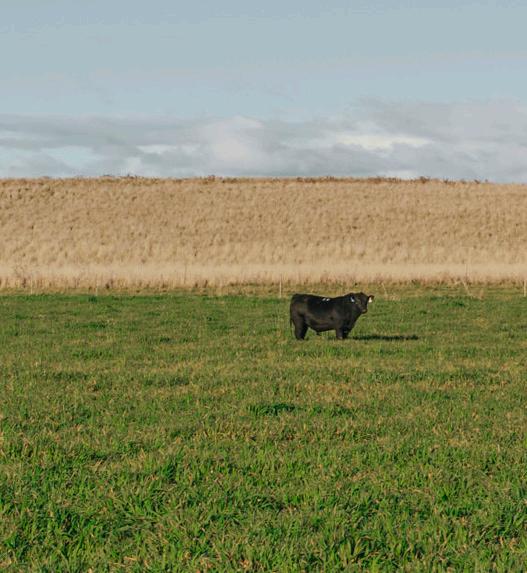
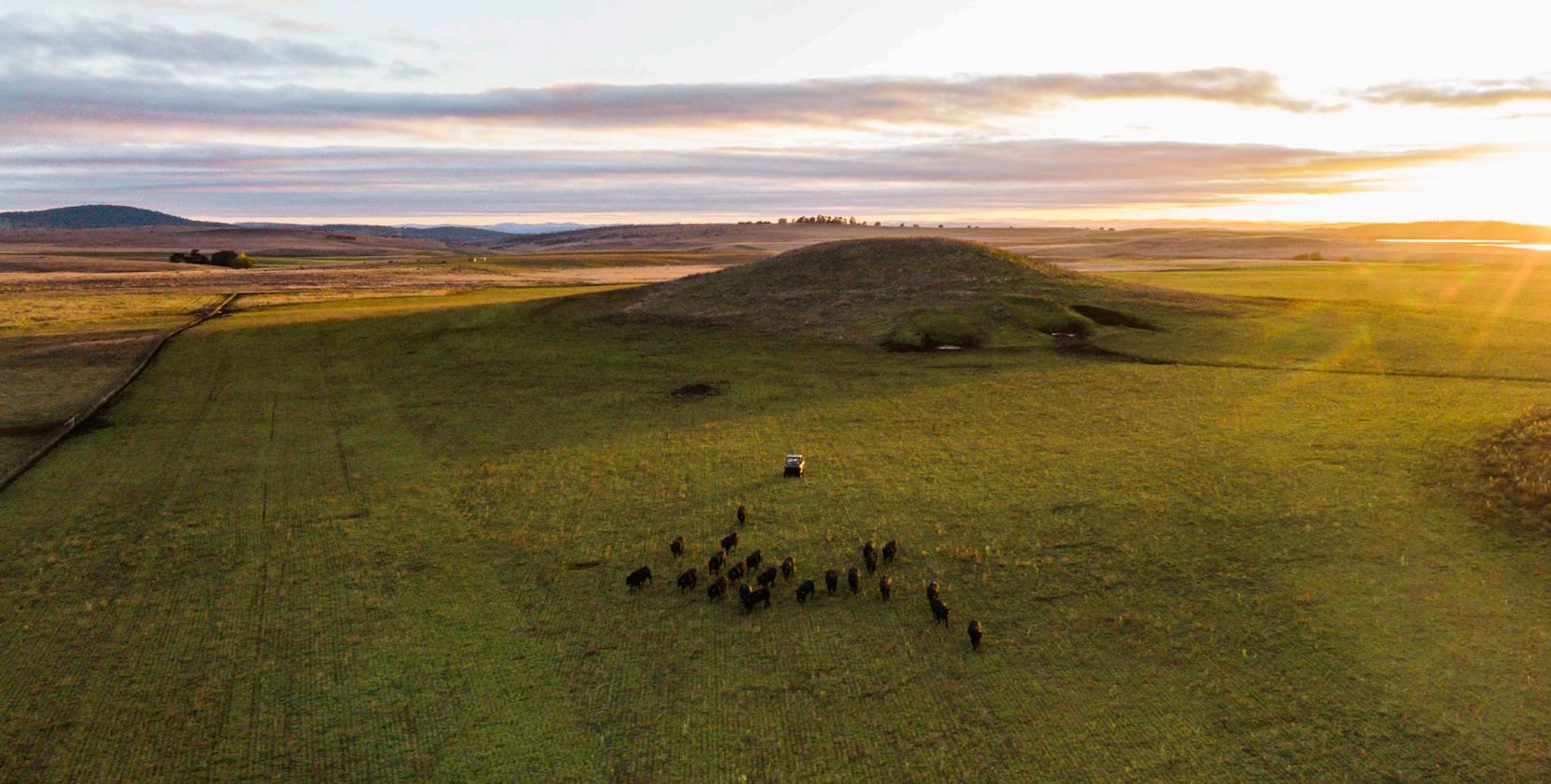
Alongside thirteen full time staff members, Hazeldean is governed by Jim Litchfield in his role as Manager Director, with daughter Bea continuing the breeding and genetic improvements as Stud Manager and Ed assisting farm operations and acting as the Sales and Marketing Manager. The company also has an advisory board which provides advice and reflections to benefit the development of the business.
Prior to entering the Hazeldean business in 2017, Ed had worked for Rivalea, one
of the largest pork businesses in Australia. Working in trading and sales there it was determined that Ed’s skills in the area would be of benefit to the Hazeldean business.
“I wasn’t too bad at sales, and it all worked in quite well transitioning to Hazeldean,” said Ed. “They had an opening for someone in sales and marketing – we agreed I would give it a go!”
Entering this new dynamic and role was a learning curve for Ed, who understands the special brief needed to work within a family run operation.
“I've definitely had a lot to learn in the whole stud game,” he said. “I came in pretty green, and I was baptised in the way Hazeldean likes to do seedstock, which probably was a real advantage for me and the business.”
“I suppose its both tough and easy to start new people without predispositions of how they like to do things, but it's been a real learning curve for me! It's very challenging but rewarding, also delicate because it's more than just a job - it's your whole life, family, our livelihood and heritage.”
And heritage is an important part of the Hazeldean story, with the business being at the forefront of early adoption of performance recording in the beef industry and the Angus breed. The late James Litchfield OAM, father to Jim and grandfather to Bea, was a figure head for the beginnings of what we know to be BREEDPLAN and the Trans Tasman Cattle Evaluation (TACE) today. The 1970s saw the emergence of the Angus Herd Improvement Group (AHIG) and its relevance to the Angus TACE as it is today. After its formation in 1966, the AHIG and all its assets were officially handed off to the society in 1970.
The same year the Angus Herd Improvement Scheme was formed by Chairperson Mr Litchfield alongside Gordon Munro of Booroomooka Angus, Bingara, NSW and Michael White of Belltrees, Scone, NSW.
It was at the 1970 beef industry conference held at the New England University, where a committee was appointed for a nationwide performance recording scheme. The committee had three sections, the first under Dr Arthur Rickards in the Agricultural Business Research Institute (ABRI), tasked to develop a data-recording system and compatible computer programming. Dr Keith Hammond headed the Animal Genetics and Breed Unit (AGBU) which reviewed the genetics underpinning the commercially significant traits that could be measured objectively in beef cattle and developed selection formulas.
26
Mr Litchfield was the chairman of the technical subcommittee whose role was to examine the practical aspects of applying on farm technology.
The National Beef Recording Scheme (NBRS) was established in 1972 and in 1973 the Beef Improvement Association of Australia developed the Beef Sire Evaluation Programme, with the first test of this program being for the Angus breed. In 1977, Angus Australia joined forces with the NBRS to develop the Angus Herd Improvement Register (AHIR).
At the time of the development of the AHIR in 1977, purebred Angus cattle made up 20% of the performance records in the NBRS database. National Angus Group BREEDPLAN was developed in the early 1980s as “an advanced genetic evaluation system that provides a genetic description of Angus cattle for a comprehensive range of traits.”
Angus BREEDPLAN allowed for a database that assisted seedstock producers to identify within their Angus cattle the superior and inferior traits of particular animals, which allowed for data to be provided to commercial producers to assist for the selection of their breeding programs.
By the early 1980s, according to a breed percentage basis, Angus breeders were the highest users of the Group BREEDPLAN. With this, the idea was put forward of an across herd BREEDPLAN analysis due to the active use of the same popular sires being used across many Angus herds. By 1993, 70% of Angus bulls at members sales were presented with Angus BREEDPLAN figures.
The farsightedness of pioneers like Mr Litchfield, who also championed similar progression within the sheep industry, that has allowed Angus to be placed at the forefront of genetic progression and performance.
“Mr Litchfield, Bea's grandfather, saw a lot of scope in the Angus breed and decided to launch into it and they already had a passion for objective measurement from the Merino stud business that was here.”
“These were then put into BREEDPLAN and generated estimated breeding values down the track.”
This progression and eventual genetic superiority, alongside the breed adaptability and versatility has seen the continuation of the Angus story at Hazeldean, near 90 years on from their initial adoption of the breed.
The Hazeldean operation is run over four properties in New South Wales, with two in the Monaro region and two near Adelong in the states Riverina region. Cooma properties Hazeldean and Myalla are spread over 13,400 HA, with country made up of a mix of basalt and granite soils with minimal wooded areas and open plains of native grasses and improved. The Monaro properties have an annual rainfall of 520mm, falling predominantly in summer and feature trademark harsh winters.
The Adelong farms comprise 1930 HA and are usually receive yearly rainfall of 800mm.
The Hazeldean Angus herd is a spring calving herd. Each year, the operation artificially inseminates (AI) 2,500 females in their seedstock operation, including 950 heifers. Each female gets one round of fixed time AI, followed by two cycles with a backup bull. Heifers are joined as yearlings, typically when they have matured to minimum of 340kg.

The females in the commercial Angus herd are all naturally joined for a period of two cycles.
For the females in both the seedstock and commercial herds, fertility and the philosophy ‘of the cream rises to the top’
is key, with any females that fail to get in calf during the joining period culled from the herd.
“First you need a live calf, so fertility and calving ease - they're the number ones. Heifers are classed and sorted, then if good enough are joined as yearlings once they get to around 340kg.”
“They need to have that calf unassisted, rear it, wean it well and then get in calf again the next spring with a calf on them. It’s once they get to that second pregnancy status and pass an independent structural assessment, they officially become a stud cow. They then get a freeze brand and stay with us.”
Additionally, an emphasis is put on temperament and structural correctness in their female herd, with animals culled accordingly if they are not achieving the desired benchmarks.
“Female herd temperament is a huge one that we're pretty ruthless on at Hazeldean,” said Ed. “We take pride in how quiet they are, so we're forever managing bloodlines and temperament.”
“Structure is the same deal. We objectively measure all our structure with independent assessors. That's probably a core operation that every stud should be doing. Having independent structural assessments done on your herd objectively and having that data fed into the TACE analysis, especially as the structural EBVs grow, is important. Then growth and carcase have got to come along after that too, to make sure you have got that performance.”
He continued, “But it’s not all about numbers, they've also got to look the part! A nice thick and easy doing type of female that are going to be easy to look at and going to have attractive progeny. Long, impressive, tough and adaptable progeny with industry leading performance is just as it is in the stud business”.
| 27 The Angus Bulletin - Spring 2023
With the female herd raising their progeny in the Cooma country, durability in their females is key. The environment is harsh and challenging through the cooler months. This highlights the importance of their ability to get going when the going is tough.
“The Monaro is pretty tough country. It's a very long, hard winter,” said Ed.
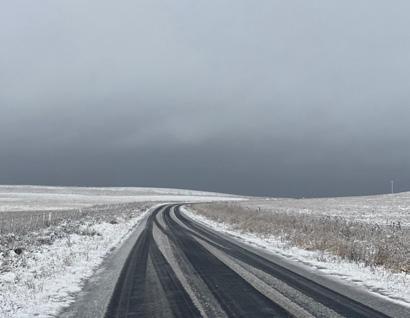
“We push them pretty hard and that's probably the part of the success of the business is that nothing gets too much special treatment. They're stud cattle but run like commercials, big mobs, big paddocks, and they've kind of got to do it on their own.”
This management philosophy means that the cattle have a typical nutrition plan before, during and after joining, with a pre calving Selenium, B12, and 7 in 1 to assist with the mineral imbalance in the environment.
When explaining the breeding philosophies and management practices of the Hazeldean operations, Ed once again highlighted that due to the varied environments of their clients, the animals within their herd need to have the ability to handle themselves in the conditions they are being bred.
“Durability is a really hard thing to measure. Australia is generally a big, hot and dry place. It’s the stud systems that should have this pressure applied for find the animals that can excel without special treatment. Then, the cream rises to the top, and you keep selecting for those better ones that can handle it,” said Ed.
“Especially as Australia gets more variable, these cows have still got to rebreed, even when they're skinny and pretty poor. We don't give them too much special treatment, they've just got to do it by themselves under commercial conditions.”
“To us, it’s obvious why the business has been successful with a lot of commercial clients - because that's how most commercial cattle farmers want to run their cattle too,” he said.
Hazeldean annually sells over 750 bulls through auctions and privately. The four sales are in New South Wales and Queensland. They have both seedstock and commercial clients, located all over the East Coast of Australia, from north Queensland and down to Tasmania, and South Australia too.
Hazeldean makes selection decisions and breed cattle that they believe are consistently pushing the genetic progress of their herd and in addition the operations of their clients and into the wider Angus breed.

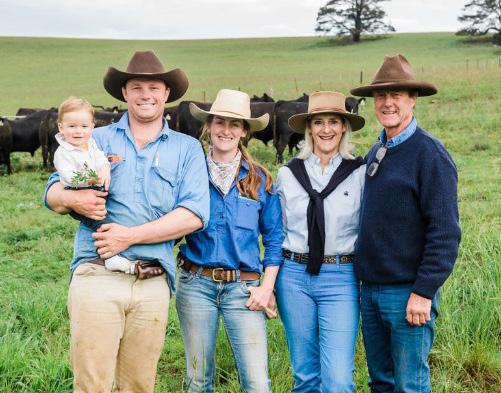


“We're all about genetic gain and breed average is only breed average. Breed average isn't going to create a lot of
genetic gain for us,” said Ed. “We strive to be industry leading in the four main pillars of fertility, calving ease, growth and carcase.”
“We want to continue to bend the curve in with profit driving traits and make actual genetic gain”.

He continued, “With objective measurement and quantitative genetics, the sky's the limit. Finding a balance of all the traits with type and functionality is the hard part.”
“It's hard to get the perfect mix, but you want to be trying to shoot for the top in all those areas and still have a good, functional animal that'll get out and walk, be low maintenance and tough enough to go to any environment,” he said.
The 1,150 female commercial Angus operation at Hazeldean focuses on producing steers for feedlot, with an entry weight of 400kg. With an ongoing relationship with Rangers Valley Feedlot, the cattle go into a long fed program of 200-250 days to produce high carcase quality and marbling beef for restaurant grade export.
For both the seedstock and commercial operations, Ed’s role in the business supplies the important connect between vendor and client, with the business relying on the feedback of their clients to continue to growth and success for their herd.
“We keep up with all our clients to make sure they serviced well, then discuss with them upcoming requirements for bulls and rams,” said Ed.
When looking at their business and the challenges that the Hazeldean team face on the day to day, Ed identified external factors that he highlights that not only impact their operation, but their fellow producers across the agricultural industry.
“The cattle market has come off pretty hard, pretty quick, but that's definitely been a challenge. Unfortunately, the sheep market is just as tough. So, instability of
28
markets makes it a bit tricky - especially from a sales point of view.”
He continued, “Obviously, the last couple of years, bull demand has been feverish and it's hard to meet that market. It's three years to make a bull for us and you just can't turn the bull tap on.”
“I think trying to manage supply and demand for our clients in the seedstock space is tough because you want to be able to cater and sell bulls to everyone when the phone rings and they need them.”

When looking at the future for Hazeldean, Ed speaks for his family when he highlights both short term and long-term goals that they have identified, which will hopefully be brought to fruition with the combination of the generations of the family at the helm of the business, which now includes Ed and Bea’s two young children.
“Jim has done a phenomenal job of running two studs. Not many people do two, especially not the scale that the Litchfield’s do.
“For the short term we've grown a lot the last couple of years, so we want to maintain that growth, maintain all our clients, and have genuine sustainability in

the cattle game. Like I said, when people need bulls, they don't get blown out of the water and can still come and get what they require at a fair price and repeat that.”
“For the long term, we would like to continue to have a happy workplace with a really good group of staff who enjoy their work, are happy and raising their families,” he said.
“For us as a family, we want to do that as well. You want to enjoy your work every day and look forward to bringing kids into the business one day if they want to. We want to be able to leave it in a better shape than it was and continue the legacy into the 7th generation and have the business in tip top shape if someone else wants to continue that in our little family.”
Fostering the Future with GenAngus Future
Ed was a member of the 2023 cohort of the GenAngus Future Leaders Program (GenAngus), which saw him take part in the three-day intensive workshop in May of 2023. The program is designed to equip young members of the beef industry in their new or existing beef enterprises with the skills, knowledge, and mindset required to excel in today’s dynamic and fast-paced agricultural industry.
“I applied for GenAngus because I thought it was a really generous program with plenty of scope. It's not just a one-day workshop and a dinner, it was three very full days with a good, likeminded bunch
He continued, “If the industry and the breed want to grow fast and try and achieve as much as they can, that'll have to be a group effort. It will come from everyone sharing ideas, genetics, resources and supporting each other in trying to do the best job that we can as a breed to stay at the top.”
When reflecting on the experience and the sessions that resonated with him the most, Ed highlighted those presenting outlooks on the future of the beef industry.
“Simon Quilty (of Global AgriTrends) highlighted a lot about global agricultural markets. With my background, it was really positive to be reminded that beef such a global market and you have got to keep your eye on the ball with what's coming down the line. Keeping plenty of up to date and relevant information at your doorstep is important for decision making. It’s always moving fast and things don't stay the same in ag for very long.”
When asked why he would encourage others to consider applying for the GenAngus Future Leaders Program in the future, Ed highlighted that the experience provides the opportunity to get off farm, be surrounded by likeminded people, and work to grow yourself for the betterment of your career.

“I think it's a really good week of professional development. GenAngus makes you think about what you're doing as a person in your work life, personal life, and career,” said Ed.
time. Professional development is valuable,
| 29 The Angus Bulletin - Spring 2023
33rd Annual Bull Sale 45 Yearling Bulls Netta Holmes Lee 0409 651 806 www.nooneeangus.com.au SIRES REPRESENTED Karoo Realist N278 Sterling Pacific 904 Sitz Stellar 726D Noonee Navman N71 Noonee Padrone P11 Noonee Remington R23 Millah Murrah Might & Power M176 Friday 13 October 2023
“ “
We take pride in how quiet they are, so we're forever managing bloodlines and temperament
Living her dream at K State
Diana Wood, Marketing & Communications Manager
Rebecca (Becca) George was awarded the Kansas State University Scholarship in 2019 and after multiple delays finally got the chance to live her dream and spend a semester at this iconic university in Manhattan, Kansas!

During her stay Becca fully immersed herself into student life in the Midwest, (all inclusive of the American college experiences such as the K State Rodeo, a baseball home game and a Super Bowl watch party) and took the most of every opportunity thrown her way.

‘I enjoyed a range of different classes across the Animal Science and College of Agriculture programs, and I am very grateful for all the professors and my classmates for welcoming me into their classes this semester and also for being curious about Australia.’
The opportunity to join and share these classroom experiences allowed Becca to enjoy being able to share her journey in agriculture and her knowledge about Australian production systems with her classmates.
The 110th KSU Cattleman’s Day held on campus at Weber Hall during March was one of the big highlights for Rebecca during her study.
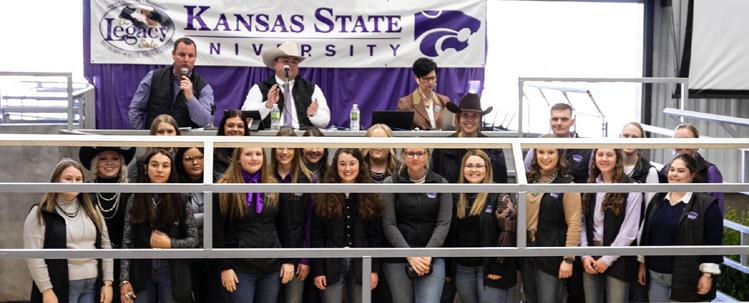
‘The day kicked off with the trade stalls and research posters in the arena and from there I was able to attend the first session of the day, given by Jason Sawyer that focused on navigating the U.S carbon markets.’
As well as the trade stands and information sessions, a large part of the KSU Cattleman’s Day involves the KSU Legacy Bull Sale at the Stanley Stout Centre.
The KSU Legacy Bull Sale is run by the K State Purebred Beef Unit and the class of ASI422 Livestock Sales Management, which sees the class involved in all aspects of running the sale, including the organisation, marketing, and management of the sale, along with everything else involved in running a sale.
Rebecca, who was a part of the Livestock Sales Management class, said that ‘The sale was offering 19 Angus Bulls, 14 Simmental Bulls, 9 Hereford Bulls, 1 Elite Angus Heifer, 14 Bred Heifers, 21 Commercial Heifers and 3 Quarter Horses.’
‘The sale was a great success, drawing in a large crowd of buyers, K State Alumni, Students and Faculty. The top price of the day (for the cattle) went to the Elite Angus Heifer selling for $10,000 USD. The Angus bulls sold 17/19 and to an average of $6,500 USD,’ she added.

‘I really enjoyed Cattlemen’s Day and am very grateful to have been able to participate in the Livestock Sales
Management class and assist in the running of the Legacy Sale.’
Rebecca also took the opportunity where she could to get off campus and experience the American beef industry (visiting a bull sale, The National Western Stock Show and a visit to the American Angus Association, to name some) when afforded the time.
‘At the start of April, I was able to head out to Lorraine, Kansas for the Green Gardens Angus Bull Sale, where the Jenssen Family had 100 bulls on offer for their 64th Annual Production Sale. Lot 31, Gardens Split Fire PAR J65, was the top bull of the day bringing in $14,500 USD. The sale averaged $5,070 USD. I really enjoyed being able to get out on farm and walk through the bulls pre-sale.’
Another highlight for Rebecca was a visit to the American Angus Association, St Joseph, Missouri.
‘Jerry Cassady, the Director of Member Services, gave me an overview of the association structure as well as the member and animal registration statistics.’
‘I also enjoyed talking with Troy Marshall, Director of Commercial Industry Relations, about ongoing projects to assist American commercial breeders to get the most from their herds,’ she added.
Becca also spent time with Kelli Retallick, Angus Genetics Inc (AGI) Director, and Andre Garcia, AGI Geneticist, from the department responsible for generating EPDs for the American Angus Association.
‘Lastly I was able to chat with Shauna Hermel, Chief Editor for Angus Media, about the different publications, digital media and branding the Angus Media branch work on.’
During her visit Becca sat down with Shauna to record a section for the podcast ‘Angus at Work’.
In summing up her time in the USA, Becca could not be more grateful for the experience that the Angus Foundation Scholarship has afforded her.
‘Being able to experience an industry, that I hold a lot of passion for, internationally will always be a privilege and I am thankful for everyone who has taken the time to share their experiences with me,’ she said.
‘I would like to thank Dr Dan Moser, Associate Dean of the College of Agriculture, for hosting my exchange here at K State. Dr Moser helped me to create a custom timetable and always ensured I was getting the most out of my experience.‘

Angus Youth 30
Angus provides opportunities in more ways than one
Diana Wood, Marketing & Communications Manager
Becca and her family run a mixed enterprise farming business near Nevertire in Central West New South Wales.
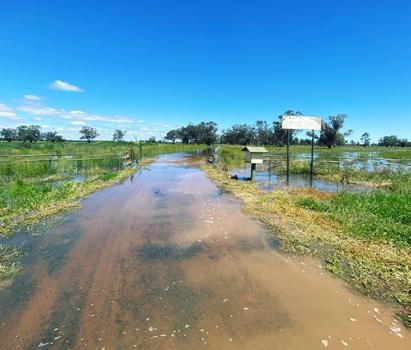
Becca and her sisters Dee and Emma are fourth generation farmers, who throughout their childhood, education, gap years and work life have always been drawn back to the farming life and time spent helping their parents, Donna and Trevor.

The George family operate dry land cropping where they have mainly cereals in rotation, produce meat sheep, running White Dorpers and Australian Whites, along with their commercial herd of purebred Angus.
‘It can be a bit of a balancing act, keeping three balls up in the air at once, but it's something that I grew up watching mum and dad do quite well and now that I live closer to Mum and Dad, as are my two older sisters, we really are able to work it together as a family, which is nice to learn from each other.’
With Becca’s love of cattle, she has gravitated towards working with the cattle mostly, with sister Dee an agronomist by trade helping a lot with cropping and oldest sister Emma, a shearer, providing her input on the sheep front.
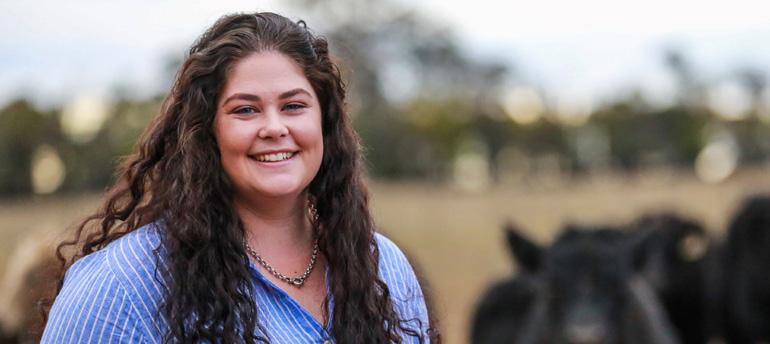
‘We have sort of all gravitated towards a different part of the business and are able to help there and work closely with Mum and Dad.’
The George Family’s involvement with Angus cattle goes back to Becca’s grandfather, who had mainly run Herefords.
‘When Dad was probably around my age, in his early 20s, they started looking to take advantage of some hybrid vigour and brought in some Angus bulls and it sort of snowballed from there.’
More recently the George’s took a lot of inspiration from their neighbours and good family friends, the Chase family.
‘We saw the great things that they were doing with the breed and from the Herefords and then running the Black Baldies, we transitioned into a purebred commercial Angus herd and haven't really looked back, to be honest.’
‘Angus cattle have given us a lot of opportunities. As commercial breeders, we never have trouble finding good bulls and we've bred a group of females that we're proud of.’
Running a self-replacing female herd through selecting their best heifers to keep, they have bred a line of cows that have been really good to them and have been able to hold on to through drought and semi floods.
‘The Angus cows done a really good job through all the conditions that we've had thrown at us. We’re incredibly happy that we went down the purebred Angus road, it's a good place to be as a cattle producer,’ said Bec.


Steers are mostly sent up north to a feedlot, so when selecting bulls, the family are really looking at that market and down the supply chain for what traits are needed, especially to go into the feedlot market.
As well as looking at the carcase data available, structure also plays an important role.
‘We really do have a big focus on structure because at the end of the day they've got to be able to get around, this country can be quite harsh, especially in the drier times.’
This philosophy is also applied to their female selection when deciding which females to keep.
‘We'll start with structure, do some hard culls there and then if we do need to make any more choices, we'll start going
| 31 The Angus Bulletin - Spring 2023
off weight. We'll retain the heaviest of the heifers to keep and pop in with a heifer bull.’
AuctionsPlus is utilised to sell excess females, which has been successful for the Georges.
When it comes to management practices, the George Family attempts to stick to a calendar of operations to make sure that they are ticking things off when they need to be done and are keeping animal health up to date, as well with ensuring vaccines and backlining to look after their herd, which became evident during the 2019 drought.

During this period, the George’s made the decision to prioritise their cows.
‘We culled off a few, but we kept quite a lot considering how harsh that period was. We really invested in some good quality feed that we were feed testing so that we could come up with more accurate rations and really prioritise them through that harsh period,’ said Becca.
‘And we came out the other end with some really healthy cows that bounced right back.’
When asked about key drivers of production for success of their herd, Becca said that initially they were looking at weight.
‘We do look more towards our weaning weights and then compare that to when our steers head up on the truck to go up to Queensland to the feedlots. We also look at average daily gain and like to compare to the year before, compare seasons as well, and see if we were utilising our pastures as well as we could have been. We look to the data to measure success, I would say.’
For Becca, this is something she has enjoyed doing a lot.
‘Producing those numbers, it's quite black and white, we can see where we've improved and where we haven't.’

‘Dad really enjoys looking at his spreadsheets and seeing how we're doing so for our cattle, we are definitely data driven to measure our success, especially with those steers, as weight is everything when we're trying to get them backgrounded to head up north.’
The George’s also get a lot of information from the feedlot and kill data that comes in for their cattle after they have been processed.
‘It's really cool to see that data and then compare it to what we had here on farm and compare to the year before.’
‘We can look at our genetics and work out if we are still heading in the right direction and make those decisions in terms of our breeding.’
‘So, data is an incredibly powerful thing and I think it's definitely the best way for us to measure our success and make any changes in terms of production.’
Like many western New South Wales and Queensland farmers, the biggest challenge the Georga Family faces is weather.
‘Our highs are high, and our lows are very low, and I think that's something that the region as a whole, and then more specifically, our family has learned to navigate a lot,’ said Becca.
‘Drought proofing is something that's been on the forefront of our mind, especially since the last drought. That's something that I've found myself thinking about a lot and researching. These great years where we're having the right amount of rain and there is feed in the paddocks aren't going to last forever, so are we making good decisions now, so that when we do hit
another hard period, we're more prepared,’ she added.
To combat this the George’s have put feed away and so they are ready to get stuck back into drought feeding.
‘We're trying to be more proactive rather than reactive, we've buried some grain, we've made hay, so that we can commit to the female herd again when that time comes.’
Their mixed farming enterprise means that the family operate in a way that allows their cropping, sheep and cattle to complement each other and ensure a balanced approach to those tough times.
Angus Youth Program provides ample opportunity for growth
Involvement with Angus cattle have not only provided Becca and her family with their livelihood but has also seen Becca gain access via the Angus Youth Program to ample learning opportunities that provide practical knowledge, as well as growth and leadership skills that Becca has been able to implement across her life.
Becca is no stranger to the Angus Youth Program, with over 20 years of taking part in various Youth activities and events hosted by Angus Australia, including the Angus Youth National Roundup and the GenAngus Future Leaders Program.
She has also been the recipient of various Angus Foundation scholarships, including the ARCBA Young Breed Leaders Workshop Scholarship and the SmartBeef Conference Scholarship.
Beca has also been a member of the Roundup Organising Committee and the Angus Youth Consultative Committee.
Angus Youth 32
BTB
Upon her return to Australia Becca recorded an episode of ‘Behind the Beef’ where she talks with host, Cheyne Twist about her story in agriculture and the Angus breed, as well as to providing some insight into her time over in the US
Podca Behind the Beef
NH Foods Australia to ‘deliver the joy of eating’ at Roundup
 Cheyne Twist, Senior Marketing & Communications Officer
Cheyne Twist, Senior Marketing & Communications Officer
Preparations are well and truly underway for the 2024 Angus Youth National Roundup and Angus Australia is pleased to announce that NH Foods Australia will once again be partnering with Angus Australia as naming rights partner of the upcoming event.
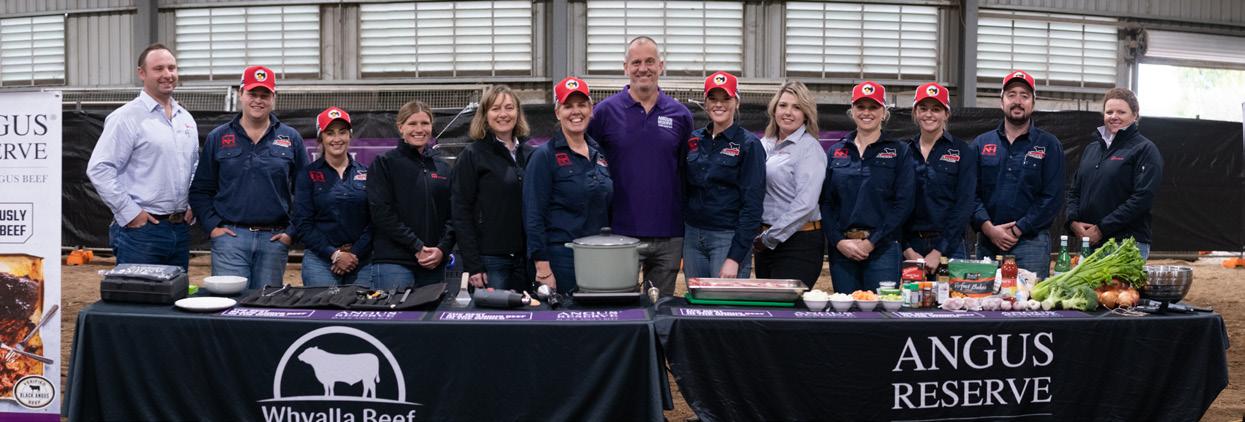
The NH Foods Angus Youth National Roundup will take place January 10th – 14th 2024, at the Australian Equine and Livestock Events Centre (AELEC) in Tamworth, NSW.

The Roundup Organising Committee is pleased to have NH Foods on board for Roundup in 2024, following a hugely successful partnership for the 2022 NH Foods Angus Youth National Roundup, which saw exciting new elements added to the program with TV Chef and proud brand partner of NH Foods ‘Fast’ Ed Halmagyi, wowin participants with a cooking demonstration and dinner.
“I’m excited to be partnering again with NH Foods Australia as our naming partner for the 2024 Angus Youth Roundup,” said Toni Nugent, 2024 NH Foods Angus Youth Roundup Event Manager.
“NH Foods are a global leader in beef production, working across the entire beef supply chain. They will bring their expertise, knowledge and resources working with our committee to build an educational program that addresses all aspects of beef production from onfarm grassroots production, through to processing and delivering products to meet customer needs and demands.”
Andrew McDonald, Director at NH Foods, said “Building on last year’s success, we’re proud to return as the main sponsor for this event.
“Our team is built around one mission – to deliver the joy of eating. It’s our pleasure to be in a position where we can share our passion for Australian beef with the next generation of enthusiasts.
“We’re in full swing with preparations for the 2024 event and looking forward to adding another new dimension to the program.”
The event is open to all competitors, from novice to experienced. In addition to the educational experiences and competitions such as herdsman, junior judging and paraders, there are several great awards on offer.
The 2024 NH Foods Angus Youth Roundup will again have fun in store for parents and guardians with the parents and sponsors bus trip visiting cattle studs and local attractions.

Want to support the future of the beef industry?
The 2024 NH Foods Angus Youth National Roundup to be held in Tamworth from 10 – 14 January 2024, would not be possible without the support of its many partners to assist in conducting this significant event that delivers a unique learning environment for the Youth of the Australian Beef Industry.
We thank our sponsors and encourage you to support them in the lead up to, during and after the Roundup. To learn who our sponsors are scan the QR code.


As a not-for-profit organisation, Angus Australia relies on the support of its many partners to assist in conducting this significant event that delivers a unique learning environment for the Youth of the Australian Beef Industry. There are still opportunities to support the NH Foods Angus Youth Roundup.

| 33 The Angus Bulletin - Spring 2023
Become a sponsor More information
Our Sponsors
Emerging Leaders at the Zoetis Angus National Conference
Cheyne Twist, Senior Marketing & Communications Officer
With the theme of the recent Angus National Conference going “Beyond the Beef”, when looking to the future of the industry it’s hard to ignore the up and comers who are making their mark in agriculture through their own individual journeys.
In one of the panel sessions hosted during the national conference, the crowd had the pleasure to hear some of these stories from young members of the beef industry, Damien Thomson, Bonnie Cox, Brianna Maslen and Chris Metcalfe.
Each panel member had an excellent story to share, speaking about their life and career journeys so far, their passion for the agricultural industry and their experience being involved with Angus Australia through the Angus Foundation Scholarships, Awards & Bursaries program.
Firstly, Damien Thomson gave the audience some insight into his family beef operation, Shacorrahdalu Angus, which runs approximately 130 stud cows across Autumn and Spring calving herds and 440 commercial females across a number of properties in NSW.
Speaking of their story so far, Damien spoke about the development of their operation from the beginning consisting of the purchase of 40 heifers, through to 2009 with the purchasing of their current property, through to the first of their annual helmsman sales in 2021.
Outside of his involvement on farm, Damien also is commanding a career off farm, currently working for AuctionsPlus as a senior market analyst within their Market Insights Team. Damien’s role sees him analyzing markets across the agricultural industry, from cattle to goats, formulating commentary and forecasting reports.
Through his involvement in the Angus Australia Scholarships, Awards and Bursaries program, Damien has taken a keen interest in his personal and professional development through applying for numerous programs and scholarships made available through the Angus Foundation.
His first foray into the Angus Youth program saw him attend the Angus Youth National Roundup in 2019 in Armidale, where he was awarded the Bulliac Studmaster Award and was presented embryos, donated by the Hill Family of Bulliac Angus. From these embryos, Damien has bred animals that have contributed to the diversity of his breeding program, creating a full circle moment when he sold progeny from this award at the family’s inaugural sale.
“At 21 years old, I'm going to my first Roundup. I didn't know anyone at that
point, I rock up and I am one of the oldest in the whole Roundup and I'm put in charge of one of the groups for all the different activities,” said Damien.
“I thought, ‘here we go, I'm not going to know how to do any of this’. Luckily enough, I had some young guys in the group that knew what they were doing, and we worked it out together and to this day, that Roundup was one of the best events that I've ever been to.”
“In that first Roundup, I had looked at the scholarships and bursaries and came across the Bulliac Studmaster Award. I thought, this is something I'm eligible for and I'll put my name forward for that, and fortunately enough, I won.”
“I never thought there was a single chance and in terms of talking about the last four years involved in the Angus Youth program and the benefits that I've enjoyed through that, the more tangible ones have come from this Bulliac Studmaster Award.”
Making himself known through applying for these opportunities like the Bulliac Studmaster Award, Damien has taken part in numerous Angus Australia initiatives, including the GenAngus Future Leaders Program, the Beef Australia Scholarship, the Trans-Tasman Travel Bursary and the ARCBA Young Breeders Workshop Scholarship.
“I've had that love of cattle for as long as I can remember, since we've had the farm in ‘98, and I probably lacked that connection and that belonging to the people early on, not being connected to this community being from Canberra and not knowing what the Roundup was until I was 21. Being involved in the Angus Youth Program and thinking back over the last four years gives me an absolute buzz and it's been a thoroughly enjoyable experience.”
Also joining the panel was the Inaugural Angus Foundation AuctionsPlus Cadetship Recipient Bonnie Cox. Bonnie had returned to the beef industry and the Angus Youth program after a period away, having previously been involved through attending Roundups over the years.
“I did grow up getting dragged into the junior judging ring and going to the Roundup, and I absolutely loved that, but as most young girls do that adore horses, I tried to pursue that coming straight out of high school and that led me to move down to the south coast of New South Wales,” said Bonnie.
“But I found after a couple of years of doing the horses, there was something missing. I definitely found that it was the agricultural industry that I was missing, and most importantly, the beef industry.”
“I knew that Angus Australia did have a wide range of Angus Foundation opportunities for the youth to get back into the industry with and that's how I found the AuctionsPlus Cadetship. I didn't know if I would make it and I had a couple of people really convince me to apply, put my name down and just give it a go. And I did, and I was lucky enough to get it.”
In her cadetship experience, Bonnie spent four weeks working across the AuctionsPlus business, learning about the day-to-day operations. Following her cadetship period, Bonnie was asked to stay on as a member of staff at AuctionsPlus, a role she is still in, working as a Market Operator.
As part of the scholarship, she also took part in the Marcus Oldham Leadership Program, an experience she credits as one of her most valuable experiences.
“It's absolutely changed my life, being able to do the Cadetship. I knew I've always wanted to be in agriculture and specifically in the beef industry, but I didn't really have the best idea plan of where to go and what to do,” said Bonnie.
“Since doing the cadetship, it's really changed my outlook and where I think that I might go in the future within the industry. Being able to have these new contacts and new networking opportunities through AuctionsPlus has been an absolutely invaluable experience.”
Lending his insight to the panel was Western Australian producer Chris Metcalfe. Chris joined the panel from his home east of Albany where with his family he runs a mixed family enterprise of cattle, sheep and cropping over 18,000 acres. Highlighting the benefits of working on farm with his family and in particular his privilege to learn from his father, Chris spoke about returning to the family operations after exiting the industry for a time to obtain a degree in Mechanical Engineering.
“I decided I definitely wanted to return to the family farm and join the business and grab all the opportunities that came with being involved in the ag industry and the lifestyle that it offers.”
“I also understand it's a privileged position to be in, to have a farm to come back home to and I try to not take that for granted during the tough days,” he said.
Angus Youth 34
“Traditionally we've been a Murray Grey operation, then not long after I came back to the farm the opportunity to purchase the Koojan Hulls Angus Stud became available, which we jumped at and bought that off Lew Smit.”
“I’m sure many knew Lew Smit and the impact he's had on the Angus breed and the legacy he has left so it's a real honour and humbling experience to be able to continue the life breeding of Lew. If I can one day leave half the legacy that Lew left behind, I think I'll be doing well.”
Chris had been involved in the 2021 cohort of the GenAngus Future Leaders Program, and he highlighted the opportunity that it presented to engage with other likeminded individuals.

“Being from Western Australia and being heads down bum up on the farm, you probably don't get to get away quite enough and build a network, so for me to build a network of young people and still learn from some more industry experts was a great opportunity and it's led to opportunities like this.”
Finally joining the panel was Brianna Maslen, who was awarded the inaugural Angus Foundation Research Grant in 2021. Brianna is currently doing her PhD through Charles Sturt University (CSU) in Wagga Wagga, NSW.
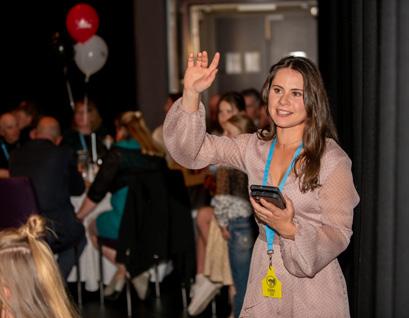
Brianna brought to the panel a different perspective of the beef industry, having not come from a background in agriculture but with a passion for research, particularly in animals.
“While I grew up with limited knowledge of the beef industry, I was always passionate about research, particularly in animals,” said Brianna. “This passion eventually led me to CSU, where I did my undergraduate degree in Animal Science. This is where I started to learn about the different livestock industries. But it wasn't until an honours project based on cattle was offered to me that I began my research career in the beef industry.”
“In my honours project, I focused on researching the changes of microbial communities, otherwise known as profiles in beef cattle, as they are placed on feedlots. This project and the results discovered led to my passion for microbes and what they could do potentially for the beef industry.”
“As the research is still quite new and the door was open for further study, I began my PhD. The project is currently focused on investigating the relationship between faecal microbial profiles and the

production traits such as weight gain and immune responses in Angus beef cattle.”
“From the start, my project was only possible due to Angus Australia's Angus Sire Benchmarking Program. This collaboration came about because the Angus herd at CSU is annually benchmarked by Angus Australia, and we saw this as a good way to combine our resources and essentially design a better PhD project. As this was successful, I was able to access CSU's Angus cattle herd, sample faecal matter during benchmarking and get data for my project, including weights and immune response phenotypes,” said Brianna.
“Even with this collaboration, my project method was still weak due to funding limitations and sampling size. However, in 2021 I was awarded the Angus Foundation Research Grant, and this has allowed me to take to greatly strengthen my project.”
Panel facilitator Jake Phillips, Angus Australia, highlighted that the four panellists showed the variance that can be found when it comes to the people that make up the beef industry.


“I think that's just a great example of the diversity and the breadth of quality people that we've got in our breed that we need to be really proud of,” said Jake, before putting the question back to the panel with “What does investing in people actually mean to you?”
“I really think it means bringing in people from all different walks of life. I find that we can find new ideas from looking in places where we wouldn't really think that someone could come into the industry from,” responded Bonnie.
She continued, “I know a lot of people that have recently come into the industry that grew up in town, and they come into the industry with a completely different outlook. They bring these new ideas that you often think, oh, I never thought about it that way, so investing in people is really giving everyone a chance and seeing different places that they can come from.”
Supporting this, Brianna added, “I came from no agricultural background at all. My family doesn't work in an agricultural business, I just had a passion for animals.”
“If I hadn't been offered an opportunity within the beef industry, I wouldn't be here and I think I'm lucky that I am here now because there is a big avenue for growth in what I'm doing within the beef industry. It's been done a lot in humans, but we're not quite there yet with animals so I'm really keen to take this forward and see what it can do.”
| 35 The Angus Bulletin - Spring 2023
Top to bottom: Bonnie Cox in action for AuctionsPlus at the NH Foods Australia Angus Youth Roundup Auction; Damien Thomson was awarded the Bulliac Studmaster Award at the 2019 Angus Youth Roundup; Richard, Tim, Lachlan and Chris Metcalfe; Brianna Maslen, Chris Metcalfe, Brianna Maslen, Bonnie Cox & Damien Thomson at the Zoetis Angus National Conference
When poised with the question of whether the industry is doing enough to support the emerging members, the consensus was that there was plenty of opportunity existing in the industry currently, however as always, there was room for further growth.
“It’s an interesting question. Saying, is it enough?” said Damien. “I would certainly think that it is enough, however there's certainly areas that could be improved.” “There's definitely more things that we can do in terms of bringing people from metropolitan areas that haven't got that experience, I think this is a really big area that we can improve on just by opening up those opportunities.”
“I think probably the lowest hanging fruit that I can see is not necessarily from industry, but from the community within industry. One of the things we heard a lot about at GenAngus from Pete Clark, 21Whispers, was that we were the superpowers,” he continued.
“We were the ones that can do anything we wanted for believing in ourselves. It’s a pretty hard, long process of getting it wrong and then thinking you're okay and trying again. One of the things that can really make that a lot easier is if someone else believes in you, and particularly going to the next level and putting young people in charge of something and giving them ownership, I think, is really important for that early development.”
When asked about the challenges for the industry that current and emerging members may face in the future Damien highlighted some topics that had been focused on throughout the course of the conference, but also in the consumer space in recent times.

“There's no bigger challenge than the sustainability piece and working through carbon accounting, access to different markets through carbon neutrality, and there's a lot more there that we need to know about, but that's by far beyond the biggest challenge,” he said.
“I think there's more work that we can do in extension and to educate people and give them the opportunity to learn more about different things that they can do.”

Adding his perspective on the topic, Chris provided a personal example of positive ways the industry is trying to cater to its challenges, using his story of his father’s imagery and their family’s story appearing on the packaging of beef products sold out of Woolworths.
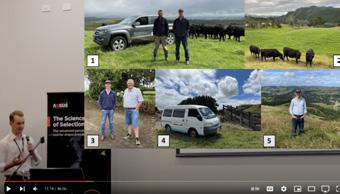
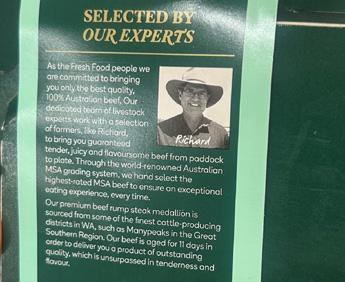
“I do think there's a bit of a disconnect between city people and farming people, and we have a responsibility to bridge that gap between the consumer and the producer,” he said.
“Over in WA we've got some vegan activists that run around doing crazy stuff and promoting agriculture in a really bad light and I think we need some faces of the agricultural industry to try to counter that and promote ag in a good light.”
“If I have city people come to the farm, I often get pretty nervous of how they're going to react to being on a farm. And 100% of the time, they love the experience, they love everything to do with it and want to know more.”
He continued, “Then when they find out that we sell beef to Woolworths, they can't wait to go in there and basically buy the beef and now with Dad's mug on the packaging, they like that even more. So, I think what they really like is the story behind it.”
“The price comes into it, the quality comes into it, but the story plays a big role. So, if you've got the animal health down pat and you've got the sustainability down pat, then the story comes into it. They like to know that a family or an organisation has basically put love into the bit of meat that's going on their plate,” he concluded. Referring to what has been shaped from her work and how the disconnect between producers and the research going into the industry can halt the process of the research, Brianna also highlighted the importance funding support has to the continued scientific development that works to better the industry.
“I know research usually starts in a little bit of a weird corner and a lot of producers may think that it's not quite what you need on farm, but I think we're coming up with unique solutions and they sometimes can't be brought across in the correct ways,” said Brianna.
“We start somewhere and then we can't get that out, and we also can't get any feedback back about what producers want. I believe cross talk there does need to get better.”

She continued, “Also if we have more funding, we can do more things and get to the goal a little bit quicker. And that's what everyone wants, we just want to make beef production better.”
Bonnie also highlighted the importance of education as a necessary touch point for development to better the sustainability of the industry.
“I would say education in a space where we see the disconnect, especially in metropolitan areas where city kids are growing up and they don't really know how beef, or an egg or milk comes onto their plate.”
“I think if we have education in these spaces, in schools, especially in metropolitan and urban areas, there's going to be more of a connect and people are going to understand more what farmers are, what we do and we're not going to have as much trouble with people thinking that we're doing the wrong thing, or we can have a better conversation and people can get more excited about what's going to be on their plate.”
Echoing this, Chris concluded the point by highlighting the work the industry bodies are doing in the space and how supporting these endeavours are a good way to assist industry.
“If I could invest in the beef industry, I’d keep doing what MLA are doing and invest in programs like Red Meat, Green Facts or the Livestock Collective, and have these organisations that can promote ag in a positive light.”
“If you can get someone like the Livestock Collective to go to work and act on our behalf and promote us through social media, social influencers and marketing campaigns and shows like MasterChef that promote agriculture in a good light, it's going to benefit us all.”

36
SCAN TO WATCH Watch the Presentation
Smartening up about Australian feedlotting at SmartBeef
 Cheyne Twist, Senior Marketing & Communications Officer
Cheyne Twist, Senior Marketing & Communications Officer
The Angus Foundation is pleased to announce that Emily Scrivener and Hamish Smith have been selected to represent Angus Australia at the upcoming Australian Lot Feeder’s Association’s (ALFA) SmartBeef Conference, taking place the 11th-12th of October.
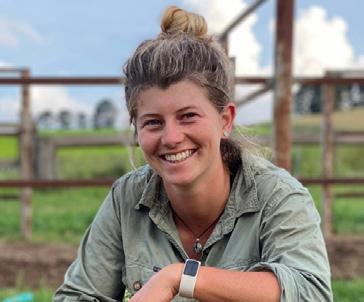
As the Angus Foundation Scholarship recipients, Emily and Hamish will take part in the event, which serves as the grain fed beef industry’s technical conference and will draw together feedlot operators and their staff, nutritionists, veterinarians, regulators, service providers and others involved in the grain fed beef supply chain. SmartBeef in 2023 will feature a full day on site at Elders Killara Feedlot & Wilga Campdraft Arena.

Angus Australia Extension Officer Nancy Crawshaw hopes that through the scholarship and conference event Emily and Hamish will have the opportunity to increase their knowledge of the Australian feed lotting industry and the beef industry as a whole, to network with industry professionals and develop their personal skills.
“Both Hamish and Emily show the drive to want to further their personal and professional development and we hope through the SmartBeef Conference and its theme of ‘Smarter, Richer Beef’ they will gain insight into the feedlotting industry through its diverse cohort of speakers from across the supply chain,” said Nancy.
“We are happy to have Hamish and Emily representing Angus Australia at SmartBeef in Tamworth and we look forward to hear about their experience and take homes post conference.”
About the Recipients:


Hamish Smith
Hamish is an eighteen-year-old Bachelor of Agriculture/Bachelor of Business student at the University of New England. He is from Northern Victoria and attended school at Moama Anglican Grammar. Along with his brother, Alex, and grandfather, Frank Sorraghan, he is a partner in “Rockwood” Angus overseeing artificial insemination programs, registrations, performance information collection and other practical aspects. His also does this for “Andes” Angus - his parents' Charles and Carolyn Smith's stud. He has participated in two Angus Youth Roundups, the SA Junior Heifer Expo, the Royal Melbourne Show and won an Angus Foundation Tocal Beef Cattle Assessment School Scholarship.
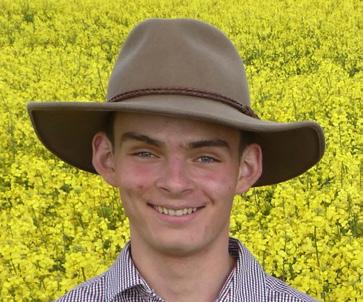
Emily Scrivener
Emily Scrivener grew up on a beef cattle property east of Walcha. She has been involved in her family’s cattle operation all her life and has recently become heavily involved in their Angus Stud. She completed her HSC at Calrossy Anglican School and this year changed from a Bachelor of Early Childhood and Primary Teaching to a Bachelor of Agriculture, which she is thoroughly enjoying. Emily works in a small not-for-profit organisation in Walcha performing secretarial duties twice a week between studying full time and working on the family property. In her spare time, she also trains show jump horses and breaks in cattle to take to shows.
| 37 The Angus Bulletin - Spring 2023
SmartBeef in 2023 will feature a full day on site at Elders Killara Feedlot & Wilga Campdraft Arena. The Elders Killara feedlot featured as part of the Zoetis Angus National Conference Pre Tour
SCAN TO WATCH
Observing paddock to plate production in Southeast Queensland
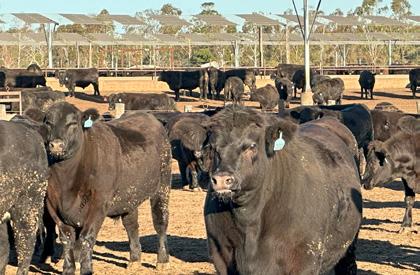 Cheyne Twist, Senior Marketing & Communications Officer
Cheyne Twist, Senior Marketing & Communications Officer
The inaugural Neogen Angus Foundation Production Tour took place in July and saw eight young members of the beef industry from around Australia embark on a three-day tour of Southeast Queensland, visiting various beef businesses representing stages of the supply chain that makes up paddock to plate production.



Alkira Riley, Charlie Wrigley, Georgia Graham, Tom Pumpa, Tyla Sparks, Sarah Nesbitt, Cooper Walsh and John Barnett all participated in the tour, which aimed to provide them the chance to experience firsthand the beef supply chain in this region to gain a greater insight and appreciation of Angus cattle in the SouthEast Queensland environment.
Over the three days, the tour moved throughout the southeastern corner, kicking off with a visit and tour of the Neogen Australasia Head Office and Lab, Bundamba, who provide comprehensive DNA testing solutions to various livestock production industries.

For the group, the tour of the facility provided insight into the processes of the company past the point of when producers submit samples for testing, as well as how the industry is building on this technology.
“At the Neogen Australasia Labs we witnessed how hair and tissue samples are processed beyond the farm gate and gained insight into the new technologies which have enabled faster, more accurate genomic and genetic condition testing,” said Charlie Wrigley.
“Technology advancements are something that the beef industry must continually adopt to and evolve with in order to remain ahead of economic strain and public perception. As seedstock producers, gaining understanding into what goes in to generating the data we rely so heavily upon was invaluable for all.”


“The tour and presentation by Nancy Crawshaw and Harry Stewart (Neogen Territory Manager – QLD) was insightful and focused on animal selection, genetic inheritance, testing and the links to EBV’s,” said Sarah Nesbitt.
“Harry gave us a tour of the Neogen Lab and the entire genetic testing procedure, providing us as seedstock producers tips on how we can help improve the process and make it more efficient.”
“Something that caught most of our attention was the procedure and timeliness of submitting tail hair samples rather than TSU’s. The lab attendant takes approximately 45 minutes to cut a tray of 96 samples for testing – individually cutting each follicle from the hair,” Sarah said.
Following their tour of the Neogen Laboratory, the group paid a visit to Jackie and Jim Wedge of Ascot Cattle, Warwick.
The group spent the afternoon with Jim and Jackie, who were forthcoming in sharing their insights with the group on their aim to breed bulls for the commercial environment and adhere to rigorous selection criteria, particularly focused on ease of calving, growth and carcase quality.

“Ascot Angus was my first behind the scenes exposure to an operation that breeds animals solely for the purposes of a stud sale,” said Tom Pumpa. “Jim and Jackie where happy to show us every little detail of their operation, from their top-ofthe-line bulls that makeup the cornerstone of their breeding operation to the land and animal management techniques they use to keep their business productive and easy to operate.”
“They were happy to answer any questions we had and whilst touring the bulls selected for their upcoming sale, I got to pick the brains of both Jim and Jackie and the other participants whose operations focus on stud sales.”
Charlie continued, “Jim and Jackie highlighted the importance of working closely with clients and absorbing their feedback. Through listening to producers and observing gaps in the market they successfully manage not just one but two breeds of quality seedstock.”
“Jim and Jackie’s integration with clients to help them achieve their goals and also better their own seedstock was an important note to their success,” he said. Next stop of the tour was a visit to commercial operation Dunmore Pastoral, located near Cecil Plains. Dunmore Pastoral is a progressive commercial operation in the Darling Downs region. Owned and operated by the Clay family, they ultlise Angus genectics in a dedicated breeding herd to supply a local feedlot, while also operating a trading operation over three properties. With manager Tim Clay, the team were able to have a behind the scenes look into the business and their management practices.
“The day I took the most away from was the visit to Dunmore Pastoral, run by Tim Clay. Tim has an ‘out of the box thinking’ to what he brings into his farm,” said John Barnett. “By using bio-waste as fertilizer and crops some would consider weeds, he makes the most out of other people’s waste.”
Angus Youth 38
“It's that kind of lateral thinking that I want to bring back into Barnett Angus, and to make the most of what is available in the local market, whether that be feed supplement, fertilizer, or recycled materials. Having a unique touch on our business is always a bonus, reaching people you might not have reached before, just by peaking interests.”
“In the age we are entering, being environmentally wise is something that all new farmers are going to be rewarded for in future to come. Our industry is so diverse in how we can operate our farms that finding the best way yours can operate, just might be different to your neighbors, so taking a risk on something new and different might be the answer you are looking for,” he said.
Sarah continued, “Tim gave an overview of his Optiweigh system that is placed in the paddock with an enticing cattle lick contained inside to encourage animals to step on the scales for real-time weight gain and management support for his herd.”
Following the visit to Dunmore Pastoral, the group moved onto a presentation from Mort & Co representative Jack Wilkinson.
“Tim joined us for lunch at the Cecil Plains pub where Jack Wilkinson from Mort & Co gave a presentation on the evolution of their business and the markets they sell to, and how that influences the cattle they were targeting,” Tom said.
Moving onto the feedlotting and processing sectors of the supply chain, the group visited Stockyard Beef Kerwee Feedlot and Oakey Beef Exports Abattoir, Oakey.


Participant Georgia Graham said of her time at the feedlot, “This was one of the highlights of the trip for me. I really enjoyed going through their feed shed, inspecting their pens. It’s an extremely well-presented feedlot, and it was impressive to see how well this operation was run and maintained with feeding such a high quality of cattle.”
Echoing this Alkira Riley said, “Kerwee Feedlot and Oakey Abattoir were eye opening. I thought I knew what an abattoir and feedlot looked like, but these were just next level. The sheer size and scale of

the operations and all the moving parts to make a business like this work was unreal.”
“It was a great and valuable life experience to truly be able to understand the full process of this part of the supply chain. I don't think the majority of people would understand the size, complexity, skill, and process that each bit of meat you eat actually goes through to get to your plate,” she said.
Before moving onto the final areas of their tour, the group visited Meat and Livestock Australia for a presentation regarding Meat Standards Australia (MSA).
“For a more in-depth explanation of the grading and overseas marketing process, we visited MLA’s head office in Brisbane where the whole science behind the MSA grade was explained, and we saw how breed composition and individual carcase traits affected the quality of the beef, and how Angus as a breed is uniquely positioned as a breed to capture our own section of the beef market,” said Tom.
To conclude the tour, the group visited Super Butcher Eagle Farm in the state’s capital to represent the consumer touch point in the supply chain.


“Our final stop on the tour to Super Butcher Eagle Farm raised awareness of the increasing demand from consumers seeking to understand where their food is coming from and the confidence that the product will perform on the plate, again and again and again,” said Charlie.
“It was a fitting note to end our production tour on, proving everyone in the supply chain has an important role to play in maintaining high standards of consistent, quality Australian beef.”
On reflection of their tour experience, the group were encouraging of others to apply for similar opportunities like the Production Tour offered by Angus Australia in the future, and while not one person had the same take homes as another, each were clear that they have taken something new back to their own situations at home.
“Getting to know like-minded, talented and passionate young people from varied locations and backgrounds was a highlight of the trip for myself,” said Tyla Sparks.
| 39 The Angus Bulletin - Spring 2023
Top to bottom: Jim Wedge, Ascot Angus, Alkira Riley, Sarah Nesbitt, Georgia Graham and Tom Pumpa at Ascot Angus; Visiting the Neogen Laboratory; The Group at Oakey Exports; Angus Australia CEO Scott Wright, Tim Clay, Dunmore Pastoral, Tom Pumpa, Sarah Nesbitt, Tyla Sparks, Alkira Riley, Georgia Graham; John Barnett, Cooper Walsh & Charlie Wrigley at Dunmore Pastoral; At Superbutcher
“I will definitely be asking advice and questions of them in years to come and visiting their studs/operations.”
“I would highly recommend this tour to all age groups and backgrounds as it will provide an entire supply chain view, regardless of the location of your operation,” she said.

“As someone coming from such a small and new stud operation with show cattle knowledge, this experience taught me a lot about the commercial and supply chain aspect of the beef industry that I wouldn’t have the opportunity to otherwise,” added Georgia.

“Seeing the cycle of breeding to feeding and meat production, including stud and commercial aspects, butchers and genetic testing labs was very informative. It was also great to see how different operations run and their reasonings for this, as well as their selection criteria and their goals and target markets.”
the opportunity to build a better understanding of seedstock production.
“I took part in the Neogen Angus Foundation Production Tour because I have a commercial background, and I wanted to get more into the genetics because I am interested in that side of things,” he said. “I wanted to make contacts out of the tour and also just pick other people’s brains, not just the guys that we go and visit on the tour, but also the guys that are on this tour with me, as well see what they’re doing and try to implement that.”
“My key takeaway from the tour was going more in depth with the genetics side things and also seeing how these studs work in this area.”
“This production tour offered so much that I would highly recommend it to any other aspiring Angus farmers. I’ve taken away a lot of knowledge that I want to implement into our business,” said John.
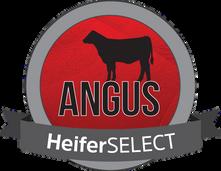


“Most of all I’ve made some great contacts in the field, and met some sharp minds in Alkira, Charlie, Georgia, Tom, Tyla, Sarah and Cooper, that I look forward to working with in the future, and watching the

Angus Youth
John Barnett, Clint Park & Charlie Wrigley
Jackie Wedge, Cooper Walsh and Tyla Sparks
T h e i n v e s t m e n t y o u m a k e t o d a y w i l l i n f l u e n c e t h e n e x t 2 0 y e a r s A Tool for Commercial Angus Heifer Selection +61 (7) 3736 2134 | naa-lab@neogen.com T E S T W I T H N E O G E N T O D A Y ! S c a n t h e Q R c o d e t o c o n n e c t a n d d i s c o v e r m o r e
Sarah Nesbitt at Superbutcher
Sean and Chloe taking steps in their leadership journey
Cheyne Twist, Senior Marketing & Communications Officer

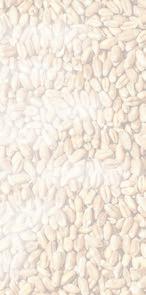


Angus Australia is pleased to announce that Sean Wright and Chloe Plowman have been selected as the recipients of the 2023 Angus Foundation ARCBA Young Breed Leaders Workshop Scholarships.

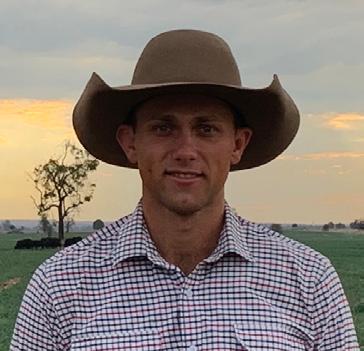


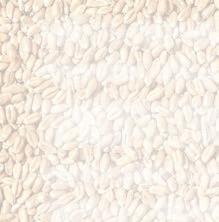
Hosted by the Australia Registered Cattle Breeders Association (ARCBA), the Young Breed Leaders Workshop draws together young leaders from Australian Beef Breeds to engage, develop and prepare them to build a solid network of skilled future leaders of the beef industry.
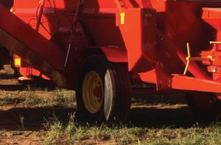
Through the scholarship opportunity, Sean and Chloe will take part in the twoday workshop in Brisbane, Queensland, alongside other young people in the industry. The workshop, which will be hosted from the 24th to the 25th of October, is designed to inspire and prepare the up and comers in the beef industry for senior management roles.
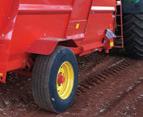







“We are pleased to have Sean and Chloe representing Angus Australia at the ARCBA Young Breed Leaders Workshop,” said Angus Australia Extension Officer Nancy Crawshaw.
“We hope that through this opportunity, Sean and Chloe will have the ability to upskill themselves and broaden both their professional and personal development.”

“Through what they are able to take away from the workshop, we hope that they are both better placed in their ability to take on leadership roles in industry and are able to widen their professional network through engaging with industry professionals.”

Meet the Recipients

Sean Wright








Ambitious, enthusiastic, and energised to create positive change in Northern beef production systems would be the ideal way to describe Sean. He has bold ideals which he believes could successfully challenge the status quo of northern production systems for the betterment of producers and breed societies. Sean hopes to attend the ARCBA Workshop to learn skills which could be beneficial when and if selected on boards and committees in the future to assist in creating and ideally implement some of the ideas and concepts into practice within breed societies and industry.
Chloe Plowman
Chloe Plowman is 20 years old and currently working as a Junior Real Estate & Livestock Agent in Kingaroy QLD. She has a strong passion for showing cattle and wanting to encourage other young ones to get involved in the industry. Majority of her time outside of work and showing cattle is spent on her family farm, which is a beef cattle operation breeding stud Angus cattle, consisting of 70 Breeders, retaining heifers and selling 20+ bulls each year. The family also has a commercial operation consisting of Angus x Cows & Calves. Chloe lives & works in the agricultural industry, and it is where she not only sees her future, but where she knows her future will be.
| 41 The Angus Bulletin - Spring 2023
• Rololl & mi x fuull l rat a i ion • H anddles e all l grarain i s • Prereci ci siion on c h hoop p le l ng n
o of fibbro
odu d ct t c
th h t
ous pro
usto t mi se youur r op i ti t on s
Varrio i us dissch h c arge e el e evat a or o s to suiit a all ap appl p iccat a ioons s QUEENSLAND MACHINERY AGENCY 07 4696 3350 | 0447 965 555 QMA.NET.AU Nobby Qld 4360
ROLLERMILL
• C
•
SEKO
Knowla Raises $40,000 for the Angus Foundation
Cheyne Twist, Senior Marketing & Communications Officer
In an act of great generosity by both vendor and purchaser, an amazing $40,000 was raised for the Angus Foundation at the recent Knowla Livestock Sale, hosted Friday July 28th.

The donation, raised from the proceeds from the auction of a heifer at sale, will go directly to funding scholarships, awards and bursaries to support the ongoing development of young emerging members of Australian beef industry and the Angus breed.
Pledging the proceeds from the sale of Knowla Kruger T12PV (BLA22T12), the Laurie Family knew that the heifer they were selling was something special, committing an animal they knew would have an impact on any herd she would enter.
Purchased by Cooper Clarke of Northwest Pastoral Angus, Scone, and his father Shane for Cooper’s recently developed seedstock operation, the heifer was a standout for the pair, with the contribution to the Angus Foundation through their purchase a bonus in their eyes.
“Her numbers were outstanding EBVs wise, she was a very feminine heifer and I reckon she'll grow into something nice,” said Cooper.
“With the money for the purchase going to a good cause, making opportunities potentially for me in the future going down the path with Angus, it's something I really look forward to in the future and it builds our operation at home.”
Return buyers to Knowla, the Clarke’s have plans for their new purchase and will look utilise the heifer to expand their cattle operation into the future.
“We'll wait until she calves and will then probably send her down to Holbrook to get her flushed and get embryos in the tank. We will then see what bulls would be best for her matchings and go from there,” said Cooper.
Knowla Livestock Co-Principal James Laurie was happy to see a heifer the family held in high regard go to an operation with a young person at the helm, highlighting that creating opportunity for young people in the industry was the driving objective for their donation.
“We think she's a really special heifer, and if we weren't donating for the Foundation, we wouldn't have given her away. However, we just thought if we are going to do it, we’re going to do it properly,” he said.
“We are just delighted that she is going to Cooper and his father Shane, with only a newly established stud and now they've got access to some of our top genetics. We're going to love working with them and watching as she performs, and we're just delighted that she's gone to a small established stud that can really utilise her to get their program going.”
James continued, “It’s great that Cooper’s been driving Northwest Pastoral and while I know his father might be paying the bills at the moment, Coop is driving it and it’s really good to get a young guy establishing a stud, getting a really top heifer and knowing that he might get the opportunity
to take advantage of some of the bursaries or scholarships in a year or two. It’s a winwin, I think.”
For Angus Australia Extension Manager Jake Phillips, the donation was one that held great promise for the continuation of providing excellent and industry leading opportunities for young people in the industry.
“We would like to thank the Laurie Family greatly for their tremendous support for our program. This donation will go far in the way of continuing the various initiatives that the Angus Foundation has in place, as well as helping us to continue to establish new ways to support the young people in our industry.”
“Without incredibly generous contributions like this one, we simply would not be able to do what we do through the Angus Foundation. The support shown through these contributions directly impacts the opportunities we can provide the young and emerging members of our great industry.”
The Angus Foundation provides a mechanism for members and other beef industry stakeholders to support youth development, education and research programs conducted by Angus Australia. These programs are designed to encourage and assist the involvement of young people in the Australian beef industry, to provide professional development opportunities for young beef breeders, and to assist in
Angus Youth 42
Brian Kennedy, Elders Stud Stock, Dubbo, Cooper Clark, Jack and Georgie Laurie Knowla Angus, Allan Laurie and Paul Dooley
conducting research, development and educational programs for the benefit of Angus breeders and the wider Australian beef industry.
Someone with a deep understanding of the impact of opportunities provided through the Angus Foundation and its benefactors was Angus Australia President and Board Chairperson Erica Halliday, who herself was is a product of the Angus Youth program and a beneficiary of scholarship opportunities afforded through the program.
“This has been a very generous offer from the Laurie family of Knowla and comes straight off the back of them purchasing the Dulverton Angus Foundation heifer, donated by the Chappell family, for $16,000 alongside Jason Strong.” Scan the QR code to read more about this.


“The reason that they are donating to the Foundation is for Angus Youth and for all the programs and the scholarships, awards and bursaries that they conduct every year. People like Greg Chappell, Jason Strong and myself have all been part of those programs.”
Touching on the reach and impact of the opportunities provided through the Angus Foundation, Erica continued, “At the ‘Beyond the Beef’ Zoetis Angus National Conference earlier this year, we actually had a panel of both people that had won scholarships, awards and bursaries in the past or been a part of Angus Youth and it was mind blowing. They were the most creative, inspirational young people and this is what we're raising the money for, to get young people back into the beef industry and keep doing all the great things that they're doing.”
The Angus Foundation provides a mechanism for members and other beef industry stakeholders to support youth development, education and research programs conducted by Angus Australia.

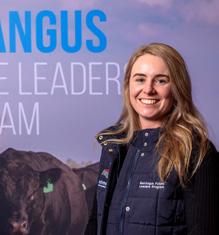
These programs are designed to encourage and assist the involvement of young people in the Australian beef industry, to provide professional development opportunities for young beef breeders, and to assist in conducting research, development and educational programs for the benefit of Angus breeders and the wider Australian beef industry.
Recent programs the Angus Foundation has supported include GenAngus Future Leaders Program
Angus Foundation Cadetship
TransTasman Travel Bursary
· Tocal Beef Cattle Assessment School


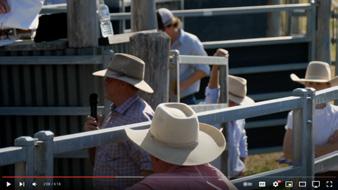
· LIVEXchange Conference
· BeefEX Conference

Beef Australia Scholarships
Angus Foundation Research Grant
THE ANGUS FOUNDATION FUNDING THE FUTURE OF THE BEEF INDUSTRY
These opportunities have changed the lives of dozens of young Angus members by providing opportunities to them they may not have otherwise had.
| 43 The Angus Bulletin - Spring 2023
SCAN TO WATCH
Knowla Raises $40,000 for the Angus Foundation
Scan to read 'Producers dig deep for the angus foundation
Insight into agricultural insurance

Cheyne Twist, Senior Marketing & Communications Officer
An “eye-opening experience” was how William Richards described the inaugural Achmea Australia Angus Foundation Cadetship, a program deeply aligned to the insurer’s purpose of keeping farmers farming.
Over the course of four weeks, William immersed himself in the operations of the specialist farm insurer, experiencing key aspects of the company including getting out on-farm and into agricultural communities.

Hailing from Southeast Queensland, William applied for the Achmea Australia Cadetship looking to gain a greater understanding of how farm insurance plays an integral role in supporting the agriculture sector.
“Being in my final year of university, I have made many connections and gained industry experience through the program,” said William. “There are few opportunities that expose you to a unique business such as Achmea Australia, where you can gain insights into many parts of the company.”
William began his cadetship in Achmea Australia’s Sydney branch, learning about the behind-the-scenes processes and operations.
“Over the course of the first two weeks, my goal was to learn as much as possible,” William explained. “Coming in with a basic understanding of insurance, I was able to develop a greater appreciation of all the components involved with developing a farm insurance quote for a customer.”
“As I progressed through the Client Experience, Marketing, IT, Risk, Claims, and People and Culture teams, I was able to learn how each team contributes to the business.”
Experiencing the day-to-day operations through the eyes of an employee, William was able to work and connect with a diverse group of people in the organisation, all eager to share with him further insights into the role of Achmea Australia in the agricultural industry.
“There were new employees starting during my cadetship and I was able to join their training sessions, which provided me with the opportunity to learn more about the company, their insurance products, and the industry,” William said.
“Meeting with Achmea Australia’s management team also gave me a greater understanding of some industry-level issues, as well as the future goals of the business.”
Towards the end of his time in the Sydney branch, William hit the road and travelled to the South Coast of NSW, before heading off to Victoria to spend time on-farm with some of Achmea Australia’s Farm Insurance Specialists.
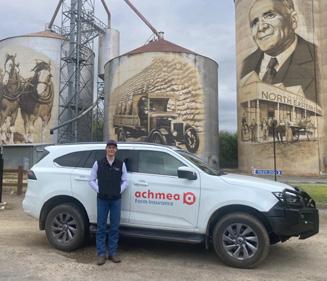
“During the second two weeks of the cadetship, I headed to Victoria and started down in the Gippsland region, following and learning from a Farm Insurance Specialist to better understand Achmea Australia’s direct approach to insurance,” said William.
“Achmea Australia walks the farm with the client and talks with them to understand their business and what insurance needs they have. Through multiple farm visits, I gained a good understanding of the farm review process and the information required to prepare a quote for the client.”
In addition to seeing how Farm Insurance Specialists interact with producers during their initial farm visit, William was also able to join them at a key agricultural event, supporting the industry and connecting with the local community.
“I also attended the Sheep and Wool Show in Bendigo, where I met many Achmea Australia clients and potential clients" said William.
“It was great to learn more about the wool industry and see how Achmea Australia attends events as a way to support the agricultural sector, connect with the community and promote their role as a specialist agricultural insurer.
“Towards the end of my cadetship, I was based in Cobram, travelling between New South Wales and Victoria. During this time, I was able to see quote presentations, first farm visits and policy renewals of many different farms, as well as both small and large operations.”
Reflecting on his time as a cadet with Achmea Australia, William felt he’d had a well-rounded experience, with opportunities to further his understanding of the insurance industry and its role in agriculture, as well as challenges that encouraged him to push himself and learn more.
“I gained knowledge during these four weeks - such as understanding the insurance industry and the business of Achmea Australia - on a level not many would get to experience,” said William.
“The client meetings allowed me to further develop many skills, such as communication and how to interact with a wide range of clients with diverse backgrounds,” he said.
As part of the cadetship offering, William also took part in the Marcus Oldham Rural Leadership Program, which is an intensive five-day workshop conducted on the college campus in Geelong.
“The Rural Leadership Program held at Marcus Oldham College was a great week where I learnt the foundational skills of what leadership is and many exercises that allowed us to put what we were learning into practice,” he said.
“With great speakers and other attendees from across Australia, it was great to make connections and hear other stories of leadership challenges and as a collective how to overcome them.”
William encouraged others with a similar ambition - to build their network and progress their personal and professional
I gained knowledge during these four weeks - such as understanding the insurance industry and the business of Achmea Australia - on a level not many would get to experience
Angus Youth 44
“ “
development - to consider the cadetships available through the Angus Foundation and the Angus Youth Scholarships, Awards and Bursaries Program.
“I would definitely encourage anyone thinking of undertaking a cadetship to take the jump and apply next year,” William said.
“The exposure and opportunity for development was incredible, and for


anyone looking to experience a key part of the agricultural industry, Achmea Australia has certainly shown me another side to insurance. It was great to meet the other recipients at the Marcus Oldham Rural Leadership Program and continue to connect after our cadetships were over.

“I would like to thank the Angus Foundation for providing me with the ability to undertake this cadetship, and
Right Image: Josie Cox (AuctionsPlus Cadet), Will Richards (Achmea Australia Cadet) & Chloe Plowman (NH Foods Australia Cadet), all attended the Marcus Oldham Rural Leadership Course
to Achmea Australia for the opportunity to explore their business and learn an abundance in an industry I previously didn’t have much insight into.”

| 45 The Angus Bulletin - Spring 2023
VEZINA BEEF AD AUG23 A5.indd 1 20/8/2023 1:17 pm
Josies’ behind the scenes look into AuctionsPlus
Cheyne Twist, Senior Marketing & Communications Officer
One can expect that four weeks working at Australia’s Digital Ag Market would be busy, which happens to best summarise Josie Cox’s experience as the 2023 Angus Foundation AuctionsPlus Cadet.
Spending a month working throughout the company, the Angus Foundation AuctionsPlus Cadetship was designed to provide Josie hands-on experience in the agribusiness, experiencing firsthand the day-to-day operations of the company and learning how it services the beef supply chain.
Developing a unique understanding of how the business works and the central role of the platform in driving innovation within the agricultural industry, Josie was definitely pleased by her experience and greatly enjoyed her time spent working out of the Sydney based outfit.
“It has been a fantastic experience for my overall learning of the corporate side of agribusiness,” she said. “I did not expect to love working in an office as much as I do now.”
To kick off her cadetship, Josie spent her inaugural week with the Market Operations and the Market Insights teams, which gave her a foundation for her understanding of how the business operated.
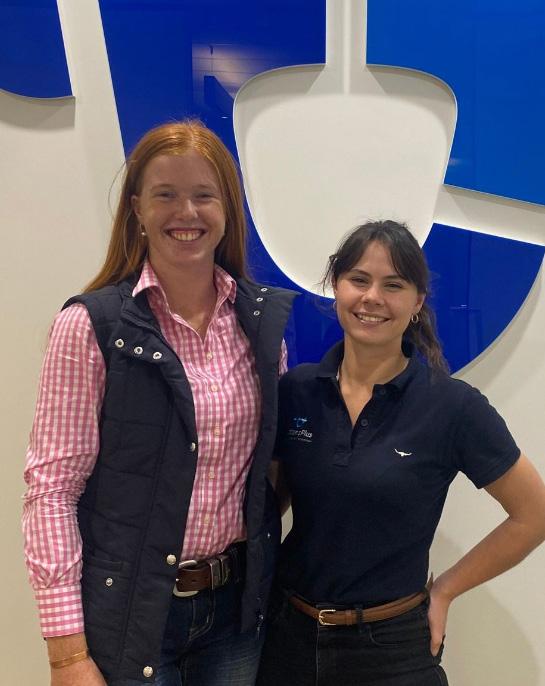
“This was an excellent insight into the hard work of creating and designing the ability for online bidding with integrated and continuous sales,” explained Josie.
“Learning the ins and outs of the creation and building of the catalogues and sales of the auctions online was a lot more process and consumer interaction than I expected, and it is a great way to see how the AuctionsPlus team are very customer based and always wanting to improve the customer experience.”
Continuing her way through the different roles that make up the company, Josie began working with the Marketing and Network teams, which gave her further insight into the reach of the company network.
“Throughout the second week of my placement at, I had seen that 60% of the business is the basic idea of selling livestock on the web,” she said.
“Still, a percentage of the company is expanding beyond that and ensuring a whole customer experience throughout the website. I spent three days with the Marketing team in Sydney and I had the pleasure of working on projects to help understand what the typical AuctionsPlus user wants to view and how effective the different types of communication and platforms are for the user.”
She continued, “In the latter part of the week, I got the pleasure of working with the Network team, which are the forefront of the communication between the business and the hundreds and hundreds of stock agents who engage in the platform for their clients and all the stud and large commercial sales. This is an essential role as they are the people who attend events and represent the company throughout Australia.”
Reflecting on the halfway point of her cadetship, Josie said, “During week three, I was able to experience the projects which are taken on by the Product team.”
“The Product Team are three men who evaluate and help process the products of the business, which include the user experience and the upkeeping of the website in an effort with the Dev team,” she said.
“I spent a bit more time with Market Operations and Network teams, helping run sales and understanding the process in the Network team to attract and keep clients within their regions, what events they run, and the selection process.”
To conclude her experience, Josie got out on the road with the AuctionsPlus team to visit Dubbo for the National Shorthorn Show and Sale and over a number of days was able to get an understanding of how the team functions on ground at events.

“For two days we visited the Show and were able to meet the auctioneers and agents whilst also seeing vendors,” said Josie.
“We also visited Nutrien Dubbo and talked to the agents within the company about updated programs throughout the AuctionsPlus platform. Sale Day was a fantastic day, with the top price bull selling an international Shorthorn record of $106 000.”
She continued, “It was a fantastic experience to learn the behind-the-scenes AuctionsPlus programming for sales on the ground and behind the scenes in Sydney. Being able to bid on the ground at the sale was a great way to understand the importance of the platform's presence at the sale.”
Following the completion of her cadetship it was clear that Josie had made a lasting impression with AuctionsPlus, being offered a job with the company, a role she is currently working in.
In reflection of her time as the AuctionsPlus cadet, Josie believes that the opportunity gave her the chance to grow within the experience and learn as much as she could from those who she worked with during her placement.
“I want to thank the whole team at AuctionsPlus for being so welcoming and understanding for my placement within their company and the range of teams I was fortunate to work with,” she said.
“I would also like to thank Angus Australia for the fantastic experiences they offer for the youth within the society and the range of ways people can make an impact in the agricultural community, from the city offices to the ground on the farm.”
Angus Youth 46
Josie Cox & Bonnie Cox
Josie Cox, Hugh Courts and Rosie Mayne at the National Shorthorn Show and Sale another image attached Josie Cox with 2022 Cadet Bonnie Cox. Image: AuctionsPlus
Out and About
A: Angelique Ottevanger, Phillip Heath, Marnie Te Aho, Luke Foster, Emma Thomas, Jake Phillips, Pieter Louter, Anne-Sue Renout, Danielle Whitelock, Mario Sita, Yan Geredov and Ilse Van de Meent. Jake provided an update on the impact of Achmea Australia’s involvedment to the Achmea Leadership Team, B: Angus Australia, General Manager – Genetic Improvement, Christian Duff, Sinclair Munro Booroomooka Angus, Michael Graham, General Manager for Central Region – Paraway and Richard Puddicombe, Burindi Manager – Paraway, at the Paraway Pastoral Co field day, Getting Started Towards Net Zero” day at Burindi Station, Banoon NSW., C: PJ Budler William McLaren and Erica Halliday juding at the World Angus Secretariat Show in Czechia, E: Peter Inmon, Andrew Shofay, Lochlan Alexander, Robert Mackenzie of Macka's Beef, and Terry Donahue, celebrate winning the Regatta Hotel's Annual Beef Off during the Royal Queensland Show, E: Tom Stier, JBS, Aimee Bolton and Jack Whyte, JBS, Liz Pearson, Angus Australia and Richard Saddler, JBS at the Angus Australia and JBS Producer Evening in Armidale


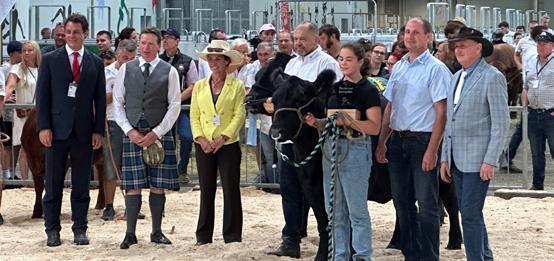

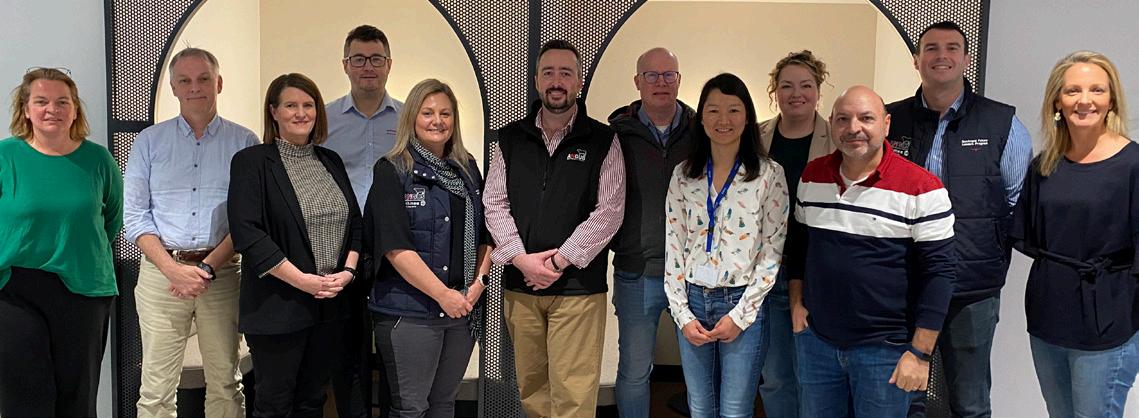
| 47 The Angus Bulletin - Spring 2023
A B C D E
An advanced genomic tool to inform the selection of replacement heifers for commercial Australian Angus breeders

A product of Angus Australia, delivered in collaboration with our partners, Zoetis and Neogen

www.angusaustralia.com.au





48
Member Service Matters
 Adam Allingham – Member Services Manager (Acting)
Adam Allingham – Member Services Manager (Acting)
Hello everyone, and welcome to my second edition of "Member Service Matters" Spring edition!
As the weather warms up outside, our team continues to stay active and engaged as we welcome numerous new members to the "Angus Family”.
Undoubtedly, the sale season is now in full swing. We are witnessing a remarkable surge in Registrations, Inventories, Transfers, Performance data, and Genomic testing. These past few months have been a whirlwind of activity. On behalf of the Member Services team, I extend my heartfelt gratitude to all of our members. Your commitment to submitting your work during this period, while also managing the demands of preparing for your animal sales, does not go unnoticed. We recognize the challenges you face and commend your unwavering dedication and commitment to maintaining the high standards of the Angus breed.
Furthermore, I'd like to express my gratitude to our dedicated MSO team who have shown immense diligence during what has proven to be the most bustling period that Member Services has encountered to date.
GenAngus Future Leaders program

I was fortunate enough to attend the 2023 GenAngus Future Leaders Program at the end of May in Adelaide, SA, alongside the 11 most inspiring emerging leaders in the beef industry I have met to date. The three-day workshop has been the highlight for me this year bringing together industry experts, technology enthusiasts, and thought leaders to delve into the latest advancements, trends, and challenges shaping the future of cattle farming. The program encouraged collaboration, networking, and knowledge exchange, ultimately inspiring myself and the other participants to embrace innovation while honouring the traditions of the industry - while also having a great time. This program should be on every young person’s bucket list to apply for, you definitely won’t regret it!
Angus Week
We have successfully concluded Angus Week, during which our entire remote working Angus Australia team gathered in the office for staff development, the Angus Youth Consultative Committee Meeting & Board Committee meetings. Throughout the week, the MSO team had the opportunity to reconnect with Jake and Nancy from the Extension team, who are engaged in conducting Angus Empower visits in the field. These visits aime to enhance members' comprehension and utilisation of the diverse resources
available within the society. Additionally, they gather invaluable feedback from the membership, enabling us to collaboratively brainstorm more streamlined and effective approaches to our teamwork to service the society and its members to the best of our ability. With the working relationships I personally witnessed over the week, the future of Angus has never looked stronger.
DNA Services

It's truly fascinating to witness the remarkable growth in the DNA space, with an impressive 40% increase in volume compared to the previous year. This expansion holds great promise for maintaining the integrity of the Angus breed and its community members. The recent staff changes have been significant, with Katie Carlon stepping into the role of DNA processing.
Katie's one-on-one training under the guidance of DNA expert Nicky (Carey) Wallace and the profound knowledge of all things Angus by Tammy McLeod, are bound to provide her with the skills and expertise needed to excel in this field. With such dedicated mentors and a solid support system in place, there's every reason to believe that Katie will successfully navigate the challenges of the DNA space and ensure the seamless operation of the DNA pipeline.
The combination of growth, capable leadership, and expert guidance sets a positive trajectory for the society’s DNA endeavours, ultimately contributing to the continued success and advancement of Angus Australia and its members.


MSO QUICK STAT
DNA
Contact
If you have any issues regarding Membership, Registrations, Transfers, Performance Recording, DNA, Export Certification, the Angus Australia website/ angus.tech or any general enquiries please call and speak to one of our Member Service Officers or myself either by email or phone 02 6773 4600.
I’m always happy to hear from members, please feel free to email: adam.allingham@ angusaustralia.com.au.
Best regards,
Adam Allingham Acting Member Services Manager
| 49 The Angus Bulletin - Spring 2023
Job Stats Quarter
2022
Q1&2-2022 Q1&2-2023 Change Membership 3,513 3,917 11% Registration 45,012 47,810 6.3% Female Inventory Autumn 32,279 36,922 14.4% Performance Records 321,843 335,032 4.1% DNA Genomic Tests 34,446 51,055 39% Genetic Conditions 43,138 60,127 33% Turnaround Days DNA 34 24 -34.5% Parent Verification (p/animal) 37,016 50,113 30% DNA >30 Days 44 9.8 -127.1% Job Average Turnaround 1.9 1.8 -5.4%
1
vs 2023
requests have grown 40% in 2023
Adam Allingham at GenAngus 2023
ANGUS

for Northern Australia


Are you looking for information about utilising Angus genetics in the Northern parts of Australia?
For information resources, case studies, support materials and much more regarding the use of Angus genetics in the northern most areas of Australia, check in with the Northern Focus location now! · Improved fertility



Polledness
· Hybrid vigour ·
· Market flexibility · All round balance
Inflation has impacted the agricultural industry, affecting the cost of farming equipment and the value of farm assets.

“With rising input costs, it is important to check whether your farm insurance is up to date to ensure you are adequately covered in the event of a loss,” said Alec Jones, Farm Insurance Specialist with Achmea Australia.
Alec emphasises the importance of regularly reviewing your insurance policy to ensure it provides adequate coverage, especially as your business grows.
“As your agribusiness expands, so does your exposure to risks,” Alec emphasises.
“When it comes to farm insurance, we encourage agribusinesses to consider the rising costs of labour and materials, driven by supplychain shortages and inflation, and how this may impact the cost to replace or rebuild insured items in the event of a loss.
“If your insured sum does not keep pace with your growth and these market-factors, you may find yourself underinsured. This means facing the risk of a shortfall if you need to rebuild or repair your farm buildings, and not having sufficient funds to get your business back up and running,” Alec said.
“As a Farm Insurance Specialist with Achmea Australia, we take the time to get to know your agribusiness and what you value most through our on-farm approach to insurance,” Alec said.
Alec said understanding the common causes of underinsurance can help you avoid the risk. These include:
• Underestimating the replacement cost of your house or farm buildings when nominating your insured sum.
• Not updating your insurance policy to account for market changes or renovations that can increase the value and replacement cost of your insured buildings.
• Increases in labour and building materials after a catastrophe, which can push the cost to rebuild above your selected insured sum.
• Intentionally reducing your insured sum to lower the cost of your premium may cause the insurance cover not to cover the replacement cost.
Talk to Achmea Australia directly about how you can tailor our All-inOne-Farm-Pack to the unique requirements of your agribusiness.
“If you think you might be at risk of underinsurance, now is a good time to check your insurance policy is up to date,” Alec said.
Achmea Australia’s All-in-One-Farm-Pack offers Guarantee Against Underinsurance optional cover, which is available for eligible farm buildings. With this option, Achmea Australia will arrange and pay for the repair or rebuild of your insured building to the same condition as when it was new, or they will pay you the equivalent amount.
“Through Achmea Australia’s purpose of keeping farmers farming, I am passionate about supporting the insurance needs of agribusinesses.” Alec said.
As a specialist agricultural insurer, Achmea Australia supports thousands of agribusinesses across Australia through its cooperative approach to farm insurance.
Contact Achmea Australia today to request a farm insurance quote or appointment. Call 1800 724 214 or visit www.achmea.com.au/switch
To find out more about the strategic alliance between Angus Australia and Achmea Australia, please visit www.achmea.com.au/strategic-alliances
About Achmea Australia
Achmea Australia is part of the Achmea Group, which is one of the largest insurance companies in the Netherlands. The Achmea Group has approximately 13 million clients worldwide and is fully dedicated to farm insurance in Australia.
Insurance issued by Achmea Schadeverzekeringen N.V. (Achmea) ABN 86 158 237 702 AFSL 433984.
The information in this document is general advice only and does not take into account your individual objectives, financial situation or needs (your personal circumstances). This means any advice may not be appropriate for your circumstances. Before using this information to decide whether to purchase the insurance policy, you will need to consider the appropriateness of any general information or advice we give you and how it relates to your specific situation to ensure the insurance cover meets your needs and the relevant Product Disclosure Statement and Target Market Determination (TMD) available from the ‘Downloads’ section of our website achmea.com.au/downloads. For feedback and complaints, visit achmea.com.au/complaints. To view Achmea Australia’s privacy statement, visit achmea.com.au/privacy. Achmea Australia does not warrant that the information contained herein is accurate, reliable, complete or up to date, and, to the fullest extent permitted by law, disclaims all liability of Achmea Australia and its Associates for any loss or damage suffered by any person by reason of the use by that person of, or their reliance on, any information contained in this document or any error or defect in on this document, whether arising from the negligence of Achmea Australia or its Associates or otherwise.

52
Join our growing community of farmers and insure your agribusiness with Achmea Australia www.achmea.com.au 1800 724 214 info@achmea.com.au
the
Have you considered
impact of inflation on your farm?
New Fertility Focus for Angus HeiferSELECT


Jen Peart, Acting Genetic Improvement Specialist
Angus Australia is pleased to announce the next enhancement of the Angus HeiferSELECT product with the inclusion of a Heifer Conception Genetic Prediction.

The Heifer Conception (HC) genetic prediction (GP) was developed in partnership with CSIRO, Australia’s national science agency.
HC describes genetic differences in female fertility based on foetal age at pregnancy diagnosis from yearling Angus joining programs. A heifer with a higher HC genetic prediction value is expected to produce progeny that are more likely to conceive and conceive earlier (i.e., older foetal age at pregnancy diagnosis), than those with lower values.
General Manager of Genetic Improvement
Christian Duff views this development as the latest step in Angus Australia’s ongoing commitment to Genetic Evaluation innovation and providing Angus producers the latest technology for high performing breeding systems.
“Given the importance of female fertility as a profit driver in most commercial operations, the Heifer Conception genetic prediction will allow commercial Angus producers to focus directly on heifer fertility. The application of this research and its inclusion in the Angus HeiferSELECT suite gives users the ability to utilise genomic enhanced genetic predictions in the commercial setting” he says.
Angus HeiferSELECT is designed to aid Angus producers in replacement heifer selection. Through genomic technology, it leverages world leading performance data collated on Angus cattle at Angus Australia to provide genomic based genetic predictions.
There are currently more than 38,000 females that have been tested with Angus HeiferSELECT since its release in 2017. With the addition of the Heifer Conception Genetic Prediction, Angus HeiferSELECT offers genetic predictions on 14 commercial relevant traits, covering cow-calf, fertility, feedlot, carcase and resilience traits.
Angus HeiferSELECT – designed for commercial breeding operations
Angus HeiferSELECT is a genomic selection tool to help inform the selection of Angus replacement females (87.5% Angus content or greater) in a commercial beef breeding operation.
Angus HeiferSELECT provides: Genetic predictions for fourteen (14) maternal, fertility, growth, feed intake, carcase and resilience traits
Genetic prediction for cow-calf value, feedlot-carcase value and total breeding value (with star rating)
Angus BreedCHECK – genomic breed composition prediction
Sire assignment – Possible sires must be registered with Angus Australia and have genomic profiles available
Angus HeiferSELECT is compatible with add-on BVDV testing, facilitating the

identification of animals persistently infected with Bovine Virus Diarrhoea Virus (also known as Bovine Pestivirus).
Angus HeiferSELECT complements other sources of information that may be used in commercial replacement heifer selection, such as phenotypic evaluation, age, weight and pedigree information, and provides valuable insight into the genetic potential of heifers, particularly for traits that are otherwise difficult, time consuming or expensive to measure using traditional methods.
Angus HeiferSELECT has been developed in Australia, by Australians, for use in Australian Angus cattle.
Angus HeiferSELECT can be exclusively ordered from Angus Australia, delivered in collaboration with Zoetis Animal Genetics and Neogen Australasia.

| 53 The Angus Bulletin - Spring 2023
SCAN HERE TO Learn more about Angus HeiferSELECT in the Education Centre



ACCELERATE YOUR ELITE GENETICS Vytelle ADVANCE™ is the in vitro fertilisation process that checks all the boxes. Skip the donor set up, forget the added labour and just bring the cow. Contact Andrew for more information! Andrew Donoghue Andrew.Donoghue@vytelle.com +61 428 442 155 ©2023 Vytelle, LLC. All rights reserved. Vytelle and its logo are trademarks of Vytelle, LLC 01/23 VY230602 » Hormone-free IVF » Outcome-based pricing » Fresh or frozen grade 1 embryos » Ease and reliability of frozen programs » 16 global, operating labs » Now servicing Australia from Brisbane
Collecting Pinkeye Scores for Angus Research
Dr Liam Mowbray, R&D Specialist
Angus Australia would like to invite members to start collecting Pinkeye scores when they have an outbreak of the Pinkeye on farm.
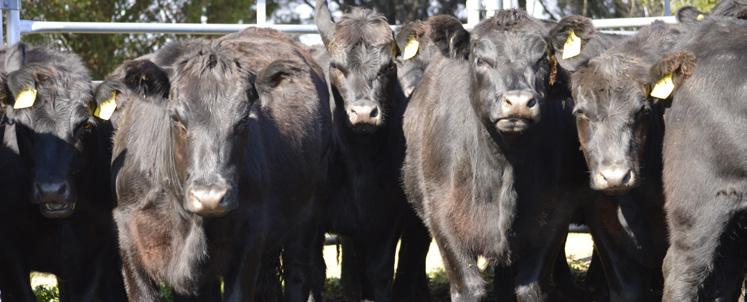

PINKEYE SCORING SYSTEM
0
Unaffected –No pinkeye infection or scaring present
1 Mild –corresponds to tearing
This follows on from a jointly funded study of Pinkeye in Angus Cattle by CSIRO and Angus Australia which was completed in 2022. In the survey, 97% of 238 members who responded had seen Pinkeye in their herd in the past 5 years. Additionally, over 85% of respondents felt that Pinkeye had a moderate or severe animal welfare implication. A pinkeye scoring system has been developed so members can begin to collect information on the genetic aspects of Pinkeye in Angus cattle.
“Pinkeye is a common problem in Angus herds which causes significant welfare implications and economic loss. Pinkeye is a multifactorial disease with many environmental and host factors.

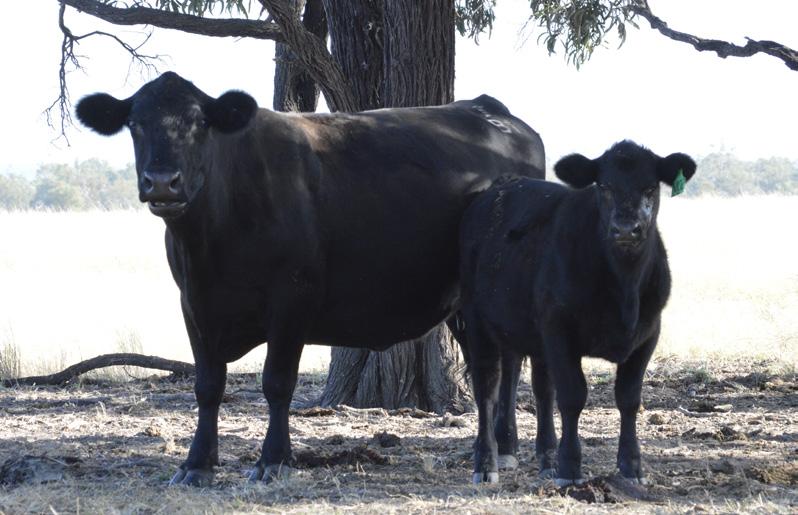
Previous studies have demonstrated a mild heritability between 0.06 and 0.33 in Angus and Angus influenced herds. Therefore, we believe there may be a
small opportunity to play our part and reduce the incidence of Pinkeye in Angus cattle through genetic selection,” Dr Liam Mowbray BVSc (Hons).
Pinkeye scores can be recorded by members if you have a pinkeye outbreak on farm. The scoring system is a 0 to 4 scale. Details can be found on the Angus Australia website under the collection guidelines for Angus research https:// www.angusaustralia.com.au/education/ breeding-and-genetics/collectionguidelines-for-angus-research.
For further information please contact Dr Liam Mowbray from the Genetic Improvement team on 0436406140 or liam.mowbray@angusaustralia.com.au
Watch Video Read more



2 Moderate –corresponds to redness or a small central ulcer
3 Severe –corresponds to severe ulceration or protrusion of the eye
4 Healing/Scar –corresponds to a blue or white eye lesion without tearing or redness which means the eye is healing or a scar has formed

| 55 The Angus Bulletin - Spring 2023
SCAN HERE TO View the Collecting Pinkeye Scores Education Centre Module
Angus Research at 25th AAABG
Malshani Samaraweera, Geneticist
The 25th Association for the Advancement of Animal Breeding and Genetics (AAABG) Conference was held from 26th to 28th July 2023 in Perth.
The conference is widely considered the premier livestock breeding conference in Australia and New Zealand and provides an opportunity for researchers, professionals, and enthusiasts in the field of animal breeding and genetics to get together in two-year intervals to share the latest developments in livestock genetics research.
Eighteen papers showcasing the recent advancements towards the Angus breed genetic improvement were presented at the AAABG conference by Angus Australia staff or Angus Australia’s key R&D collaborators.

A highlight was Dr Pamela Alexandre from CSIRO was awarded the Young Scientist Award in recognition of her contribution in developing the fertility indicator traits for the Angus HeiferSELECT genomic tool. This was the second occasion where the research related to Angus Australia’s genomic tools has been acknowledged. During the 2021 conference, the paper on the development and validation of Angus SteerSELECT was awarded as the Best Animal Production Science Issue Paper.
The 25th conference full proceedings and the papers in Animal Production Science - Special Issue can be downloaded by visiting the websites.
For further information, contact staff at Angus Australia.
Development of female fertility indicator traits for the Angus HeiferSELECT genomic Tool
P.A. Alexandre1, L.R. Porto-Neto1, B.C. Hine1, A.M. Samaraweera2, A.I. Byrne2, A.B. Ingham1, C.J. Duff 2 and A. Reverter1
1CSIRO, 3 Angus Australia
Angus HeiferSELECT is a genomic tool designed to inform the selection of replacement heifers by providing genomic estimated breeding values (GEBV) for traits related to cowcalf production, feedlot performance, carcase quality, and resilience. Here, we explore the incorporation of fertility indicator measures into the gamut of traits using data from 9,155 heifers in the Angus Australia database. The heritability of age at first calving (AFC), days to calving (DC), and pregnancy test measured in weeks (PREG) were 0.25, 0.26 and 0.32, respectively. The three traits were favourably correlated. AFC and DC presented a genetic correlation of 0.45, while PREG presented negative correlations to the other traits (-0.23 and -0.45, respectively). The accuracy of the GEBVs varied from 0.24 for DC to 0.34 for PREG. Although the three traits showed low to moderate heritability and prediction accuracy, phenotypic differences between animals at the top and bottom quartiles when ranking animals based on GEBV demonstrate the positive impact that could be achieved by selecting for improved female fertility in commercial enterprises. The findings from this study have demonstrated that DC, AFC and PREG would all be suitable traits for inclusion in the Angus HeiferSELECT tool.
Angus BreedCHECK – Validation using industry data




C.J. Duff 1, A.M. Samaraweera1, A.I Byrne1, A.B. Ingham2, P.A. Alexandre2, L.R. Porto-Neto2 and A. Reverter2 1Angus Australia, 2CSIRO
Angus BREEDCHECK is a genomic based tool that predicts breed composition for 11 breeds with a focus on Angus content. In this study we compare the Angus BreedCHECK genomic breed composition (GBC) estimates to pedigree-based breed content estimates (PBC) for five animal classes (AC) recorded on the Angus Australia database. The AC populations being Herd Book Register (HBR), Angus Performance Register (APR), Angus Commercial Register (ACR), Angus HeiferSELECT (AHS) and the Multi Breed Register (MBR), including 143,879, 75,369, 6,379,25,710, and 2,780 animals, respectively. Additionally, comparisons were made within a subset of Angus cross Bos indicus (n=1,201) and Angus cross Hereford (n=365) cattle, as determined by PBC, from the MBR. Across the 254,117 animals in this study, there is close alignment in the mean and standard deviation of Angus content as derived by GBC and PBC, with a mean of 99.3% and 99.4% and standard deviation of 3.6 and 4.1, respectively. While 97.7% of the study animals fell within ±10% in Angus content when comparing GBC to PBC. Within the AC populations, and across the sub-set of Angus cross Bos indicus and Angus cross Hereford cattle, close alignment was also observed in the comparative statistics. Using a large industry dataset, this study has validated the precision of Angus BreedCHECK to estimate beef cattle breed content, with an emphasis on Angus content.
Breedplan single-step genomic evaluations delivers increased accuracies across all breeds and EBVs
D.J. Johnston, M.H. Ferdosi, N.K. Connors, J. Cook, C.J. Girard and A.A. Swan Animal Genetics Breeding Unit (AGBU)
Forward cross-validation analyses were used to quantify the changes in BREEDPLAN EBVs from single-step genetic evaluations compared to traditional pedigree-based evaluations for Angus, Brahman, Hereford, Santa Gertrudis and Wagyu breeds. EBVs were generated from full multi-trait evaluations for each breed and compared to EBVs from an evaluation where all the phenotypic records were removed from the last four year drops of animals (termed Validation). Results for the sub-set of validation animals that were SNP genotyped showed the population-based accuracy of single-step EBVs were higher than pedigree-based accuracies for all breeds and traits. However, the magnitudes of the accuracy increases differed across breeds and traits, and generally reflected differences in the size of the training populations for each trait.
Breed Development 56
Full Conference proceedings
Malshani Samaraweera, Geneticist and Liam Mowbray, Research and Development Specialist
The largest increase in accuracy, averaged across all traits in a breed, was observed for Angus (24%) and the smallest for Santa Gertrudis (5%). Across breeds, the largest increases in accuracy occurred for the growth trait EBVs compared to smaller increases for abattoir carcase, female reproduction and NFI EBVs. This study has shown the benefits of single-step genomic evaluations, and the opportunity to increase rates of genetic progress, through the increased accuracy generated. The study also highlighted breeds and traits which could benefit from additional recording to increase accuracies from single-step.

Genomic prediction using imputed whole-genome sequence in Australian Angus cattle
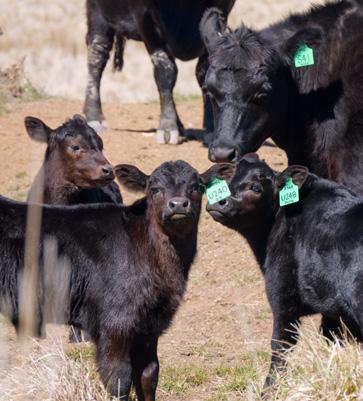


N. Kamprasert1, H. Aliloo1, J. van der Werf 1, C. Duff2 and S. Clark1
1 University of New England, 2 Angus Australia
Using whole-genome sequence data in genomic prediction is expected to improve the predictive ability since the whole genome sequence may contain causal variants. This study aimed to compare the accuracy of genomic prediction with three densities of genotypes, 50k, high- density and wholegenome sequence. The genomic prediction was performed to estimate breeding values for selected growth and carcass traits in Australian Angus beef cattle. Genotype imputation was conducted to retrieve genotypes at high-density and whole-genome sequence level. The dataset was split into testing and reference group to compare the accuracy of breeding values obtained from different genotype densities and for animals with different degrees of relatedness to the reference. The prediction accuracies were similar across three different genotype densities for the traits studied. We found no substantial improvement in genomic prediction accuracy using the whole-genome sequence data in this study.
Faecal microbiota of Angus cattle with divergent immune competence
B.N. Maslen1, B.C. Hine2, C. Duff 3, P.A. Alexandre2, S.A. Clark4, J.H.J van der Werf4, J.D. White1 and S.D. Pant1
1Charles Sturt University, 2CSIRO, 3 Angus Australia, 4 University of New England Microorganisms inhabiting the gut (gut microbiota) have been shown to influence immune responsiveness of the host in a variety of species. It has also been discovered that specific species of gut microbiota may contribute to immunity in multibreed cattle. In this study, faecal samples were obtained from Angus cattle that were concurrently phenotyped for cell-mediated and antibodymediated immune responsiveness (IR) at weaning. Both IR phenotypes, and an ImmuneDex score, were calculated and used to identify high, medium and low IR cohorts (n=20/group). 16s rRNA gene sequence data was used to infer the relative abundances of different phyla in the sampled animals. A total of 6 phyla were found to significantly differ in relative abundances for at least one of the IR phenotypes. Of these, Bacteroidota, Euryarchaeota and Proteobacteria may be biologically relevant due to their relationship with gut health and disease.
On the value of adding commercial data into the reference population of the Angus SteerSELECT genomic tool
Antonio Reverter1, Laercio Porto-Neto1, Brad C. Hine1, Pamela A. Alexandre1, Malshani Samaraweera2, Andrew I. Byrne2, Aaron B. Ingham1 and Christian J. Duff 2 1CSIRO, 2 Angus Australia
Angus SteerSELECT is a genomic tool designed to provide genomic estimated breeding values (GEBV) for nine traits related to growth, feedlot performance, carcase characteristics and immune competence. At present, GEBV for carcase characteristics are based on a reference population of 3766 Australian Angus steers. We aimed to investigate the potential benefit of incorporating commercial data into the existing reference population of the Angus SteerSELECT. To this aim, we employ a population of 2124 genotyped commercial Angus steers with carcase performance data from four commercial feedlot operators. Commercial feedlot operators finishing animals with a strong Angus breed component will benefit from having their data represented in the reference population of the Angus SteerSELECT genomic tool.



| 57 The Angus Bulletin - Spring 2023
Genetic evaluation of coat type for Australian Angus
A.M. Samaraweera1, H. Aliloo2, A. Byrne1, C.J. Duff 1 and S.A. Clark 2 1Angus Australia, 2University of New England
Animals with sleeker coats are commonly considered to have better heat tolerance, tick resistance, and a lower incidence of dags in feedlot environments. The objective of this study was to estimate genetic parameters for coat type traits and to estimate genetic correlations between coat type and scan and carcass weight traits using single-step methods. Two coat type traits were defined based on the month of scoring where scores recorded in April to October were considered as coat type 1 (CT1) and those recorded in November to March were categorized as coat type 2 (CT2). The coat type traits were moderately heritable, and the heritability of CT1 (0.36 ± 0.04) was higher than CT2 (0.32 ± 0.03). Genetic correlations between coat type traits and steer and heifer ultrasound scan traits (eye muscle area, intramuscular fat) were either low to moderate in strength, but favourable in direction. The outcomes of this study suggest selection for sleeker coat type is possible without any associated detrimental effect on scan and carcase traits.
Appropriateness of combining carcass data from Angus sire benchmarking program and breeder herds in a single genetic evaluation
A.M. Samaraweera, A. Byrne and C.J. Duff Angus Australia
The objective of this study was to investigate whether the two different sources of abattoir carcass phenotypes that are currently submitted for inclusion in the TransTasman Angus Cattle Evaluation are genetically the same trait, being abattoir carcass phenotypes measured on cattle in the Angus Sire Benchmarking Program (ASBP), and abattoir carcass phenotypes measured on Angus animals in breeder herds. The abattoir carcass traits used were carcass MSA marble score (CMMS), carcass fat depth at p8 rump site (CP8, measured in mm), and dressed carcass weight (CWT, measured in kg). Additive genetic correlations between the same traits across the two sources were estimated with bivariate animal models. The additive genetic correlations for CP8, CMMS, and CWT were 0.99 ± 0.17, 0.84 ± 0.24, and 0.73 ± 0.23, respectively. Therefore, the two different sources of abattoir carcass phenotypes can be considered genetically to be the same trait and can be included in a unified genetic evaluation as the same trait.
Longevity of reference populations in a trans-Tasman genetic evaluation:
Review of the Angus Sire Benchmarking Program


S.F. Walkom1, C.J. Duff 2, C. Girard1 and K. Moore1
1Animal Genetics Breeding Unit, 2 Angus Australia


The Angus Sire Benchmarking Program (ASBP) remains the cornerstone genomic reference behind Angus Australia’s TransTasman Angus Cattle Evaluation (TACE). The success of industry funded genomic reference populations depends on the ability to maintain a strong relationship of the seedstock population with the sires selected for the reference population. Results from a review of the ASBP show that, for hard to measure traits (eg. feed intake), the ASBP is influencing the accuracy of breeding value estimation across the registered population. However, the evolution of the genetic make-up of the Trans-Tasman herd means that the continued collection of hard to measure phenotypes via the ASBP or similar programs is essential.

Breed Development 58
Age at puberty, days to calving and first parity return to oestrus in Australian temperate beef breeds

K.A. Donoghue1, R. Rippon1, M. Wolcott 2, K.L. Moore2, S.A. Clark 3 and B.J. Walmsley1,2 1NSW Department of Primary Industries
2 Animal Genetics and Breeding Unit, 3 University of New England


Heritability and repeatability of paternal haplotype recombination rate in beef cattle autosomes
M.H. Ferdosi1, S. Masoodi2 and M. Khansefid3
1Animal Genetics Breeding Unit, 2University of Payam Noor, 3 Agriculture Victoria
Validation of calving ease EBVs examining the impact of genetic groups and single-step on predictive ability
P.M. Gurman, L. Li, M.G. Jeyaruban, D.J. Johnston, C.J. Girard, and A.A. Swan Animal Genetics Breeding Unit

New module for prediction of reproductive traits EBV in Breedplan







M.G. Jeyaruban and D.J. Johnston Animal Genetics Breeding Unit
Approximating prediction error variances and accuracies of estimated breeding values from a SNP–BLUP model for genotyped individuals
L. Li, P.M. Gurman, A.A. Swan and B. Tier Animal Genetics Breeding Unit
Immune competence and micro-environmental sensitivity
M.D. Madsen1, J.H.J. van der Werf 1, A. Ingham2, B. Hine2, A. Reverter2 and S. Clark1
1 University of New England, 2CSIRO
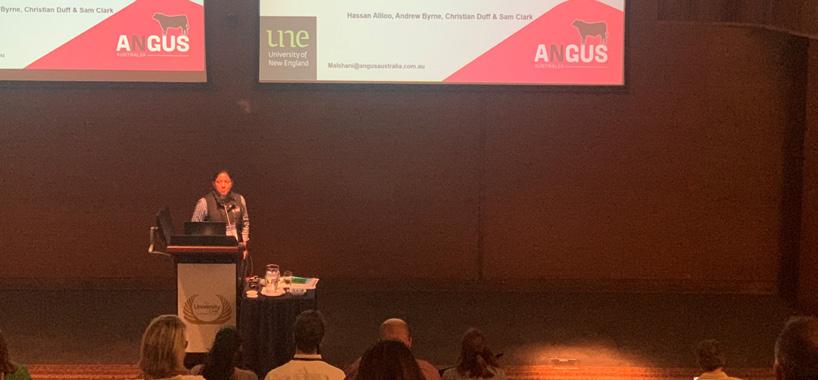
Livestock breeding, where have we been and what lies ahead?
S.P. Miller, Animal Genetics Breeding Unit
Remodelling the genetic evaluation of NFI in beef cattle - Part 1: Developing an equivalent genetic model
L.Vargovic1, K.L. Moore1, D.J. Johnston1, G.M. Jeyaruban1, C.J. Girard1, J. Cook1, J.A. Torres-Vázquez2 and S.P. Miller1, 1Animal Genetics Breeding Unit 2University of Maryland
Remodelling the genetic evaluation of NFI in beef cattle - Part 2: Shortening the length of the feed intake test
L.Vargovic1, K.L. Moore1, D.J. Johnston1, G.M. Jeyaruban1, C.J. Girard1, J. Cook1, J.A. Torres-Vázquez 2 and S.P. Miller1
1Animal Genetics Breeding Unit, 2University of Maryland
| 59 The Angus Bulletin - Spring 2023
A few other interesting papers presented at the AAABG conference.
Update on the Trends of Angus Genetic Conditions
Dr Liam A. Mowbray, R&D Specialist
It’s been ten years since the identification of the Developmental Duplications (DD) recessive genetic condition. Therefore, it is timely to review the current landscape of genetic conditions in the Angus Australia recorded population.
The primary outcome is the frequency of all the main monitored genetic conditions now occur at low levels in the Angus population. This is a result of focused DNA testing, monitoring and selection by Angus breeders, particularly seedstock producers.


What are genetic conditions?
Genetic conditions in cattle are conditions that result from DNA abnormalities. Each of the major genetic conditions that are monitored by Angus Australia has potential economic significance to both commercial and seedstock Angus producers via calf mortality, calving difficulties, and loss of production. Subsequently, these genetic conditions are reported and monitored in the Angus Australia recorded population and published on the angus.tech database.
Re-cap on the genetic conditions
The main monitored genetic conditions are:
Arthrogryposis Multiplex (AM) – Also known as ‘curly calf’. This genetic abnormality results in poor muscle and joint development in utero. The spine and joints are often ‘curled’ or twisted. While the hind limb joints are often rigid and extended. The condition is lethal.
Contractual Arachnodactyly (CA) – also known as ‘fawn calf syndrome’. Calves will typically be born alive with their back legs set behind them and an arched spine. Most of these animals survive to maturity but are often slow growing.
Developmental Duplications (DD) – in its most extreme presentation, DD can result in the formation of additional limbs, skin flaps, duplication of facial features and body wall closure defects.
Neuropathic Hydrocephalus (NH) – A lethal condition where the calf is still born with an enlarged, fluid-filled head that does not contain any recognisable brain or spinal cord tissue.
Several other less common genetic conditions also exist. These are osteoporosis (OS), Dwarfism (DW), Alphamannosidosis (MA) and Oculocutaneous hypopigmentation (OH). Further reading on these can be searched on the Angus Australia website https://angusaustralia. com.au/education/breeding-and-genetics/ genetic-conditions-in-angus
How are the genetic conditions inherited?
All genetic conditions monitored follow a single recessive gene mode of
inheritance. When we consider this mode of inheritance, animals with one recessive gene are called carriers and are not affected by the condition. If the dam and the sire are both carriers there is a chance the resulting progeny will receive the ‘defective’ gene from both parents, then the progeny will be affected.
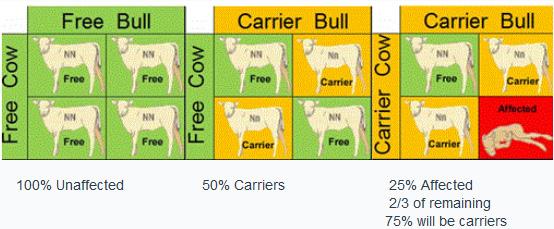
Where are we at with Genetic Conditions?
GeneProb software utilizes pedigree information and the DNA test results for genetic conditions to calculate the probability of an untested animal to be a carrier (GeneProb%). Since testing commenced, the carrier frequency of the four major genetic conditions in the Angus Australia recorded population has reduced considerably (see figure 2). Most notably, has been the decline of DD carrier frequency since 2013.
Breed Development 60
Figure 1: possible outcomes from mating combinations for single recessive gene conditions
Interestingly, testing for the four major genetic conditions has been at an alltime high in recent years, likely due to bundling of Angus Australia DNA services. Meanwhile, the number of animals testing positive for carrier status for all conditions has continued to decline
This is particularly evident when we look at the proportion of animals who test positive for carrier status in both (i) the population of animals tested, and (ii) the total number of calves born each year. This is most evident with regards to Developmental Duplications (DD) as seen in the graph below (Figure 3). However, the same trend is present also for AM, CA and NH.
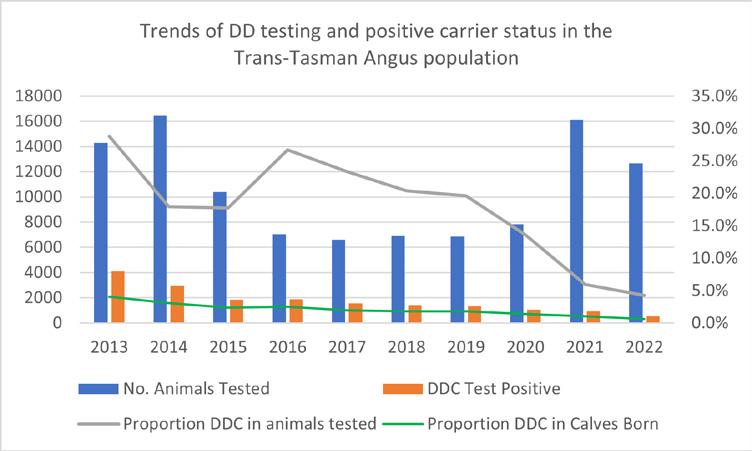

Where to from here?
The Angus Australia community has come a long way in reducing the number of genetic condition carriers in the registered Angus population. Continuing to test animals for carrier status is likely to ensure the prevalence of these conditions continues to fall. Targeting this testing towards animals with a GeneProb% is encouraged.

Lastly, there is always the potential for the discovery of new genetic conditions in the future. If something abnormal is noticed, we encourage members to contact their local cattle Veterinarian.
Scan to read more

| 61 The Angus Bulletin - Spring 2023
Figure 3: Trends of DD testing and positive carrier status in the Angus Australia population
Figure 2: frequency of genetic condition carriers in the Angus Australia June 2023 Genetic Benchmarking Report
Feedlot and carcase competition success in
Queensland and New South Wales
Diana Wood Marketing & Communications Manager
Angus and Angus Influenced cattle reaped the awards in two of Queenslands largest commercial cattle competitions, the Sydney Royal Beef Challenge, with the breed continuing to show its strength in commercially focused cowmpetitions.

Central Queensland Carcase Classic brings success
Angus influenced cattle had success at the 16th annual Central Queensland Carcase Classic as Tayglen Pastoral Company took out multiple awards.
Ted and two of his sons Shane and Paul Murphy were on hand at the awards night in Rockhampton to find out how their Charolais Angus cross genetics had performed.

It was a night of celebration for the Tayglen team as they were awarded, Grand Champion Carcase, Champion and Reserve Champion Grainfed Carcase, Champion and Reserve Champion Grainfed Pen, Reserve Champion Grassfed Pen, Most Even Pen and Most Successful Exhibitor with their Charolais Angus cross steers. The Grand champion carcase award went to a steer from a pen of three entered into the grainfed four tooth steers or heifers (300-420 kilograms CW) class.
The steer also won champion grain fed carcase with158.28 points, and had a 376.4 kg hot standard carcase weight, 95 square centimetre eye muscle area, 13mm P8 fat, 15mm rib fat and received an MSA score of 64.81.
Namgooyah Grazing Co also achieved success at the event again, with an Angus cross steer receiving Champion Feed on Steer.
Carcase quality in 2023 Paddock to Palate
From almost 900 cattle entered in the RNA Paddock to Palate Competition, Angus and Angus Influenced cattle have once again risen to the top, particularly when it comes to carcase and MSA Eating Quality.
The Paddock to Palate Competition is a three phased competition and incorporates feedlot weight gain, carcase competition and MSA Eating Quality awards and culminated in an awards night during the EKKA.
Class 37 – 100 Day HGP Export Class
Class 37C Eating Quality
1st – Don McCrae, Angus
2nd – Russell Pastoral Operations, Angus Cross
Class 37C Highest Individual Index ScoreDon McCrae, Angus
Class 38 – 70 Day HGP Trade Class
Overall
1st Aurelian Pastoral, Angus x Ultrablack
2nd Russell Pastoral Operations Pty Ltd, Angus Cross
3rd Russell Pastoral Operations Pty Ltd, Angus Cross
Class 38A Weight Gain
2nd Russell Pastoral Operations Pty Ltd, Angus Cross
3rd Aurelian Pastoral, Angus x Ultrablack
Class 38B Champion Carcase - McIntyre Agriculture Pty Ltd, Angus
Class 38B Reserve Champion Carcase
Minnamurra Pastoral, Speckle Park x Angus 38C Eating Quality
3rd Russell Pastoral Operations Pty Ltd, Angus Cross
Class 38C Highest Individual Index ScoreMcIntyre Agriculture Pty Ltd, Angus
Class 40 – 100 Day HGP Free Export Class
Overall
2nd Texas Angus
Class 40A Weight Gain
2nd Jabina Pastoral, Santa Charolais Angus
Class 40B Carcase
2nd Texas Angus
Class 40C Eating Quality
1st – Don McCrae, Angus
3rd Yugilbar Pastoral Company, Santa Angus
Class 40C Highest Individual Index Score
Don McCrae, Angus
Sydney Royal Beef Challenge Success
Proving again, that there is an ‘Angus for every system’, the results from the 2024 Sydney Royal Beef Challenge highlight the diversity of Angus and Angus influenced cattle.
The 70 day domestic and 100 day export classes, the competition assesses all aspects of production from arrival through to slaughter, including:
Feedlot performance – assessing both Average Daily Gain, Feed Intake and Dressing Percentage
Market Grid Compliance – with each team assessed to meet a defined optimum target for domestic and export categories
Profitability
Carcass Assessment - Fat specifications, Meat Yield, and Eating Quality
Eating Quality – MSA Index
Live Assessment and Daily Weigt Gain
Export Results – Teams
Reserve Champion Team: Texas Angus, Angus Steers
Feedlot Total:
2nd Texas Angus, Angus Steers
Carcase Grid: Equal 1st Millner Ag, Charolais x Angus Steers
62
David Crombie (Aurelian Pastoral) with RNA beef cattle committee chair Gary Noller and Jason Carswell from JBS
Peter and Ted Murphy, Tayglen Pastoral Co
Equal 1st Millner Ag, Charolais x Angus Steers
Equal 1st Millner Ag, Charolais x Angus Steers
Equal 1st Texas Angus, Angus Steers
Profitability:
2nd Texas Angus, Angus Steers
3rd Texas Angus, Angus Steers
Eating Quality:
1st Millner Ag, Charolais x Angus Steers
Export Results Individual
Champion Individual: Texas Angus, Angus Steer
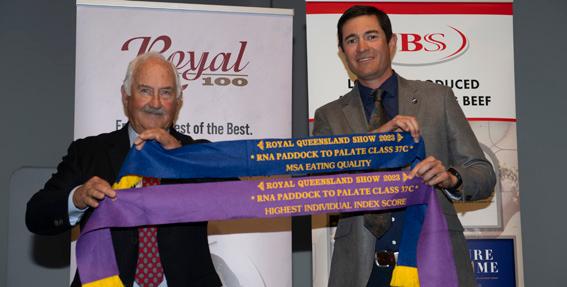
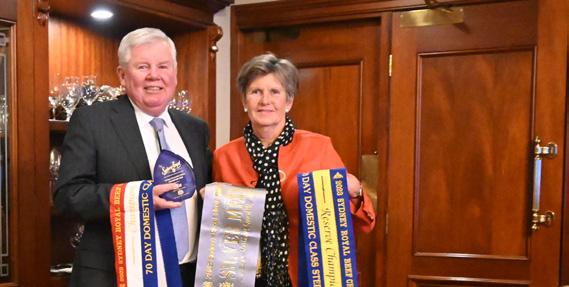
Daily Weight Gain:
1st Texas Angus, Angus Steer
3rd Millner Ag, Charolais x Angus Steer
Dressing %:
1st Texas Angus, Angus Steer
Feedlot Total:
1st Texas Angus, Angus Steer
Carcase Grid:
2nd Millner Ag, Charolais x Angus Steer
Carcase Judge:
Equal 3rd Millner Ag, Charolais x
Angus Steer
Equal 3rd Millner Ag, Charolais x Angus Steer
Profitability:
1st Texas Angus, Angus Steer
2nd Millner Ag Charolais x Angus Steer
Eating Quality:
3rd Millner Ag
Domestic Results – Teams
Champion Team: Millner Ag, Charolais x Angus Steers
Reserve Champion Team: PA & LM Weal, Charolais x Angus Steers
Feedlot Total:
1st Millner Ag, Charolais x Angus Steers
2nd PA & LM Weal, Charolais x Angus Steers
Carcase Grid:
1st AV & LM Doolan, Angus Heifers
Profitability:
1st Millner Ag, Charolais x Angus Steers
2nd PA & LM Weal, Charolais x Angus Steers
Eating Quality:
1st AV & LM Doolan, Angus Heifers
2nd Millner Ag, Charolais x Angus Steers
3rd PA & LM Weal, Charolais x Angus Steers
Domestic Results Individual
Reserve Champion Individual: PA & LM
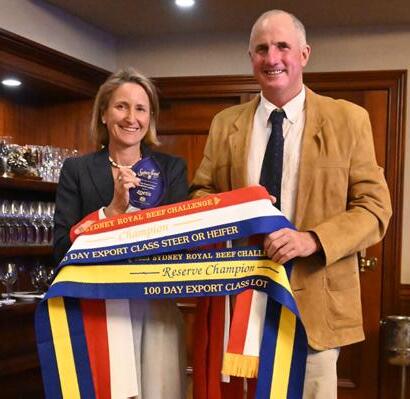
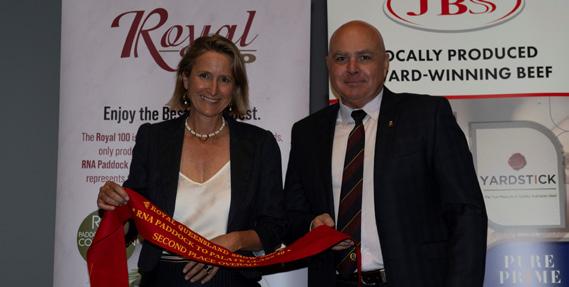
Weal, Charolais x Angus Steers
Daily Weight Gain:
1st Texas Angus, Angus Steer
2nd AV & LM Doolan, Angus Heifer
3rd Texas Angus, Angus Heifer
Dressing %:
1st PA & LM Weal, Charolais x Angus Steer
3rd PA & LM Weal, Charolais x Angus
Heifer
Feedlot Total:
2nd AV & LM Doolan, Angus Steer
Carcase Judge:
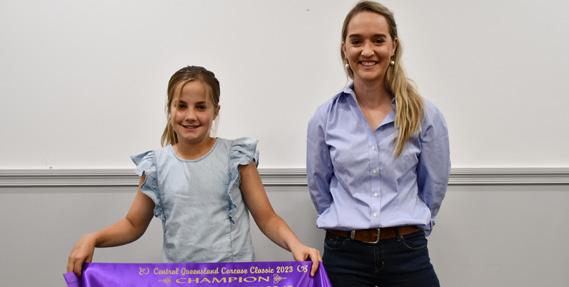
2nd Texas Angus, Angus Steer
Equal 3rd AV & LM Doolan, Angus Heifer
Equal 3rd MM Pastoral, Charolais x Angus Steer
Equal 3rd Texas Angus, Angus Heifer
Profitability:
2nd PA & LM Weal, Charolais x Angus Steer
2nd Millner Ag Charolais x Angus Steer
Eating Quality:
1st Millner Ag Charolais x Angus Steer
2nd AV & LM Doolan, Angus Heifer
3rd AV & LM Doolan, Angus Heifer
| 63 The Angus Bulletin - Spring 2023
Sissy Ward of Namgooyah Grazing Co, a, with sponsor Kathleen Currie, Elance Australia Pty Ltd Mick and Jenny Millner
Don McCrae
Wendy Mayne (Texas Angus) and Brad James, Rabobank
Ben & Wendy Mayne, Texas Angus
Adelaide carcase success
Diana Wood Marketing & Communications Manager
Angus influenced steers rose to the top when the major awards were announced in the Royal Adelaide Show led steers competition.

A Simmental cross Angus steer, exhibited by Lancaster Simmentals took out the coveted prize of Grand Champion Carcase after winning Champion Crossbred Carcase and Champion Crossbred Export Carcase. The steer had a liveweight of 614kg, an eye muscle area of 117 cmsq, P8 fat of 13mm and rib fat of 12mm.
An Angus cross Simmental steer, exhibited by Urrbrae Agricultural High School won Reserve Champion Cross Bred Heavy Domestic Carcase, while an Angus cross Limousin steer, exhibited by the Mount Compass Area School won Champion Crossbred Heavy Domestic Carcase.
RESULTS
Class 4: Purebred Export 300.1 –330kf HSCW
2nd – Goolagong, Angus
Class 7: School Heavy Domestic 250.1 –280kg HSCW
1st – Unity College, Angus
Class 8: School Heavy Domestic 280.1kg –300kg HSCW
2nd – Loxton High School, Angus
Class 10: School Export 330.1 & Greater HSCW
3rd – Naracoorte High School, Angus
Class 12: Crossbred Heavy Domestic 250.1 – 280kg HSCW
1st – Urrbrae Agricultural High School, Angus x Simmental
3rd – Miller Pastoral, Angus Cross
Class 13: Crossbred Heavy Domestic 280.1300kg HSCW
1st – Mount Compass Area School, Angus x Limousin

2nd – Heath Nickolls, Angus x Charolais
Class 15: Crossbred Export 330.1 & greater HSCW
1st – Lancaster Simmentals, Simmental x Angus

Heavy Domestic Eating Quality Carcase
1st – HB Rural Angus Cross
2nd – Gladstone High School, Angus
Export Eating Quality Carcase
2nd – Scotch College, Angus
Champion Crossbred Heavy Domestic on Hoof - Heath Nickolls, Angus x Charolais
Reserve Champion Crossbred Export Steer on Hook, Tom & Lizzy Baker, SimAngus
Reserve Champion Cross Bred Heavy
Apostle: Sire: Paratrooper NMMP15

Dam: Abigail NMMN162
Hoshiya Na Stud
Armidale
offering three bulls for sale POA Enquiries and inspection welcome Ph: 0429951816 Email: piptout@gmail.com
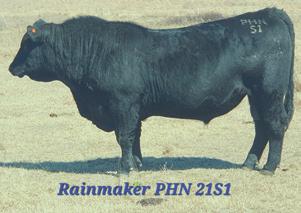

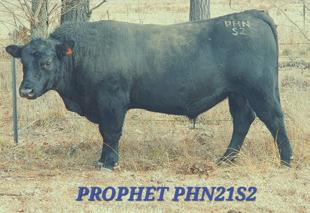
Rainmaker
Sire: Nugget NMMN266
Dam: Flower NMMN30
Prophet
Sire: TFAN106
Dam: Prue NMMP95
Jack Thomas, Thomas Foods International, with Lancaster Simmentals' Lizzy and Prue Cartledge, who exhibited the grand champion steer on-hook. Image: Stock Journal
Around the Shows
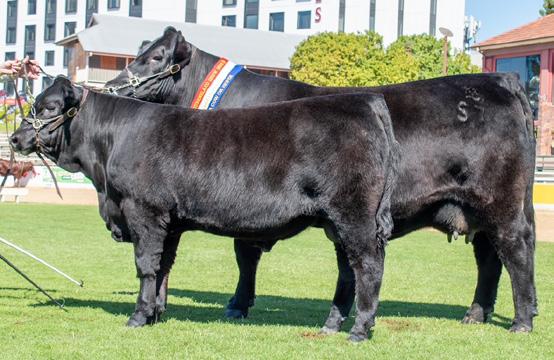





| 65 The Angus Bulletin - Spring 2023
ADELAIDE 2023 - A: Champion Interbreed Sire’s Progeny Group, exhibited by Nampara Angus, B: Junior & Grand Champion Angus Bull & Supreme Angus Exhibit, All Breed Grand Champion Pair & All Breed Junior Champion Pair: PC Top Prize T048, exhibited by Pine Creek Angus Stud, C: Senior & Grand Champion Angus Female & All Breed Grand Champion Pair: DSK Pep Martina R77, exhibited by Diamond Angus, D: All Breed Junior Champion Pair: PC Top Prize T048, exhibited by Pine Creek Angus Stud & Diamond MS Just Teasen T422, exhibited by Diamond Angus. Image: Stock Journal
A D B E C F
EKKA 2023 - E: Grand Champion Angus Bull: K5X Design S7, exhibited by SB Hayward & KL Smith, F: Grand Champion Angus Female: K5X Satellite S166, exhibited by SB Hayward & KL Smith. Adelaide Photos: Mavstar Photography
ANGUS VERIFIED

NVDS & GUIDELINES



BLACK ANGUS CATTLE ASSESSMENT GUIDELINES













Straight black hided Presenting Angus characteristics
Small amount of white underline (not visible from the front of the animal)
No white legs, feet or tail · No horns or dehorning buds · Scurs accepted, not fixed to the skull No bos indicus or dairy characteristics

 Angus x Angus
Angus x Angus
AA x AA
Example of ACCEPTABLE Breed Description
Angus cross Angus Angus
OAKEY B EEFEXPORT S
Staff Directory
Chief Executive Officer
Scott Wright, Chief Executive Officer
P: 02 6773 4636 · E: scott.wright@angusaustralia.com.au · 0428 221 008
Genetic Improvement
Christian Duff, General Manager Genetic Improvement & Research Manager
P: 02 6773 4620 · M: 0457 457 141
E: christian@angusaustralia.com.au
Liam Mowbray, Research and Development Specialist
P: 02 6773 4603
E: liam.mowbray@angusaustralia.com.au
Malshani Samaraweera, Geneticist
P: 02 6773 4622
E: malshani@angusaustralia.com.au
Marketplace Services
Liz Pearson, Commercial Supply Chain Manager
P: 02 6773 4608 · M: 0488 758 360
E: liz.pearson@angusaustralia.com.au
Diana Wood, Marketing & Communications Manager
P: 02 6773 4601 · E: diana@angusaustralia.com.au
Robyn Brazier, Marketing Assistant
P: 02 6773 4609 · E: marketing@angusaustralia.com.au
Ebonie Jones, Graphic Designer
P: 02 6773 4610 · E: ebonie@angusaustralia.com.au
Kate Reynolds, Graphics & Multimedia Officer
P: 02 6773 4645 · E: kate.reynolds@angusaustralia.com.au
Nick Butcher, Project Officer, ASBP
P: 02 6773 4638 · M: 0427 701 236
E: nick@angusaustralia.com.au
Jen Peart, Acting Genetic Improvement Specialist
P: 02 6773 4644 · M: 0417 219 405
E: jen.peart@angusaustralia.com.au
Cheyne Twist, Senior Marketing & Communications Officer
P: 02 6773 4635 · E: communications@angusaustralia.com.au
Samantha Hamilton, Marketing Officer – Sale Catalogues
P: 02 6773 4613 · E: sam@angusaustralia.com.au
Dzintra Menesis, Marketing Officer - Graphic Design
P: 02 6773 4656 · E: dzintra.menesis@angusaustralia.com.au
Heather Rocks, Marketing Officer
P: 02 6773 4621 · E: heather.rocks@angusaustralia.com.au
| 67 The Angus Bulletin - Spring 2023
office@angusaustralia.com.au | (02) 6773 4600 | Angus Australia Locked Bag 11, Armidale NSW 2350 www.angusaustralia.com.au
Staff Directory
Member Engagement
Jake Phillips, Extension and Youth Manager
P: 02 6773 4625 · M: 0401 261 217
E: jake.phillips@angusaustralia.com.au
Adam Allingham, Acting Member Services Manager
P: 02 6773 4602 · E: adam.allingham@angusaustralia.com.au
Katie Carlon, Member Services Officer
P: 02 6773 4618 · E: katie.carlon@angusaustralia.com.au
Rachael Constable, Member Services Officer
P: 02 6773 4615 · E: rachael.constable@angusaustralia.com.au
Raelene Mold, Member Services Officer
P: 02 6773 4605 · E: raelene.mold@angusaustralia.com.au
Lou Wood, Member Services Officer
P: 02 6773 4617 · E: office@angusaustralia.com.au
Nicky Wallace, World Angus Forum Coordinator
P: 02 6773 4616 · E: nicky.wallace@angusaustralia.com.au
Corporate Services
Elliott Connors, Accountant
P: 02 6773 4624 · E: Elliott.Connors@angusaustralia.com.au
Joy Howe, Accounts Officer
P: 02 6773 4612 · E: joy.howe@angusaustralia.com.au
Susan Webeck, Accounts Officer
P: 02 6773 4606 · E: sue@angusaustralia.com.au
Nancy Crawshaw, Extension Officer
P: 02 6773 4643 · M: 043 633 7652
E: nancy.crawshaw@angusaustralia.com.au
Tammy McLeod, Senior Member Services Officer
P: 02 6773 4604 · E: tammy.mcleod@angusaustralia.com.au
Lily Christian, Member Services Officer
P: 02 5775 8710 · E: lily.christian@angusaustralia.com.au
Robyn Kelly, Member Services Officer
P: 02 6773 4615 · E: robyn@angusaustralia.com.au
Sarah Scott, Member Services Officer
P: 02 6773 4611 · E: sarah.scott@angusaustralia.com.au
Kathryn Duddy, Company Secretary, Human Resources Manager and Assistant to the Ceo
P: 02 6773 4614 · E: kathryn.duddy@angusaustralia.com.au
M: 0447 332 202
Christopher de Crespigny, Information Systems Manager
P: 02 6773 4619 · E: christopher@angusaustralia.com.au
Dale Curtis, Computer Programmer
E: dale.curtis@angusaustralia.com.au
Carole Johns, Accounts Officer
P: 02 6773 4628 · E: carole.johns@angusaustralia.com.au
Amanda Wolfe, Administration Officer
P: 02 6773 4650 · E: amanda@angusaustralia.com.au
Dr Gerard Hammond, angus.tech Software Manager
E: gerard.hammond@angusaustralia.com.au
Chris Hocking, Computer Programmer
E: chris.hocking@angusaustralia.com.au
68
office@angusaustralia.com.au | (02) 6773 4600 | Angus Australia Locked Bag 11, Armidale NSW 2350 www.angusaustralia.com.au
INTERNATIONAL
ANGUS
YOUTH COMPETITION
WELCOME FUNCTION IN SYDNEY
Renowned for its stunning harbour setting, temperate climate, and world class restaurants
PRE TOUR SYDNEY TO BRISBANE
An unforgettable adventure that unveils the vast and diverse landscapes of this extraordinary continent, with a variety of experiences including visits to Angus properties and local attractions.
ANGUS EXPO IN TAMWORTH

The largest gathering of Angus cattle in Australia


TECH FORUM IN BRISBANE
A modern, dynamic and vibrant city with direct access to Australia’s top tourist attractions, with a stunning riverfront and a world-class dining scene



POST TOUR - QUEENSLAND
Renowned for its beef industry and vast picturesque landscapes
With Angus Youth teams from around the world competing throughout the forum to be crowned the champions of the Angus world www.worldangusforum2025.com
7 - 8
25 #WAFdownunder
MAY
us for the 2025
Join
WORLD ANGUS FORUM IN AUSTRALIA!





60 Bulls plus 6 Elite HBR Registered Heifers Thurs November 23rd, 11am AWST at Boyanup Saleyards, Boyanup WA and Livestream on BLOODLINES INCLUDE Realist - Fair N Square - Fully Loaded - Paratrooper Quixote - William of Stern - Stunner - Checkmate Contact for catalogue gandyangus.com.au | Kim Gandy 0428 761 348 ESTABLISHED 1986








































































 Cheyne Twist, Senior Marketing & Communications Officer
Cheyne Twist, Senior Marketing & Communications Officer



















 Cheyne Twist, Senior Marketing and Communications Manager
Cheyne Twist, Senior Marketing and Communications Manager






















































 Cheyne Twist, Senior Marketing & Communications Officer
Cheyne Twist, Senior Marketing & Communications Officer
















 Cheyne Twist, Senior Marketing & Communications Officer
Cheyne Twist, Senior Marketing & Communications Officer




 Cheyne Twist, Senior Marketing & Communications Officer
Cheyne Twist, Senior Marketing & Communications Officer




































































































































































 Angus x Angus
Angus x Angus









